Paul van Yperen's Blog, page 80
July 21, 2023
Unione Cinematografica Italiana - UCI
In 1919, the producers Barattolo and Fassini of Caesar Film and Cines realised a fusion of most of the existing Italian film companies. The two wanted to secure the Italians a better international position. The main pre-war companies like Ambrosio, Itala and Gloria merged in the UCI - Unione Cinematografica Italiana. The Roman initiative to counter the Americans and Germans failed by a lack of funding, production facilities and artistic renewal. The bankruptcy of the Banca di Sconto in 1921 didn't help for sure. UCI was mainly a distribution company, not a production company. In 1926 it went into bankruptcy. UCI's malfortune and final demise also marginalised Italian silent film production. The remains of the Unione Cinematografica Italiana were taken over by producer Stefano Pittaluga.
10 Stars
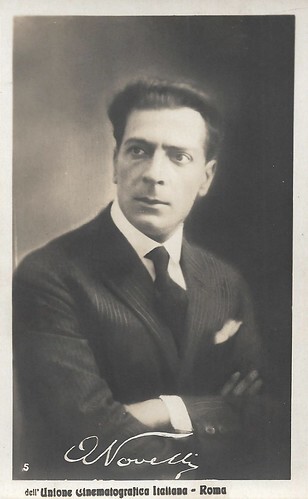
Italian postcard by La Rotofotografica / Unione Cinematografica Italiana, no. 5. Amleto Novelli .
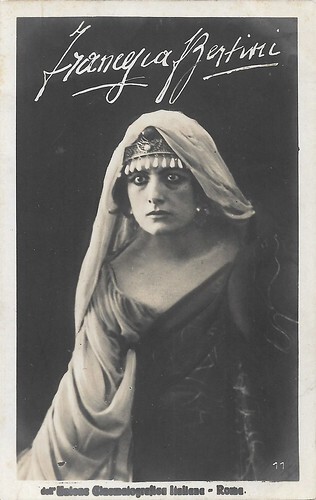
Italian postcard by La Rotofotografica / Unione Cinematografica Italiana, no. 11. Francesca Bertini .
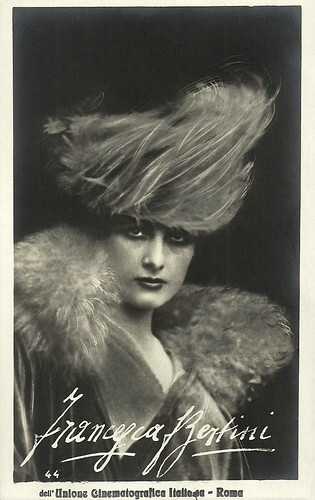
Italian postcard by La Rotofotografica / Unione Cinematografica Italiana, no. 44. Francesca Bertini .
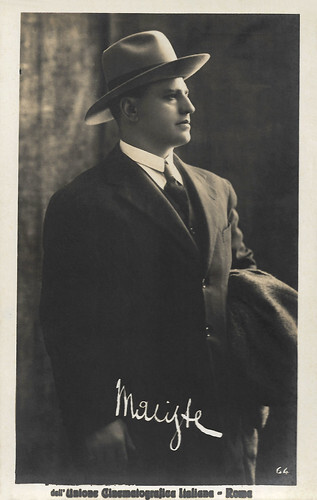
Italian postcard by La Rotofotografica / Unione Cinematografica Italiana, no. 64. Bartolomeo Pagano a.k.a. Maciste .
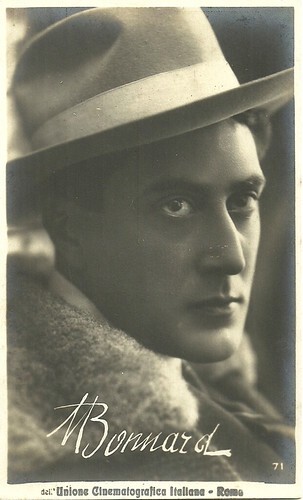
Italian postcard by La Rotofotografica / Unione Cinematografica Italiana, no. 71. Mario Bonnard .
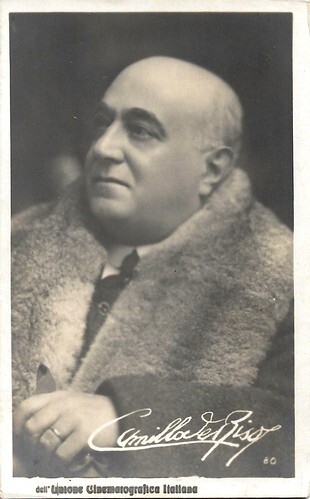
Italian postcard by La Rotofotografica / Unione Cinematografica Italiana, no. 80. Camillo De Riso .
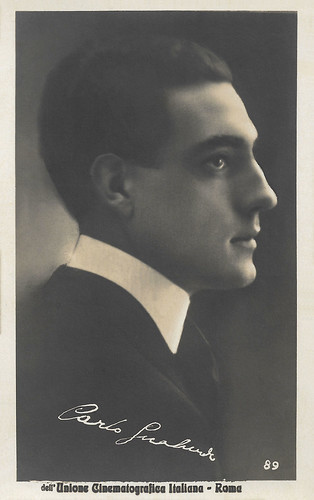
Italian postcard by Fotocelere, no. 89. Photo: Unione Cinematografia Italiana, Roma. Carlo Gualandri.
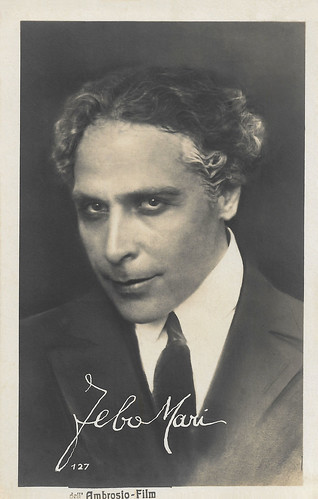
Italian postcard by Fotocelere, no. 127. Photo: Unione Cinematografia Italiana, Roma / Ambrosio Film. Febo Mari.
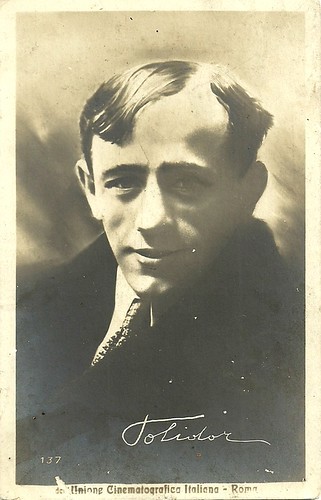
Italian postcard by La Rotofotografica / Unione Cinematografica Italiana, no. 137. Ferdinand Guillaume a.k.a. Tontolini and Polidor.

Italian postcard by Unione Cinematografica Italiana, Roma, no. 164. Collection: Marlene Pilaete. Lucy di San Germano a.k.a. Lucy Sangermano .
10 Films
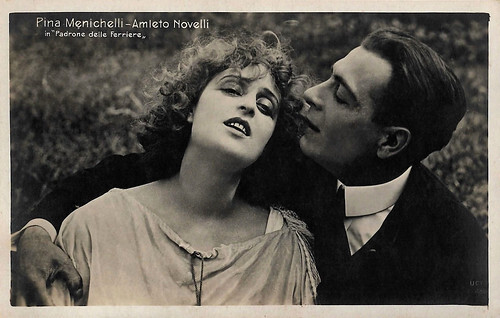
Italian postcard by G. Vettori, Bologna. Photo: Unione Cinematografica Italiana. Amleto Novelli and Pina Menichelli in Il padrone delle ferriere/The Master of the Ironworks (Eugenio Perego, 1919), based on 'Le maitre des forges' by Georges Ohnet.
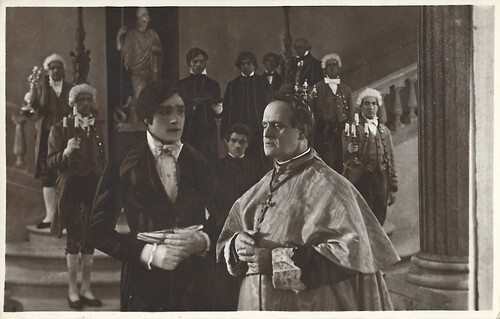
Italian postcard. Photo: Unione Cinemagrafica Italiana / Medusa Film. Carlo Gualandri in Saracinesca (Gaston Ravel, 1921), based on the novel by Frances Marion Crawford. Caption: The day he hears that the young Prince Saracinesca wants to marry Donna Tullia Mayer, the cardinal doesn't hide his disapproval.

Italian postcard by Unione Cinematografica Italiana, series Teodora, no. 6. Photo: Ambrosio Film. Rita Jolivet in Teodora/Theodora (Leopoldo Carlucci, 1921). Caption: Searching for her lovers, Teodora descends to the lowest quarters of the city.
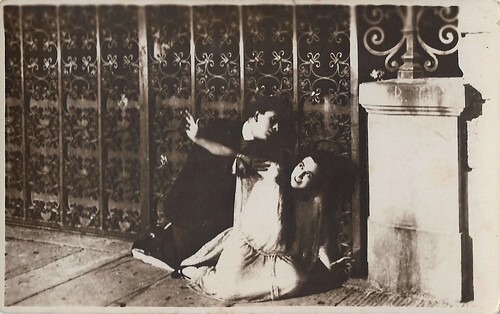
Italian postcard by G.B. Falci, Milano. Photo: Unione Cinematografica Italiana. Maria Carmi and Ettore Piergiovanni as Isabella Inghirami and Paolo Tarsis in the Italian silent film Forse che sí, forse che no (Gaston Ravel, 1921), based on Gabriele d'Annunzio 's eponymous novel (1910). The maddened Isabella does not understand Paolo's pleas anymore.
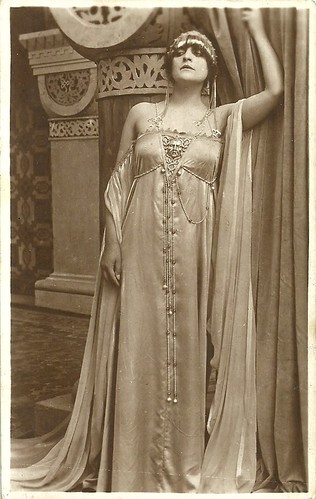
Italian postcard. Photo: Pasquali / Unione Cinematografica Italiana. Antonietta Calderari as Imperia in Il ponte dei sospiri/The Bridge of Sighs (Domenico Gaido, 1921). Caption: The most beautiful Imperia, empress of the courtesans.
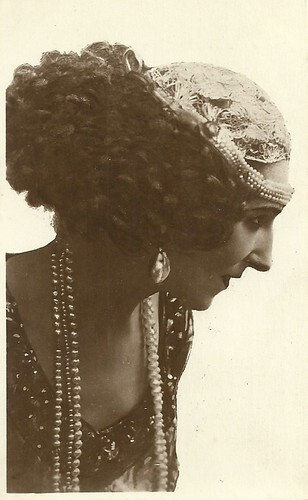
Italian postcard. Photo: Unione Cinematografica Italiana / Ambrosio-Zanotta. Ida Rubinstein in La nave/The Ship (Gabriellino D'Annunzio, Mario Roncoroni, 1921), based on the play by Gabriele D'Annunzio .
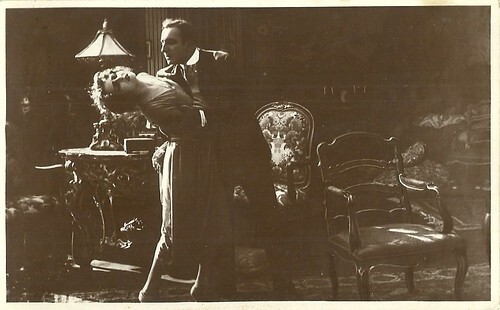
Italian postcard. Photo: Medusa Film / Unione Cinematografia Italiana (UCI). Helena (Elena) Makowska and Guido Trento in Idillio tragico (Gaston Ravel, 1922), based on a novel by Paul Bourget. Caption: Ely rejects Oliviero, as she has now fallen in love with Pietro di Hautefeuille.
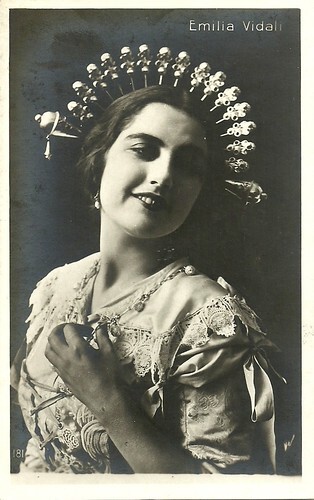
Italian postcard by G. Vettori, Bologna, no. 181. Photo: Unione Cinematografia Italiana (UCI). Emilia Vidali as Lucia in I promessi sposi/The Bethrothed (Mario Bonnard, 1922), based on the novel by Alessandro Manzoni.
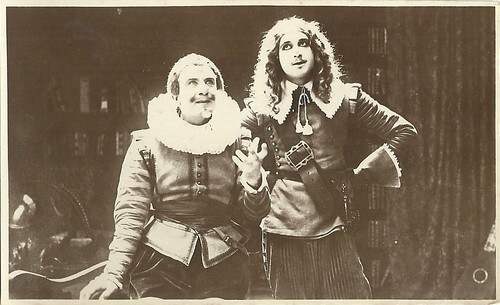
Italian postcard. Photo: Unione Cinematografia Italiana (UCI). Pierre Magnier as Cyrano de Bergerac and Angelo Ferrari as Christian de Neuvillette in the Franco-Italian historical film Cirano di Bergerac (Augusto Genina, 1923), based on Edmond Rostand's famous play 'Cyrano de Bergerac'. Caption: Cyrano addresses to Roxane his most ardent words of love by the lips of Christian, who, incapable to invent such words, memorizes them thanks to Cyrano.

Italian postcard by Ed. L'Argentografica, Turin, no. 3055. Photo: Unione Cinematografia Italiana (UCI). Alfons Fryland as Vinicius and Lilian Hall-Davis as Licia / Lygia at Nero's banquet in Quo vadis? (Gabriellino D'Annunzio, Georg Jacoby, 1924), based on the classic novel by Henryk Sienkiewicz.
Sources: Giorgio Bertellini (Italian Silent Cinema: A Reader), Wikipedia (English and Italian) and IMDb.
10 Stars

Italian postcard by La Rotofotografica / Unione Cinematografica Italiana, no. 5. Amleto Novelli .

Italian postcard by La Rotofotografica / Unione Cinematografica Italiana, no. 11. Francesca Bertini .

Italian postcard by La Rotofotografica / Unione Cinematografica Italiana, no. 44. Francesca Bertini .

Italian postcard by La Rotofotografica / Unione Cinematografica Italiana, no. 64. Bartolomeo Pagano a.k.a. Maciste .

Italian postcard by La Rotofotografica / Unione Cinematografica Italiana, no. 71. Mario Bonnard .

Italian postcard by La Rotofotografica / Unione Cinematografica Italiana, no. 80. Camillo De Riso .

Italian postcard by Fotocelere, no. 89. Photo: Unione Cinematografia Italiana, Roma. Carlo Gualandri.

Italian postcard by Fotocelere, no. 127. Photo: Unione Cinematografia Italiana, Roma / Ambrosio Film. Febo Mari.

Italian postcard by La Rotofotografica / Unione Cinematografica Italiana, no. 137. Ferdinand Guillaume a.k.a. Tontolini and Polidor.

Italian postcard by Unione Cinematografica Italiana, Roma, no. 164. Collection: Marlene Pilaete. Lucy di San Germano a.k.a. Lucy Sangermano .
10 Films

Italian postcard by G. Vettori, Bologna. Photo: Unione Cinematografica Italiana. Amleto Novelli and Pina Menichelli in Il padrone delle ferriere/The Master of the Ironworks (Eugenio Perego, 1919), based on 'Le maitre des forges' by Georges Ohnet.

Italian postcard. Photo: Unione Cinemagrafica Italiana / Medusa Film. Carlo Gualandri in Saracinesca (Gaston Ravel, 1921), based on the novel by Frances Marion Crawford. Caption: The day he hears that the young Prince Saracinesca wants to marry Donna Tullia Mayer, the cardinal doesn't hide his disapproval.

Italian postcard by Unione Cinematografica Italiana, series Teodora, no. 6. Photo: Ambrosio Film. Rita Jolivet in Teodora/Theodora (Leopoldo Carlucci, 1921). Caption: Searching for her lovers, Teodora descends to the lowest quarters of the city.

Italian postcard by G.B. Falci, Milano. Photo: Unione Cinematografica Italiana. Maria Carmi and Ettore Piergiovanni as Isabella Inghirami and Paolo Tarsis in the Italian silent film Forse che sí, forse che no (Gaston Ravel, 1921), based on Gabriele d'Annunzio 's eponymous novel (1910). The maddened Isabella does not understand Paolo's pleas anymore.

Italian postcard. Photo: Pasquali / Unione Cinematografica Italiana. Antonietta Calderari as Imperia in Il ponte dei sospiri/The Bridge of Sighs (Domenico Gaido, 1921). Caption: The most beautiful Imperia, empress of the courtesans.

Italian postcard. Photo: Unione Cinematografica Italiana / Ambrosio-Zanotta. Ida Rubinstein in La nave/The Ship (Gabriellino D'Annunzio, Mario Roncoroni, 1921), based on the play by Gabriele D'Annunzio .

Italian postcard. Photo: Medusa Film / Unione Cinematografia Italiana (UCI). Helena (Elena) Makowska and Guido Trento in Idillio tragico (Gaston Ravel, 1922), based on a novel by Paul Bourget. Caption: Ely rejects Oliviero, as she has now fallen in love with Pietro di Hautefeuille.

Italian postcard by G. Vettori, Bologna, no. 181. Photo: Unione Cinematografia Italiana (UCI). Emilia Vidali as Lucia in I promessi sposi/The Bethrothed (Mario Bonnard, 1922), based on the novel by Alessandro Manzoni.

Italian postcard. Photo: Unione Cinematografia Italiana (UCI). Pierre Magnier as Cyrano de Bergerac and Angelo Ferrari as Christian de Neuvillette in the Franco-Italian historical film Cirano di Bergerac (Augusto Genina, 1923), based on Edmond Rostand's famous play 'Cyrano de Bergerac'. Caption: Cyrano addresses to Roxane his most ardent words of love by the lips of Christian, who, incapable to invent such words, memorizes them thanks to Cyrano.

Italian postcard by Ed. L'Argentografica, Turin, no. 3055. Photo: Unione Cinematografia Italiana (UCI). Alfons Fryland as Vinicius and Lilian Hall-Davis as Licia / Lygia at Nero's banquet in Quo vadis? (Gabriellino D'Annunzio, Georg Jacoby, 1924), based on the classic novel by Henryk Sienkiewicz.
Sources: Giorgio Bertellini (Italian Silent Cinema: A Reader), Wikipedia (English and Italian) and IMDb.
Published on July 21, 2023 22:00
July 20, 2023
José Ferrer
José Ferrer (1912- 1992) was an American actor and film director, who was born in Puerto Rico. After a highly successful Broadway career, he won the Academy Award for Best Actor in a Leading Role for his title role in Cyrano de Bergerac (1951) and was the first Hispanic actor to win an Oscar. His other notable film roles include Charles VII in Joan of Arc (1948), Henri de Toulouse-Lautrec in Moulin Rouge (1952), defence attorney Barney Greenwald in The Caine Mutiny (1954), Alfred Dreyfus in I Accuse! (1958), which he also directed, and the Turkish Bey in Lawrence of Arabia (1962). In his later film career, Ferrer was frequently used as a villain.
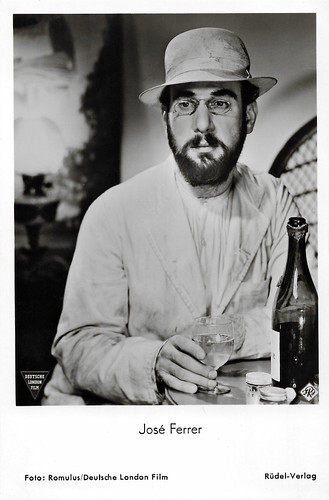
West German postcard by Rüdel Verlag, Hamburg Bergedorf, no. 654. Photo: Romulus / Deutsche London Film. José Ferrer in Moulin Rouge (John Huston, 1952).
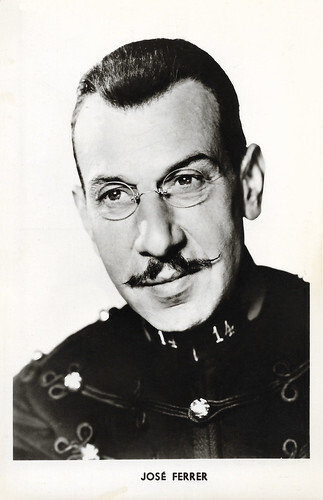
Belgian postcard, no. 5464. José Ferrer in I Accuse! (José Ferrer, 1958).
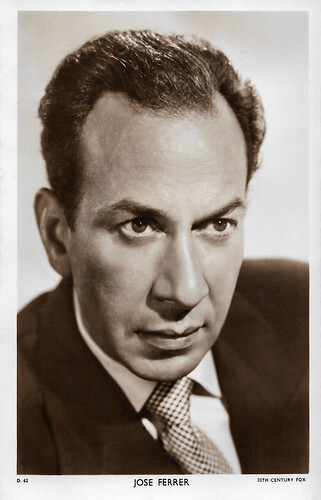
British postcard in the Picturegoer Series, London, no. D. 62. Photo: 20th Century Fox.
A major success on Broadway
José Ferrer was born José Vicente Ferrer de Otero y Cintrón in San Juan, the capital city of Puerto Rico in 1912. Ferrer's father was Rafael Ferrer, a lawyer, landowner and author who was born and raised in San Juan. Ferrer's mother was María Providencia Cintrón, a native of the coastal town of Yabucoa. Ferrer's paternal grandfather was Dr. Gabriel Ferrer Hernández, who had campaigned for Puerto Rican independence from the Spanish Empire.
The Ferrer family moved to New York City in 1914, when José was 2 years old. As a school student, Ferrer was educated abroad at the Institut Le Rosey, a prestigious boarding school located in Rolle, Switzerland. According to the wishes of his father, José should become a concert pianist. Ferrer studied architecture, music and composition at Princeton University. He wrote a dissertation called 'French Naturalism and Pardo Bazán', about the Spanish naturalist writer Emilia Pardo Bazán. In 1934, Ferrer transferred to Columbia University, where he studied Roman languages.
In 1934, while still a college student, Ferrer made his theatrical debut in Long Island-based theatre. In 1935, he was hired as the stage manager at the Suffern Country Playhouse. Later in 1935, Ferrer made his Broadway debut in the comedy play 'A Slight Case of Murder' by Damon Runyon and Howard Lindsay. Ferrer had a major success on Broadway in the play 'Brother Rat' by John Monks Jr. and Fred F. Finklehoffe. The play ran 577 performances from 1936 to 1938. Very successful were also 'Mamba's Daughters (1938) and 'Charley's Aunt' (1940).
Even more successful was the 1943 play 'Othello' in which he co-starred as the villainous Iago opposite the Othello of Paul Robeson . 'Othello' was the longest-played Shakespeare play in the United States. The record remains unbroken to this day. In 1946, Ferrer starred in 'Cyrano de Bergerac', his most successful play. He won a Tony Award for his performance.
In 1948, Ferrer made his film debut by co-starring with Ingrid Bergman in Joan of Arc (Victor Fleming, 1948). He played the historical monarch Charles VII of France, the ruler who Joan of Arc served during the Hundred Years' War. For his debut role, Ferrer was nominated for an Oscar for Best Male Supporting Actor. Ferrer's success as a film actor, helped him gain more film roles in Hollywood-produced films. He played the smooth-talking hypnotist David Korvo in the Film Noir Whirlpool (Otto Preminger, 1949) with Gene Tierney , and dictator Raoul Farrago in the Film Noir Crisis (Richard Brooks, 1950) starring Cary Grant . In 1950, Ferrer won an Oscar for Best Actor for his role as Cyrano de Bergerac in the film version, Cyrano de Bergerac (Michael Gordon, 1950). He was the first Puerto Rican actor and also the first Hispanic actor to win an Academy Award.
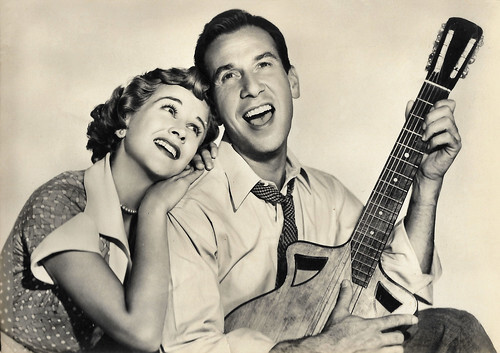
Italian postcard by Rotalfoto, Milano. Photo: Paramount. Kim Hunter and José Ferrer in Anything Can Happen (George Seaton, 1952).
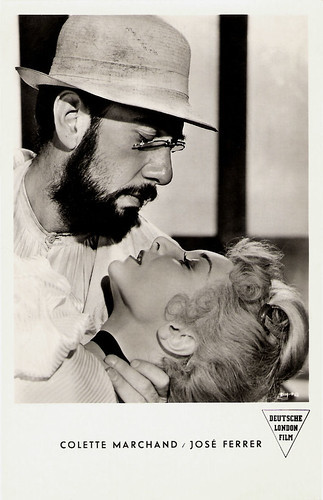
German postcard. Photo: Deutsche London Film. José Ferrer and Colette Marchand in Moulin Rouge (John Huston, 1952).
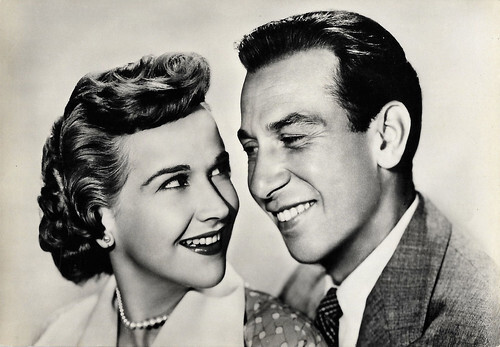
Italian postcard by Rotalfoto, Milano. Photo: Paramount. Kim Hunter and José Ferrer in Anything Can Happen (George Seaton, 1952).
Moulin Rouge
In 1952, José Ferrer won three Tony Awards for directing three plays, namely 'The Shrike', 'Stalag 17' and 'The Fourposter' and he won another Tony for acting in 'The Shrike'. That year, Ferrer also played the French painter Henri de Toulouse-Lautrec in the historical drama Moulin Rouge (John Huston, 1952). His role earned him an Oscar nomination, but the award was instead won by Gary Cooper . The film also marked a financial success for Ferrer, who received 40% of the film's profits.
In 1954, Ferrer took on the role of defence attorney Barney Greenwald in The Caine Mutiny (Edward Dmytryk, 1954) opposite Humphrey Bogart . The film was a huge hit. Also popular was Deep in My Heart (Stanley Donen, 1955) about the life of operetta composer Sigmund Romberg (Ferrer), which made a profit of over $1 million.
From 1955 onwards, Ferrer also directed a number of films, most of which he also starred in as an actor. First, he directed a film version of The Shrike (José Ferrer, 1955), in which he also starred opposite June Allyson. He went to England to star in and direct a war film for Warwick Productions, The Cockleshell Heroes (1955), alongside Trevor Howard . It was a success at the British box office. For MGM, he directed and starred in two films, I Accuse! (José Ferrer, 1958), a reimagining of the Dreyfus Affair, in which he played Captain Alfred Dreyfus, and The High Cost of Loving (José Ferrer, 1958) a comedy with Gena Rowlands.
While still critically well-received, several of his films were box office flops. He took a hiatus from film productions. In 1959, he directed a play called 'The Andersonville Trial', about the consequences of the American Civil War. The play featured George C. Scott. He then took over directing the musical 'Juno'. After sixteen performances, the musical stopped due to a lack of success, which was a setback for Ferrer's directing career.
Ferrer attempted a comeback as a film director with the sequel film Return to Peyton Place (José Ferrer, 1961) and the musical film State Fair (José Ferrer, 1962). Both films were again box office flops. As an actor, Ferrer appeared as a Turkish Bey in the historical drama Lawrence of Arabia (David Lean, 1962) with Peter O'Toole , as historical monarch Herod Antipas, Tetrarch of Galilee and Perea in the Bible epic The Greatest Story Ever Told (1965) and as one of the doomed passengers in Ship of Fools (Stanley Kramer, 1965). The latter film was nominated for eight Academy Awards in 1966.
In between, Ferrer went to Germany to make Verspätung in Marienborn/Stop Train 349 (Rolf Hädrich, 1963) with Sean Flynn. He then appeared opposite Jean-Pierre Cassel in the French film Cyrano et d'Artagnan/Cyrano and d'Artagnan (1964) directed by Abel Gance . In television, Ferrer was the narrator in the pilot episode of the hit sitcom Bewitched (1964), which he narrated in a mock documentary style. In 1968, he featured as a voice actor, playing the villain Ben Haramed in the stop-motion television special The Little Drummer Boy (Jules Bass, Arthur Rankin Jnr., 1968). But at this time, he started having legal troubles. The Internal Revenue Service (IRS) accused Ferrer of still owing unpaid taxes since 1962.
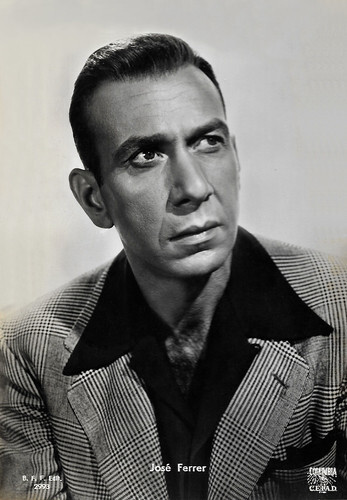
Italian postcard by B.F.F. Edit. (Casa Editr. Ballerini & Fratini, Firenze), no. 2993. Photo: Universal C.E.I.A.D.
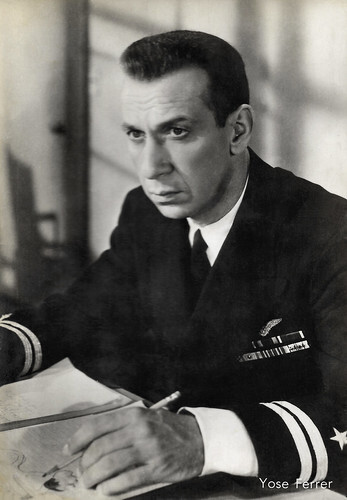
Italian postcard by Bromostampa, Milano, no. 71. José Ferrer in The Caine Mutiny (Edward Dmytryk, 1954).
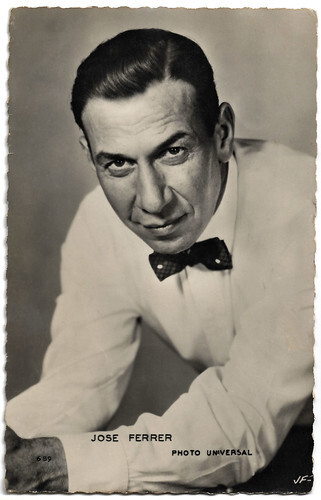
French postcard by Editions P.I., Paris, no. 689. Photo: Universal.
No outstanding highlights
José Ferrer had many film roles in the 1970s, but no outstanding highlights. He played one of the many passengers in Voyage of the Damned (Stuart Rosenberg, 1976) with Faye Dunaway , Doctor Vando in Fedora (Billy Wilder, 1978) with William Holden and Marthe Keller , and musketeer Athos in The Fifth Musketeer (Ken Annakin, 1979), starring Beau Bridges and Sylvia Kristel .
In the 1980s, he starred in the popular comedy series Newhart as Julia Duffy's father, and he also played the role of Reuben Marino in the soap opera Another World. In the cinema, he appeared in A Midsummer Night's Sex Comedy (Woody Allen, 1982), To Be or Not to Be (Mel Brooks, 1983) and Dune (David Lynch, 1984), an adaptation of the 1965 novel 'Dune' by Frank Herbert. This was among the last notable roles of Ferrer's long career.
Ferred retired from acting entirely in 1991, due to increasing health problems. His last theatrical performance was a production of the generation-gap drama 'Conversations with My Father'. In 1992, José Ferrer died of colorectal cancer at the age of 80 in Coral Gables, Florida. He was buried in Santa Maria Magdalena de Pazzis Cemetery in Old San Juan in his native Puerto Rico.
José Ferrer, who spoke perfect French, Italian and German in addition to Spanish and English, was married a total of four times. His wives were Uta Hagen (1938-1948), actress Phyllis Hill (1948-1953) and the singer and actress Rosemary Clooney (1953-1961 / 1964-1967). From 1977 until his death, he was married to Stella Magee.
With Uta Hagen, he had a daughter. With Rosemary Clooney , he had five children born between 1955 and 1960. His oldest son, actor Miguel Ferrer (1955-2017) was known for his role in Medical Examiners. He was followed by Maria Ferrer (1956), Gabriel Ferrer (1957) who is married to singer Debby Boone, daughter of Pat Boone ; Monsita Ferrer (1958) and Rafael Ferrer (1960). Ferrer was the uncle of film star George Clooney .
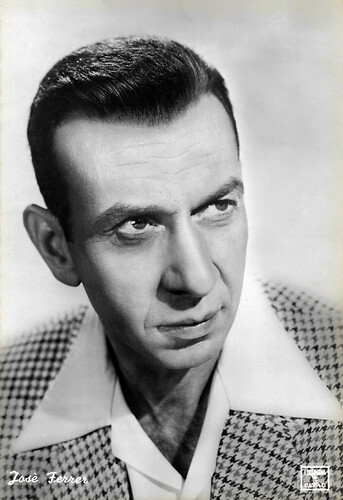
Italian postcard by Bromofoto, Milano, no. 953. Photo: Columbia C.E.I.A.D.
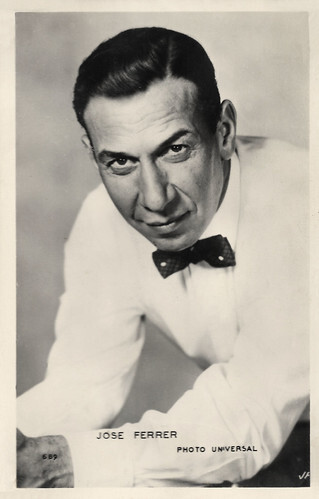
French postcard by Editions P.I., Paris, no. 689. Photo: Universal.
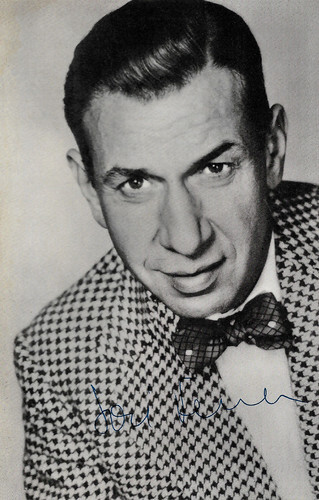
British postcard in the Celebrity Autograph Series, no. 248. Photo: Universal-International. José Ferrer in The Shrike (José Ferrer, 1955).
Sources: (IMDb), Wikipedia (English, German and Dutch) and .

West German postcard by Rüdel Verlag, Hamburg Bergedorf, no. 654. Photo: Romulus / Deutsche London Film. José Ferrer in Moulin Rouge (John Huston, 1952).

Belgian postcard, no. 5464. José Ferrer in I Accuse! (José Ferrer, 1958).

British postcard in the Picturegoer Series, London, no. D. 62. Photo: 20th Century Fox.
A major success on Broadway
José Ferrer was born José Vicente Ferrer de Otero y Cintrón in San Juan, the capital city of Puerto Rico in 1912. Ferrer's father was Rafael Ferrer, a lawyer, landowner and author who was born and raised in San Juan. Ferrer's mother was María Providencia Cintrón, a native of the coastal town of Yabucoa. Ferrer's paternal grandfather was Dr. Gabriel Ferrer Hernández, who had campaigned for Puerto Rican independence from the Spanish Empire.
The Ferrer family moved to New York City in 1914, when José was 2 years old. As a school student, Ferrer was educated abroad at the Institut Le Rosey, a prestigious boarding school located in Rolle, Switzerland. According to the wishes of his father, José should become a concert pianist. Ferrer studied architecture, music and composition at Princeton University. He wrote a dissertation called 'French Naturalism and Pardo Bazán', about the Spanish naturalist writer Emilia Pardo Bazán. In 1934, Ferrer transferred to Columbia University, where he studied Roman languages.
In 1934, while still a college student, Ferrer made his theatrical debut in Long Island-based theatre. In 1935, he was hired as the stage manager at the Suffern Country Playhouse. Later in 1935, Ferrer made his Broadway debut in the comedy play 'A Slight Case of Murder' by Damon Runyon and Howard Lindsay. Ferrer had a major success on Broadway in the play 'Brother Rat' by John Monks Jr. and Fred F. Finklehoffe. The play ran 577 performances from 1936 to 1938. Very successful were also 'Mamba's Daughters (1938) and 'Charley's Aunt' (1940).
Even more successful was the 1943 play 'Othello' in which he co-starred as the villainous Iago opposite the Othello of Paul Robeson . 'Othello' was the longest-played Shakespeare play in the United States. The record remains unbroken to this day. In 1946, Ferrer starred in 'Cyrano de Bergerac', his most successful play. He won a Tony Award for his performance.
In 1948, Ferrer made his film debut by co-starring with Ingrid Bergman in Joan of Arc (Victor Fleming, 1948). He played the historical monarch Charles VII of France, the ruler who Joan of Arc served during the Hundred Years' War. For his debut role, Ferrer was nominated for an Oscar for Best Male Supporting Actor. Ferrer's success as a film actor, helped him gain more film roles in Hollywood-produced films. He played the smooth-talking hypnotist David Korvo in the Film Noir Whirlpool (Otto Preminger, 1949) with Gene Tierney , and dictator Raoul Farrago in the Film Noir Crisis (Richard Brooks, 1950) starring Cary Grant . In 1950, Ferrer won an Oscar for Best Actor for his role as Cyrano de Bergerac in the film version, Cyrano de Bergerac (Michael Gordon, 1950). He was the first Puerto Rican actor and also the first Hispanic actor to win an Academy Award.

Italian postcard by Rotalfoto, Milano. Photo: Paramount. Kim Hunter and José Ferrer in Anything Can Happen (George Seaton, 1952).

German postcard. Photo: Deutsche London Film. José Ferrer and Colette Marchand in Moulin Rouge (John Huston, 1952).

Italian postcard by Rotalfoto, Milano. Photo: Paramount. Kim Hunter and José Ferrer in Anything Can Happen (George Seaton, 1952).
Moulin Rouge
In 1952, José Ferrer won three Tony Awards for directing three plays, namely 'The Shrike', 'Stalag 17' and 'The Fourposter' and he won another Tony for acting in 'The Shrike'. That year, Ferrer also played the French painter Henri de Toulouse-Lautrec in the historical drama Moulin Rouge (John Huston, 1952). His role earned him an Oscar nomination, but the award was instead won by Gary Cooper . The film also marked a financial success for Ferrer, who received 40% of the film's profits.
In 1954, Ferrer took on the role of defence attorney Barney Greenwald in The Caine Mutiny (Edward Dmytryk, 1954) opposite Humphrey Bogart . The film was a huge hit. Also popular was Deep in My Heart (Stanley Donen, 1955) about the life of operetta composer Sigmund Romberg (Ferrer), which made a profit of over $1 million.
From 1955 onwards, Ferrer also directed a number of films, most of which he also starred in as an actor. First, he directed a film version of The Shrike (José Ferrer, 1955), in which he also starred opposite June Allyson. He went to England to star in and direct a war film for Warwick Productions, The Cockleshell Heroes (1955), alongside Trevor Howard . It was a success at the British box office. For MGM, he directed and starred in two films, I Accuse! (José Ferrer, 1958), a reimagining of the Dreyfus Affair, in which he played Captain Alfred Dreyfus, and The High Cost of Loving (José Ferrer, 1958) a comedy with Gena Rowlands.
While still critically well-received, several of his films were box office flops. He took a hiatus from film productions. In 1959, he directed a play called 'The Andersonville Trial', about the consequences of the American Civil War. The play featured George C. Scott. He then took over directing the musical 'Juno'. After sixteen performances, the musical stopped due to a lack of success, which was a setback for Ferrer's directing career.
Ferrer attempted a comeback as a film director with the sequel film Return to Peyton Place (José Ferrer, 1961) and the musical film State Fair (José Ferrer, 1962). Both films were again box office flops. As an actor, Ferrer appeared as a Turkish Bey in the historical drama Lawrence of Arabia (David Lean, 1962) with Peter O'Toole , as historical monarch Herod Antipas, Tetrarch of Galilee and Perea in the Bible epic The Greatest Story Ever Told (1965) and as one of the doomed passengers in Ship of Fools (Stanley Kramer, 1965). The latter film was nominated for eight Academy Awards in 1966.
In between, Ferrer went to Germany to make Verspätung in Marienborn/Stop Train 349 (Rolf Hädrich, 1963) with Sean Flynn. He then appeared opposite Jean-Pierre Cassel in the French film Cyrano et d'Artagnan/Cyrano and d'Artagnan (1964) directed by Abel Gance . In television, Ferrer was the narrator in the pilot episode of the hit sitcom Bewitched (1964), which he narrated in a mock documentary style. In 1968, he featured as a voice actor, playing the villain Ben Haramed in the stop-motion television special The Little Drummer Boy (Jules Bass, Arthur Rankin Jnr., 1968). But at this time, he started having legal troubles. The Internal Revenue Service (IRS) accused Ferrer of still owing unpaid taxes since 1962.

Italian postcard by B.F.F. Edit. (Casa Editr. Ballerini & Fratini, Firenze), no. 2993. Photo: Universal C.E.I.A.D.

Italian postcard by Bromostampa, Milano, no. 71. José Ferrer in The Caine Mutiny (Edward Dmytryk, 1954).

French postcard by Editions P.I., Paris, no. 689. Photo: Universal.
No outstanding highlights
José Ferrer had many film roles in the 1970s, but no outstanding highlights. He played one of the many passengers in Voyage of the Damned (Stuart Rosenberg, 1976) with Faye Dunaway , Doctor Vando in Fedora (Billy Wilder, 1978) with William Holden and Marthe Keller , and musketeer Athos in The Fifth Musketeer (Ken Annakin, 1979), starring Beau Bridges and Sylvia Kristel .
In the 1980s, he starred in the popular comedy series Newhart as Julia Duffy's father, and he also played the role of Reuben Marino in the soap opera Another World. In the cinema, he appeared in A Midsummer Night's Sex Comedy (Woody Allen, 1982), To Be or Not to Be (Mel Brooks, 1983) and Dune (David Lynch, 1984), an adaptation of the 1965 novel 'Dune' by Frank Herbert. This was among the last notable roles of Ferrer's long career.
Ferred retired from acting entirely in 1991, due to increasing health problems. His last theatrical performance was a production of the generation-gap drama 'Conversations with My Father'. In 1992, José Ferrer died of colorectal cancer at the age of 80 in Coral Gables, Florida. He was buried in Santa Maria Magdalena de Pazzis Cemetery in Old San Juan in his native Puerto Rico.
José Ferrer, who spoke perfect French, Italian and German in addition to Spanish and English, was married a total of four times. His wives were Uta Hagen (1938-1948), actress Phyllis Hill (1948-1953) and the singer and actress Rosemary Clooney (1953-1961 / 1964-1967). From 1977 until his death, he was married to Stella Magee.
With Uta Hagen, he had a daughter. With Rosemary Clooney , he had five children born between 1955 and 1960. His oldest son, actor Miguel Ferrer (1955-2017) was known for his role in Medical Examiners. He was followed by Maria Ferrer (1956), Gabriel Ferrer (1957) who is married to singer Debby Boone, daughter of Pat Boone ; Monsita Ferrer (1958) and Rafael Ferrer (1960). Ferrer was the uncle of film star George Clooney .

Italian postcard by Bromofoto, Milano, no. 953. Photo: Columbia C.E.I.A.D.

French postcard by Editions P.I., Paris, no. 689. Photo: Universal.

British postcard in the Celebrity Autograph Series, no. 248. Photo: Universal-International. José Ferrer in The Shrike (José Ferrer, 1955).
Sources: (IMDb), Wikipedia (English, German and Dutch) and .
Published on July 20, 2023 22:00
July 19, 2023
Ryan O'Neal
Ryan O'Neal (1941) is an American actor who was one of Hollywood's most successful stars during the 1970s. He is best known to the general public for his role as Rodney Harrington in the soap opera Peyton Place (1964-1969). He received an Oscar nomination for Best Actor for his role in Love Story (1970). Ryan O'Neal was further seen in the crime comedy Paper Moon (1973) alongside his daughter Tatum O'Neal, Stanley Kubrick's Barry Lyndon (1975) and the sequel Oliver's Story (1978).

Vintage collectors card, no. 33. Ryan O'Neal in the TV series Peyton Place (1964-1969).
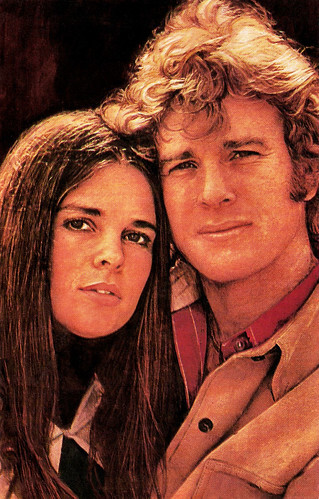
Romanian postcard by Casa Filmului Acin, no. 196. Ali McGraw and Ryan O'Neal in Love Story (Arthur Hiller, 1970).

Romanian postcard by Casa Filmului Acin, no. 434.
A box office phenomenon
Charles Samuel Eldridge Patrick Ryan O'Neal III was born in Los Angeles, California, in 1941. He was the eldest son of Irish-American Hollywood film screenwriter Charles O'Neal and actress Patricia Callaghan. The family moved frequently, and Ryan grew up in Mexico, England and Germany.
In West Los Angeles, O'Neal attended University High School and trained as an amateur boxer. He attended Munich American High School in Munich, where his parents worked on the American television series Tales of the Vikings (1959). The seventeen-year-old was hired as an extra and stuntman for the series. Back in the United States, O'Neal made his debut in the popular series The Many Loves of Dobie Gillis.
The pretty boy also played in such series as The Untouchables, The Virginian and Perry Mason. In 1964, he landed the role of Rodney Harrington on the prime-time soap opera Peyton Place. It was an instant hit and boosted O'Neal's career. O'Neal's first lead in a feature came with The Big Bounce (Alex March, 1969), based on an Elmore Leonard novel.
In 1970, he played an Olympic athlete in the British sports drama The Games (Michael Winner, 1970). The film had been co-written by Erich Segal, who recommended O'Neal for the lead alongside Ali MacGraw in Love Story (Arthur Hiller, 1970) based on Segal's novel and script. Love Story turned out to be a box office phenomenon. For his role as Oliver, O'Neal received Academy Award and Golden Globe nominations as Best Actor.
O'Neal starred in a number of films by director Peter Bogdanovich, such as the screwball comedy What's Up, Doc? (Peter Bogdanovich, 1972) with Barbra Streisand. It was another big hit and O'Neal was the second most profitable movie star in 1972. Other successes were Paper Moon (Peter Bogdanovich, 1973) with his then ten-year-old daughter Tatum O'Neal, the historical film Barry Lyndon (Stanley Kubrick, 1975), and Nickelodeon (Peter Bogdanovich, 1976) with Burt Reynolds. The latter film flopped at the box office.

Belgian postcard by Raider Bounty / Joepie. Ali McGraw and Ryan O'Neal in Love Story (Arthur Hiller, 1970).

Big East-German card by VEB Progress Film-Verleih, Berlin, no. 7/82. Ryan O'Neal in Oliver's Story (John Korty, 1978).
Worst Actor of the Decade
Ryan O'Neal played US General Gavin in the all-star war film A Bridge Too Far (Richard Attenborough, 1977) about the Battle of Arnhem. The film was shot from May to August 1976 at locations in the Netherlands. O'Neal was excellent in the thriller The Driver (Walter Hill, 1978) with Isabelle Adjani and Bruce Dern. The film was not a commercial hit but gained a cult reputation through the years.
O'Neal played a boxer in a romantic comedy, The Main Event (Howard Zieff, 1979), reuniting him with Barbra Streisand. He received a fee of $1 million plus a percentage of the profits. The Main Event was a sizeable hit at the box office. In the early 1980s, however, O'Neal's career faltered. Partners (James Burrows, 1982) was a farce written by Francis Veber in which O'Neal played a straight cop who goes undercover as one half of a gay couple with John Hurt.
He then played a film director loosely based on Peter Bogdanovich in Irreconcilable Differences (Charles Shyer, 1984) with Shelley Long and Drew Barrymore. It was a minor box office success. However, the gambling drama Fever Pitch (Richard Brooks, 1985) was nominated in four categories at the 1985 Razzie Awards, and for which he was nominated at the 1989 Razzie Awards for 'Worst Actor of the Decade'. After a few more flops, he received no more cinema offers. Instead, he appeared in a series of television films with his partner Farrah Fawcett, such as in the dramatic TV film Small Sacrifices (David Greene, 1989). He had a good role in Faithful (Paul Mazursky, 1996) with Cher. From 2005 to 2017, he had a recurring role in the TV series Bones as Max Keenan, the father of the show's protagonist.
Since 1982, O'Neal had been in a relationship with Farrah Fawcett. They had a son, Redmond (1985). From his two previous marriages, O'Neal has three more children: with actress Joanna Cook Moore he has a daughter and a son, Tatum (1963) and Griffin (1964); with Leigh Taylor-Young he had a son, Patrick (1967), a sports commentator. In 1997, Fawcett and O'Neal separated. In 2001, O'Neal was diagnosed with CML, a form of leukaemia and Fawcett and O'Neal became close again. On 22 June 2009, O'Neal announced that he now wanted to marry Fawcett, who was also seriously ill, but just three days later, Farrah Fawcett died of cancer in Los Angeles at the age of 62.
The relationships with his three eldest children were tense. In 2011, Tatum O'Neal reconciled with her father with a book and a TV show, 'Ryan and Tatum: the O'Neals'. In August of that year, O'Neal, Tatum, and Patrick attended Redmond's court appearance on firearms and drug charges. Redmond struggled with drug addiction for most of his adult life. Ryan O'Neal has five grandchildren: Kevin McEnroe, born in 1986, Sean McEnroe, born in 1987 and Emily McEnroe, born in 1991, whose mother is Tatum O'Neal. Patrick O'Neal is the father of Sophia De Mornay-O'Neal, born in 1997 and Veronica De Mornay-O'Neal, born in 2001. In 2016, Ryan O'Neal reunited with Love Story co-star Ali MacGraw in a staging of A.R. Gurney's play 'Love Letter'. In 2021, O'Neal and MacGraw received a star on the Hollywood Walk of Fame in a virtual double ceremony.

Romanian postcard by Casa Filmului Acin. Ryan O'Neal in Love Story (Arthur Hiller, 1970).

Romanian postcard by Casa Filmului Acin, no. 593.
Source: Wikipedia (English, French, German and Dutch) and .

Vintage collectors card, no. 33. Ryan O'Neal in the TV series Peyton Place (1964-1969).

Romanian postcard by Casa Filmului Acin, no. 196. Ali McGraw and Ryan O'Neal in Love Story (Arthur Hiller, 1970).

Romanian postcard by Casa Filmului Acin, no. 434.
A box office phenomenon
Charles Samuel Eldridge Patrick Ryan O'Neal III was born in Los Angeles, California, in 1941. He was the eldest son of Irish-American Hollywood film screenwriter Charles O'Neal and actress Patricia Callaghan. The family moved frequently, and Ryan grew up in Mexico, England and Germany.
In West Los Angeles, O'Neal attended University High School and trained as an amateur boxer. He attended Munich American High School in Munich, where his parents worked on the American television series Tales of the Vikings (1959). The seventeen-year-old was hired as an extra and stuntman for the series. Back in the United States, O'Neal made his debut in the popular series The Many Loves of Dobie Gillis.
The pretty boy also played in such series as The Untouchables, The Virginian and Perry Mason. In 1964, he landed the role of Rodney Harrington on the prime-time soap opera Peyton Place. It was an instant hit and boosted O'Neal's career. O'Neal's first lead in a feature came with The Big Bounce (Alex March, 1969), based on an Elmore Leonard novel.
In 1970, he played an Olympic athlete in the British sports drama The Games (Michael Winner, 1970). The film had been co-written by Erich Segal, who recommended O'Neal for the lead alongside Ali MacGraw in Love Story (Arthur Hiller, 1970) based on Segal's novel and script. Love Story turned out to be a box office phenomenon. For his role as Oliver, O'Neal received Academy Award and Golden Globe nominations as Best Actor.
O'Neal starred in a number of films by director Peter Bogdanovich, such as the screwball comedy What's Up, Doc? (Peter Bogdanovich, 1972) with Barbra Streisand. It was another big hit and O'Neal was the second most profitable movie star in 1972. Other successes were Paper Moon (Peter Bogdanovich, 1973) with his then ten-year-old daughter Tatum O'Neal, the historical film Barry Lyndon (Stanley Kubrick, 1975), and Nickelodeon (Peter Bogdanovich, 1976) with Burt Reynolds. The latter film flopped at the box office.

Belgian postcard by Raider Bounty / Joepie. Ali McGraw and Ryan O'Neal in Love Story (Arthur Hiller, 1970).

Big East-German card by VEB Progress Film-Verleih, Berlin, no. 7/82. Ryan O'Neal in Oliver's Story (John Korty, 1978).
Worst Actor of the Decade
Ryan O'Neal played US General Gavin in the all-star war film A Bridge Too Far (Richard Attenborough, 1977) about the Battle of Arnhem. The film was shot from May to August 1976 at locations in the Netherlands. O'Neal was excellent in the thriller The Driver (Walter Hill, 1978) with Isabelle Adjani and Bruce Dern. The film was not a commercial hit but gained a cult reputation through the years.
O'Neal played a boxer in a romantic comedy, The Main Event (Howard Zieff, 1979), reuniting him with Barbra Streisand. He received a fee of $1 million plus a percentage of the profits. The Main Event was a sizeable hit at the box office. In the early 1980s, however, O'Neal's career faltered. Partners (James Burrows, 1982) was a farce written by Francis Veber in which O'Neal played a straight cop who goes undercover as one half of a gay couple with John Hurt.
He then played a film director loosely based on Peter Bogdanovich in Irreconcilable Differences (Charles Shyer, 1984) with Shelley Long and Drew Barrymore. It was a minor box office success. However, the gambling drama Fever Pitch (Richard Brooks, 1985) was nominated in four categories at the 1985 Razzie Awards, and for which he was nominated at the 1989 Razzie Awards for 'Worst Actor of the Decade'. After a few more flops, he received no more cinema offers. Instead, he appeared in a series of television films with his partner Farrah Fawcett, such as in the dramatic TV film Small Sacrifices (David Greene, 1989). He had a good role in Faithful (Paul Mazursky, 1996) with Cher. From 2005 to 2017, he had a recurring role in the TV series Bones as Max Keenan, the father of the show's protagonist.
Since 1982, O'Neal had been in a relationship with Farrah Fawcett. They had a son, Redmond (1985). From his two previous marriages, O'Neal has three more children: with actress Joanna Cook Moore he has a daughter and a son, Tatum (1963) and Griffin (1964); with Leigh Taylor-Young he had a son, Patrick (1967), a sports commentator. In 1997, Fawcett and O'Neal separated. In 2001, O'Neal was diagnosed with CML, a form of leukaemia and Fawcett and O'Neal became close again. On 22 June 2009, O'Neal announced that he now wanted to marry Fawcett, who was also seriously ill, but just three days later, Farrah Fawcett died of cancer in Los Angeles at the age of 62.
The relationships with his three eldest children were tense. In 2011, Tatum O'Neal reconciled with her father with a book and a TV show, 'Ryan and Tatum: the O'Neals'. In August of that year, O'Neal, Tatum, and Patrick attended Redmond's court appearance on firearms and drug charges. Redmond struggled with drug addiction for most of his adult life. Ryan O'Neal has five grandchildren: Kevin McEnroe, born in 1986, Sean McEnroe, born in 1987 and Emily McEnroe, born in 1991, whose mother is Tatum O'Neal. Patrick O'Neal is the father of Sophia De Mornay-O'Neal, born in 1997 and Veronica De Mornay-O'Neal, born in 2001. In 2016, Ryan O'Neal reunited with Love Story co-star Ali MacGraw in a staging of A.R. Gurney's play 'Love Letter'. In 2021, O'Neal and MacGraw received a star on the Hollywood Walk of Fame in a virtual double ceremony.

Romanian postcard by Casa Filmului Acin. Ryan O'Neal in Love Story (Arthur Hiller, 1970).

Romanian postcard by Casa Filmului Acin, no. 593.
Source: Wikipedia (English, French, German and Dutch) and .
Published on July 19, 2023 22:00
July 18, 2023
Frau im Mond (1929)
Fritz Lang's last silent film Frau im Mond/Woman in the Moon (1929) was one of the first Science Fiction films to dwell upon the possibility of space travel. It followed in the footsteps of his silent German masterpieces Die Nibelungen (1924) and Metropolis (1926). Frau im Mond, starring Gerda Maurus and Willy Fritsch, tells the story of a half-mad greedy scientist obsessed with the idea of getting gold from the moon. A moon expedition follows and the look of the film is quite impressive, considering that it was made in 1929. The Nazis later banned the film, because the spaceship featured in the film was nearly identical to the V-2s that were constructed in secrecy by the Third Reich at the time. Frau im Mond is now a Sci-Fi classic.
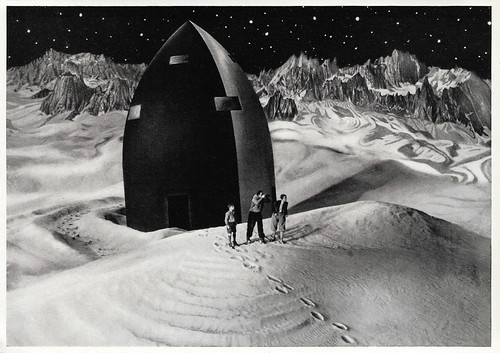
German collectors card by Ross Verlag in the series Vom Werden Deutscher Filmkunst - Der Stumme Film, picture no. 138, group 40. Photo: Ufa. Willy Fritsch , Gerda Maurus and Gustl Stark-Gstettenbauer in Frau im Mond/Woman in the Moon (Fritz Lang, 1929).
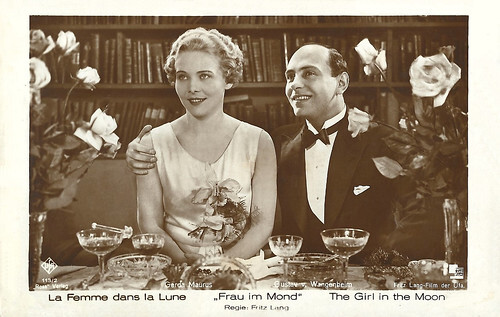
German postcard by Ross Verlag, Berlin, no. 113/2. Photo: Fritz Lang-Film der Ufa. Gerda Maurus and Gustav von Wangenheim in Frau im Mond (Fritz Lang, 1929).
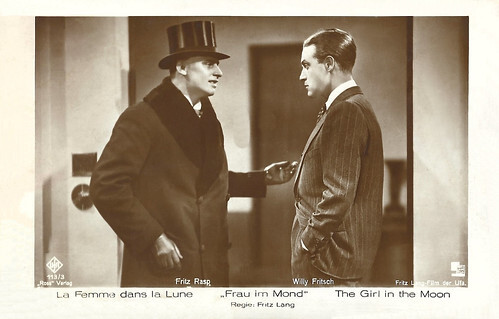
German postcard by Ross Verlag, Berlin, no. 113/3. Photo: Fritz Lang-Film der Ufa. Fritz Rasp and Willy Fritsch in Frau im Mond (Fritz Lang, 1929).
Valuable information from the dark side of the Moon
Frau im Mond/Woman in the Moon (1929) was based on a novel by Fritz Lang 's wife, Thea von Harbau, who had also written the script of Metropolis (Fritz Lang, 1926). The film was shot between October 1928 and June 1929 at the UFA studios in Neubabelsberg near Berlin. Similar to Metropolis, Frau im Mond is very long, running over two and a half hours. It is roughly divided into two parts, the first of which is more in the spy genre, while the second is about the launch of the moon rocket, the flight to the moon and the stay on the satellite.
At a scientific conference, Prof. Manfeldt (Klaus Pohl) presents his theory on the existence of gold on the Moon. It is greeted with laughter by the assembled academics. Thirty years later, Herr Helius ( Willy Fritsch ) recognises the value of Mannfeldt's work. The engineer and aeroplane hangar owner Helius has ambitious plans to build a spaceship and take it to the Moon. He and Windegger (Gustav von Wangenheim), his chief engineer, will be going, and so will Prof. Manfeldt, now living in complete poverty in the cramped attic of a house.
A gang of evil businessmen have taken an interest in Mannfeldt's theories, and they send a spy ( Fritz Rasp ) who identifies himself as "Walter Turner". The financiers insist that their man Turner will accompany the flight. The unmanned Rocket H 32 brings back valuable information from the dark side of the Moon. Meanwhile, Windegger has announced his engagement to Helius's other assistant, the pretty Friede ( Gerda Maurus ). Helius, who secretly loves Friede, avoids their engagement party.
And the financiers have a secret agenda: to control the world's gold supply... Finally, the Spaceship "Friede" is ready as it rolls out on its gantry for takeoff. The staged rocket works as planned, but the acceleration is fierce. As they approach the Moon, they discover a stowaway on board, Gustav ( Gustl Stark-Gstettenbaur ), a young boy. Gustav, the son of Helius' driver, had befriended Helius and has stowed away, along with his collection of science fiction pulp magazines. During the journey, Windegger emerges as a coward, and Helius's feelings for Friede begin to become known to her, creating a romantic triangle.
They reach the far side of the Moon and find it has a breathable atmosphere, per the theories of Peter Andreas Hansen, who is mentioned near the beginning of the film. Mannfeldt discovers gold, proving his theory. When confronted by Turner, Mannfeldt falls to his death in a crevasse. Turner attempts to hijack the rocket, and in the struggle, he is shot and killed. Gunfire damages the oxygen tanks, and they come to the grim realisation that there is not enough oxygen for all to make the return trip. One person must remain on the Moon.
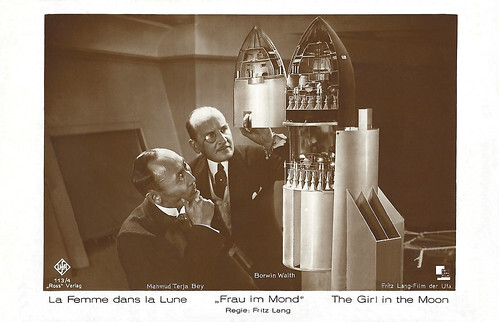
German postcard by Ross Verlag, Berlin, no. 113/4. Photo: Fritz Lang-Film der Ufa. Mahmud Terja Bey and Borwin Walth in Frau im Mond/The Girl in the Moon (Fritz Lang, 1929).
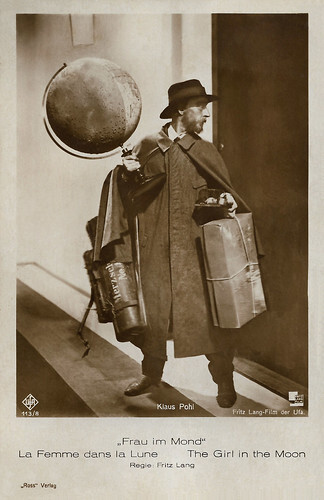
German postcard by Ross Verlag, Berlin, no. 113/8. Photo: Fritz Lang-Film der UFA. Photo: Ufa. Klaus Pohl in Frau im Mond/Woman in the Moon (Fritz Lang, 1929).
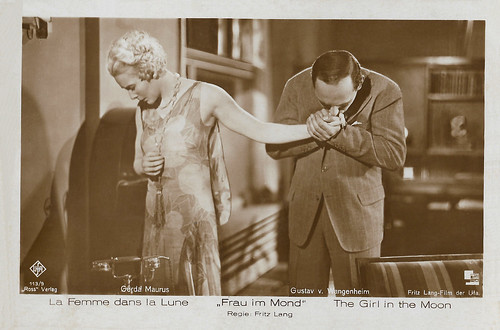
German postcard by Ross Verlag, no. 113/9. Photo: Ufa. Gerda Maurus and Gustav von Wangenheim in Frau im Mond/Woman in the Moon (Fritz Lang, 1929).
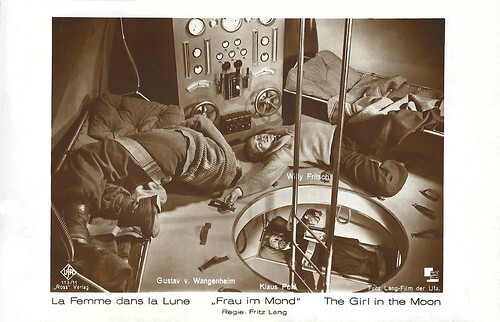
German postcard. Ross Verlag, Berlin, no. 113/11. Photo: Fritz Lang-Film der Ufa. Willy Fritsch , Klaus Pohl, and Gustav von Wangenheim in Frau im Mond/Woman in the Moon (Fritz Lang, 1929).
One of the last great German silent films
Within the framework of the state of knowledge at the time, Fritz Lang attached great importance to a scientifically sound presentation of the technical details of launch, flight and landing as well as the lunar landscape in Frau im Mond/Woman in the Moon (1929). Lang hired German physicist Hermann Oberth as a technical advisor for the film. Noted post-war science writer Willy Ley also served as a consultant on the film. Another rocket pioneer, Rudolf Nebel, was hired by Oberth as a technical assistant, and together they constructed a two-metre-long rocket that was to be launched into the sky for promotional purposes at the premiere at the suggestion of Willy Ley, but unfortunately did not work.
When the Nazis began working on war rockets, they hired Oberth and Nebel to work on the V-2 rocket program, the later "wonder weapon" of the Second World War. Oberth also became the mentor of Wernher von Braun. The Nazis decided the rocket in Frau im Mond was too close to the truth. To preserve secrecy, they had the models destroyed and the film withdrawn from release. After World War II, Hermann Oberth followed Wernher von Braun to the United States where he participated in rocket experiments for many years. Braun later hired Oberth as technical consultant for NASA's Atlas rocket.
The first half of Frau im Mond/Woman in the Moon (1929); the set-up of the flight, the introduction to the main characters, a love triangle, and an international conspiracy is the least interesting part of the film. Once the flight begins, action tenses up and things get interesting. The best scenes of the film were created from the technical elements in combination with a good trick technique. True to the theory of astronomer Peter Andreas Hansen and scientific assumptions that were still widespread at the time, oxygen, water and gold do indeed occur on the far side of the moon in this story. Hal Erickson at AllMovie : "like many of its modern-day counterparts, more successful on a special-effects level than it is in terms of character development."
Several prescient technical and operational features are presented during the film's launch sequence, which subsequently came into common operational use during America's postwar space race. Wikipedia mentions: "The rocket ship Friede is fully built in a tall building and moved to the launch area. As launch approaches, intertitles count down the seconds from six to "now" ("now" was used for zero), and Woman in the Moon is often cited as the first occurrence of the "countdown to zero" before a rocket launch. The rocket ship blasts off submerged in a pool of water; water is commonly used today on launch pads to absorb and dissipate the extreme heat and to dampen the noise generated by the rocket exhaust. In space, the rocket ejects its first stage and fires its second stage rocket, predicting the development of modern multistage orbital rockets. The crew reclined on horizontal beds to cope with the G-forces experienced during lift-off and pre-orbital acceleration. Floor foot straps are used to restrain the crew during zero gravity."
A lunar landscape and an imposing black and white moon rocket were built in the film studio. In order to depict the lunar landscape as realistically as possible, a goods train load of 40 wagons of Baltic Sea sand was brought to the film studio for the filming. Commercially, Frau im Mond/Woman in the Moon (1929) was rather disappointing, but went down in German film history as one of the last great silent films. Several elements of the film inspired Irving Pichel's film Destination Moon (Irving Pichel, 1950), which in turn inspired the Tintin albums 'Objectif Lune'(Destination Moon, 1953) and 'On a marché sur la Lune' (Explorers on the Moon, 1943) by Belgian cartoonist Hergé. Frau im Mond/Woman in the Moon (1929) was the last blockbuster of the UFA (Universum Film AG) studio before the crash of 1929. In the 1960s, Fritz Lang was repeatedly invited as a guest of honour and speaker in the US spaceflight environment because of his innovative merits with Frau im Mond/Woman in the Moon (1929). The film was restored in 2000 by the Friedrich Wilhelm Murnau Foundation from negatives belonging to the Bundesarchiv-Filmarchiv in Berlin.
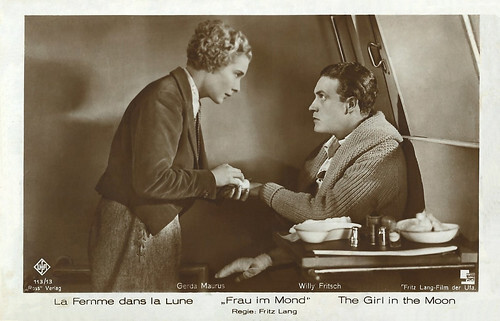
German postcard by Ross Verlag, Berlin, no. 113/13. Photo: Fritz Lang-Film der Ufa. Gerda Maurus and Willy Fritsch in Frau im Mond/Woman in the Moon (Fritz Lang, 1929).
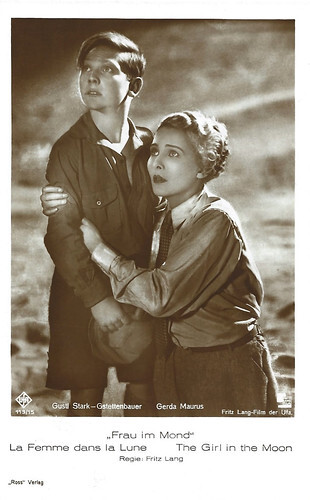
German postcard by Ross Verlag, Berlin, no. 113/15. Photo: Fritz Lang-Film der Ufa. Gerda Maurus and Gustl Stark-Gstettenbauer in Frau im Mond/The Girl in the Moon (Fritz Lang, 1929).
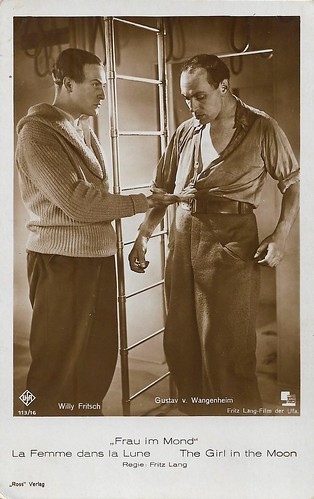
German postcard by Ross Verlag, Berlin, no. 113/16. Photo: Fritz Lang-Film der UFA. Photo: Ufa. Willy Fritsch and Gustav von Wangenheim in Frau im Mond/Woman in the Moon (Fritz Lang, 1929).
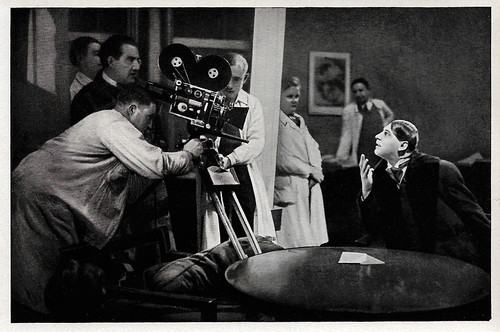
German collectors card by Ross Verlag in the series Vom Werden Deutscher Filmkunst - Der Stumme Film, no. 169, Group 43. Photo: Ufa. Fritz Lang and Fritz Rasp at the set of Frau im Mond/Woman in the Moon (Fritz Lang, 1929).
Sources: Hal Erickson (AllMovie), Wikipedia (French, German and English), and IMDb.

German collectors card by Ross Verlag in the series Vom Werden Deutscher Filmkunst - Der Stumme Film, picture no. 138, group 40. Photo: Ufa. Willy Fritsch , Gerda Maurus and Gustl Stark-Gstettenbauer in Frau im Mond/Woman in the Moon (Fritz Lang, 1929).

German postcard by Ross Verlag, Berlin, no. 113/2. Photo: Fritz Lang-Film der Ufa. Gerda Maurus and Gustav von Wangenheim in Frau im Mond (Fritz Lang, 1929).

German postcard by Ross Verlag, Berlin, no. 113/3. Photo: Fritz Lang-Film der Ufa. Fritz Rasp and Willy Fritsch in Frau im Mond (Fritz Lang, 1929).
Valuable information from the dark side of the Moon
Frau im Mond/Woman in the Moon (1929) was based on a novel by Fritz Lang 's wife, Thea von Harbau, who had also written the script of Metropolis (Fritz Lang, 1926). The film was shot between October 1928 and June 1929 at the UFA studios in Neubabelsberg near Berlin. Similar to Metropolis, Frau im Mond is very long, running over two and a half hours. It is roughly divided into two parts, the first of which is more in the spy genre, while the second is about the launch of the moon rocket, the flight to the moon and the stay on the satellite.
At a scientific conference, Prof. Manfeldt (Klaus Pohl) presents his theory on the existence of gold on the Moon. It is greeted with laughter by the assembled academics. Thirty years later, Herr Helius ( Willy Fritsch ) recognises the value of Mannfeldt's work. The engineer and aeroplane hangar owner Helius has ambitious plans to build a spaceship and take it to the Moon. He and Windegger (Gustav von Wangenheim), his chief engineer, will be going, and so will Prof. Manfeldt, now living in complete poverty in the cramped attic of a house.
A gang of evil businessmen have taken an interest in Mannfeldt's theories, and they send a spy ( Fritz Rasp ) who identifies himself as "Walter Turner". The financiers insist that their man Turner will accompany the flight. The unmanned Rocket H 32 brings back valuable information from the dark side of the Moon. Meanwhile, Windegger has announced his engagement to Helius's other assistant, the pretty Friede ( Gerda Maurus ). Helius, who secretly loves Friede, avoids their engagement party.
And the financiers have a secret agenda: to control the world's gold supply... Finally, the Spaceship "Friede" is ready as it rolls out on its gantry for takeoff. The staged rocket works as planned, but the acceleration is fierce. As they approach the Moon, they discover a stowaway on board, Gustav ( Gustl Stark-Gstettenbaur ), a young boy. Gustav, the son of Helius' driver, had befriended Helius and has stowed away, along with his collection of science fiction pulp magazines. During the journey, Windegger emerges as a coward, and Helius's feelings for Friede begin to become known to her, creating a romantic triangle.
They reach the far side of the Moon and find it has a breathable atmosphere, per the theories of Peter Andreas Hansen, who is mentioned near the beginning of the film. Mannfeldt discovers gold, proving his theory. When confronted by Turner, Mannfeldt falls to his death in a crevasse. Turner attempts to hijack the rocket, and in the struggle, he is shot and killed. Gunfire damages the oxygen tanks, and they come to the grim realisation that there is not enough oxygen for all to make the return trip. One person must remain on the Moon.

German postcard by Ross Verlag, Berlin, no. 113/4. Photo: Fritz Lang-Film der Ufa. Mahmud Terja Bey and Borwin Walth in Frau im Mond/The Girl in the Moon (Fritz Lang, 1929).

German postcard by Ross Verlag, Berlin, no. 113/8. Photo: Fritz Lang-Film der UFA. Photo: Ufa. Klaus Pohl in Frau im Mond/Woman in the Moon (Fritz Lang, 1929).

German postcard by Ross Verlag, no. 113/9. Photo: Ufa. Gerda Maurus and Gustav von Wangenheim in Frau im Mond/Woman in the Moon (Fritz Lang, 1929).

German postcard. Ross Verlag, Berlin, no. 113/11. Photo: Fritz Lang-Film der Ufa. Willy Fritsch , Klaus Pohl, and Gustav von Wangenheim in Frau im Mond/Woman in the Moon (Fritz Lang, 1929).
One of the last great German silent films
Within the framework of the state of knowledge at the time, Fritz Lang attached great importance to a scientifically sound presentation of the technical details of launch, flight and landing as well as the lunar landscape in Frau im Mond/Woman in the Moon (1929). Lang hired German physicist Hermann Oberth as a technical advisor for the film. Noted post-war science writer Willy Ley also served as a consultant on the film. Another rocket pioneer, Rudolf Nebel, was hired by Oberth as a technical assistant, and together they constructed a two-metre-long rocket that was to be launched into the sky for promotional purposes at the premiere at the suggestion of Willy Ley, but unfortunately did not work.
When the Nazis began working on war rockets, they hired Oberth and Nebel to work on the V-2 rocket program, the later "wonder weapon" of the Second World War. Oberth also became the mentor of Wernher von Braun. The Nazis decided the rocket in Frau im Mond was too close to the truth. To preserve secrecy, they had the models destroyed and the film withdrawn from release. After World War II, Hermann Oberth followed Wernher von Braun to the United States where he participated in rocket experiments for many years. Braun later hired Oberth as technical consultant for NASA's Atlas rocket.
The first half of Frau im Mond/Woman in the Moon (1929); the set-up of the flight, the introduction to the main characters, a love triangle, and an international conspiracy is the least interesting part of the film. Once the flight begins, action tenses up and things get interesting. The best scenes of the film were created from the technical elements in combination with a good trick technique. True to the theory of astronomer Peter Andreas Hansen and scientific assumptions that were still widespread at the time, oxygen, water and gold do indeed occur on the far side of the moon in this story. Hal Erickson at AllMovie : "like many of its modern-day counterparts, more successful on a special-effects level than it is in terms of character development."
Several prescient technical and operational features are presented during the film's launch sequence, which subsequently came into common operational use during America's postwar space race. Wikipedia mentions: "The rocket ship Friede is fully built in a tall building and moved to the launch area. As launch approaches, intertitles count down the seconds from six to "now" ("now" was used for zero), and Woman in the Moon is often cited as the first occurrence of the "countdown to zero" before a rocket launch. The rocket ship blasts off submerged in a pool of water; water is commonly used today on launch pads to absorb and dissipate the extreme heat and to dampen the noise generated by the rocket exhaust. In space, the rocket ejects its first stage and fires its second stage rocket, predicting the development of modern multistage orbital rockets. The crew reclined on horizontal beds to cope with the G-forces experienced during lift-off and pre-orbital acceleration. Floor foot straps are used to restrain the crew during zero gravity."
A lunar landscape and an imposing black and white moon rocket were built in the film studio. In order to depict the lunar landscape as realistically as possible, a goods train load of 40 wagons of Baltic Sea sand was brought to the film studio for the filming. Commercially, Frau im Mond/Woman in the Moon (1929) was rather disappointing, but went down in German film history as one of the last great silent films. Several elements of the film inspired Irving Pichel's film Destination Moon (Irving Pichel, 1950), which in turn inspired the Tintin albums 'Objectif Lune'(Destination Moon, 1953) and 'On a marché sur la Lune' (Explorers on the Moon, 1943) by Belgian cartoonist Hergé. Frau im Mond/Woman in the Moon (1929) was the last blockbuster of the UFA (Universum Film AG) studio before the crash of 1929. In the 1960s, Fritz Lang was repeatedly invited as a guest of honour and speaker in the US spaceflight environment because of his innovative merits with Frau im Mond/Woman in the Moon (1929). The film was restored in 2000 by the Friedrich Wilhelm Murnau Foundation from negatives belonging to the Bundesarchiv-Filmarchiv in Berlin.

German postcard by Ross Verlag, Berlin, no. 113/13. Photo: Fritz Lang-Film der Ufa. Gerda Maurus and Willy Fritsch in Frau im Mond/Woman in the Moon (Fritz Lang, 1929).

German postcard by Ross Verlag, Berlin, no. 113/15. Photo: Fritz Lang-Film der Ufa. Gerda Maurus and Gustl Stark-Gstettenbauer in Frau im Mond/The Girl in the Moon (Fritz Lang, 1929).

German postcard by Ross Verlag, Berlin, no. 113/16. Photo: Fritz Lang-Film der UFA. Photo: Ufa. Willy Fritsch and Gustav von Wangenheim in Frau im Mond/Woman in the Moon (Fritz Lang, 1929).

German collectors card by Ross Verlag in the series Vom Werden Deutscher Filmkunst - Der Stumme Film, no. 169, Group 43. Photo: Ufa. Fritz Lang and Fritz Rasp at the set of Frau im Mond/Woman in the Moon (Fritz Lang, 1929).
Sources: Hal Erickson (AllMovie), Wikipedia (French, German and English), and IMDb.
Published on July 18, 2023 22:00
July 17, 2023
New acquisitions from Bologna
One of our favourite postcard sellers is Primo Giroldini from Parma. He is always present at the yearly Book Fair of Il Cinema Ritrovato in Bologna. The most tempting collection of film books, DVDs, Blu-rays, posters and postcards is offered inside the Renzo Renzi Library. And yes, we left some empty space in our luggage! Ivo Blom selected for this EFSP post the most precious treasures he bought this year from Primo.
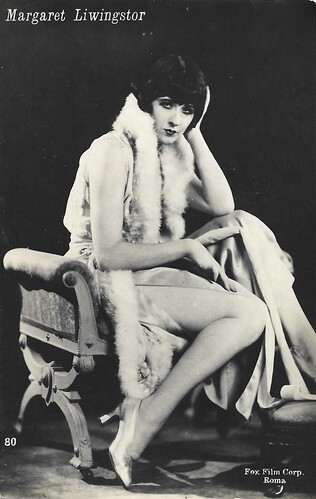
Italian postcard by Ed. Ballerini & Fratini, Firenze (B.F.F.), no. 80. Photo: Fox Film Corp., Roma.
Margaret Livingston (1895–1984) was an American film actress and businesswoman, most notable for her work during the silent film era, especially for Fox Film and Paramount. She remains best known today as "the Woman from the City" in F.W. Murnau's classic Sunrise: A Song of Two Humans (1927).

German postcard by Ross Verlag, no. 593/1, 1919-1924. Photo: Filmzentrale. Siegmund Breitbart in the Austrian film Der Eisenkönig/The Iron King (Max Neufeld, 1923).
Siegmund Breitbart (1893-1925), also known popularly as Zishe or Sische Breitbart (Yiddish: זישע ברייטבאַרט), was a Polish-born circus performer, vaudeville strongman and Jewish folklore hero. He was known as the "Strongest Man in the World" and "Eisenkönig" (The Iron King) during the 1920s.

Italian postcard, no.138. Photo: Films Paramount, Roma. Gloria Swanson in the lost film Madame Sans-Gêne (Léonce Perret, 1925), entirely produced and filmed in France.
Gloria Swanson (1899-1983) was one of the biggest Hollywood stars of the silent era. She transformed from a typical Mack Sennett comedienne into a lively, provocative, even predatory, star in films by Cecil B. De Mille. She received Oscar nominations for Sadie Thompson (1928), The Trespasser (1929) and Sunset Blvd. (1950).
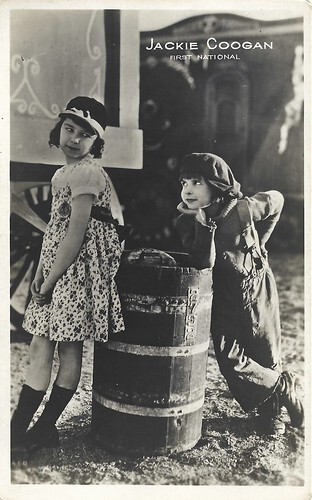
Italian postcard. Photo: First National. Jackie Coogan and Peaches Jackson in Circus Days (Edward F. Cline, 1923).
American actor John Leslie 'Jackie' Coogan (1914-1984) began as a child actor in silent films. He was Charlie Chaplin 's irascible sidekick in The Kid (Charles Chaplin, 1921) and played the title role in Oliver Twist (Frank Lloyd, 1922). Many years later, he became known as Uncle Fester in the TV series The Addams Family (1964-1966). In the interim, he sued his mother and stepfather over his squandered film earnings ($48 million to $65 million adjusted for 2012 dollars) and provoked California to enact the first known legal protection for the earnings of child performers, widely known as 'the Coogan Act'.
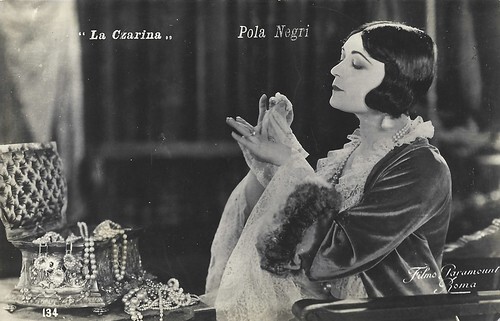
Vintage Italian postcard, no. 134. Photo: Films Paramount, Roma. Pola Negri in Forbidden Paradise (Ernst Lubitsch, 1924), launched in Italy as La Czarina.
Polish film actress Pola Negri (1897-1987) achieved notoriety as a femme fatale in German and American silent films between the 1910s and the 1930s.
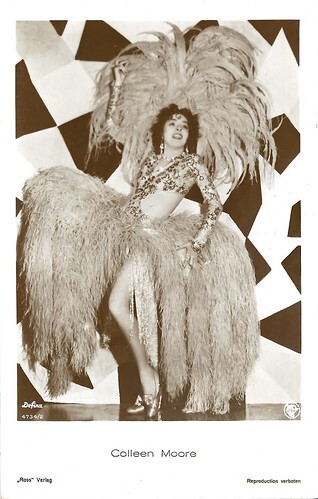
German postcard by Ross Verlag, no. 4734/2, 1929-1930. Photo: Defina / First National.
American actress Colleen Moore (1899-1988) was a star of the silent screen who appeared in about 100 films beginning in 1917. During the 1920s, she put her stamp on American social history, creating in dozens of films the image of the wide-eyed, insouciant flapper with her bobbed hair and short skirts.
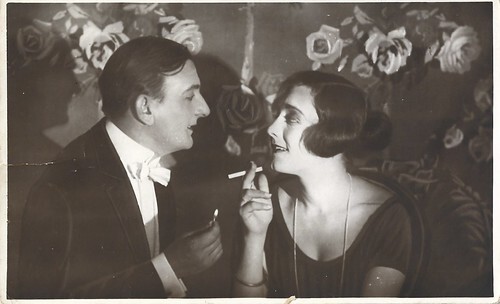
Italian postcard by Fert, card 8 of 12. Diomira Jacobini and Alberto Collo in L'isola della felicità (Luciano Doria, 1921), scripted by Nunzio Malasomma. Caption: The first glance.
Diomira Jacobini (1899-1959) was one of the stars of the Italian silent cinema. She was the younger sister of film diva Maria Jacobini, in whose shadow she always stayed even if she did some fascinating films herself. Diomira appeared in some 55 films in Italy, Germany and Denmark.
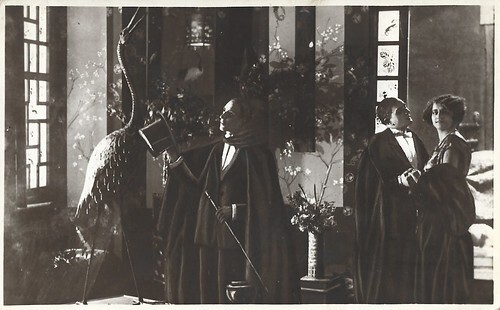
Italian postcard by Fert, card 11 of 12. Alberto Collo , Hella Andersen and Alfredo Martinelli in L'isola della felicità (Luciano Doria, 1921), scripted by Nunzio Malasomma. Caption: The happiness of one night.
Alberto Collo (1883-1955) was an Italian film actor of mostly silent cinema. In the 1910s and early 1920s, he acted opposite the female stars of his times. He also performed in war propaganda, historical films and strong men films.
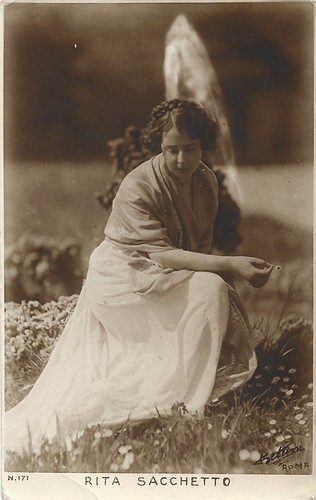
Italian postcard by Ed. Soc. An. Bettini, Roma, no. 171. Photo portrait by Riccardo Bettini, c. 1916.
German actress and dancer Rita Sacchetto (1879-1959) was in the 1910s a star of the Danish Nordisk Film Company.
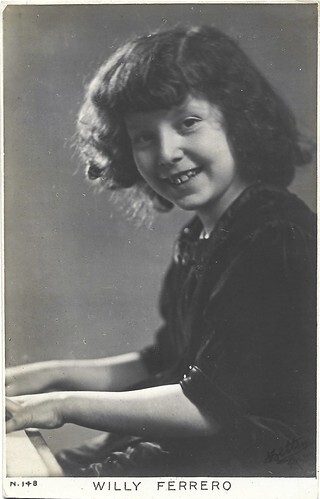
Italian postcard by Ed. Soc. An. Bettini, Roma, no. 148. Photo portrait by Riccardo Bettini, c. 1916.
Italian conductor and composer Willy Ferrero was born in Portland, Maine, in 1906 and was taken to Italy by his parents at the age of 2. He was a musical prodigy and directed several symphonic pieces at the Trocadero in Paris at the age of 3 years, 8 months. The great composer Massenet was among those who assisted at this concert and moved to the point of shedding tears he kissed the tiny director and exclaimed, “Go, you are born artist. Of you history will certainly speak”. At the age of 4, he led the orchestra in the Folies Bergère in Paris. Two years later, he directed his first symphonic concert in Rome at the Teatro Costanzi.
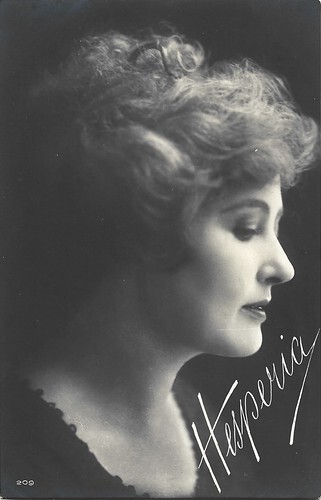
Italian postcard by Fotocelere, Torino, no. 209.
Hesperia (1885-1959) was one of the greatest divas of the Italian silent screen. She often worked with director Baldassarre Negroni, who later became her husband.
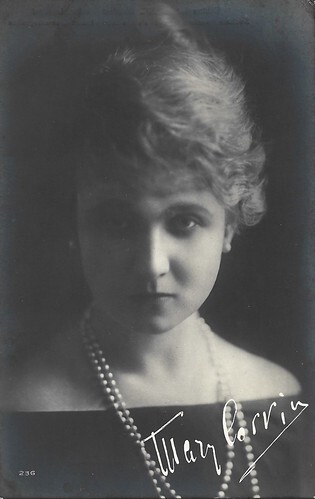
Italian postcard by Fotocelere / SARPAC Bucarest, no. 236.
Mary Corwyn aka Mary Corvin and Maria Corvin (1895-?) was a Polish actress, active in Italian silent film. Born Maria Breninski / Breninki in Warsaw, Poland, she was widowed at a young early age and arrived in Italy on a British ship. She was noted in Neapolitan literary circles. In 1916 she was hired by the Neapolitan film company Polifilms, where she acted in 7 films directed by Giulio Antamoro, and distributed by Lombardo Film. She became the 'first actress' at Polifilm, thanks to her blue eyes and photogenic qualities. In 1918, journalist Edoardo Scarfoglio brought her to writer-producer-actor Lucio d'Ambra, who hired her for his Roman film company Do-Re-Mi. She debuted there in Napoleoncina/L'épopée de Napoléonnette (Lucio D'Ambra, 1918), on a young girl smitten with Napoleon and his modern lookalike Dr. Toccasana.
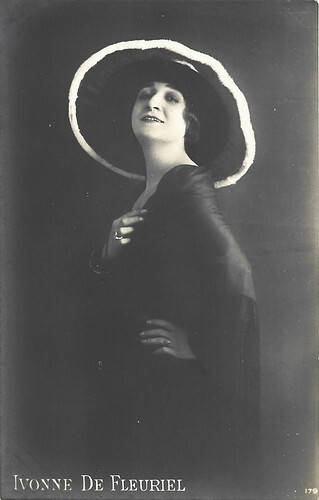
Italian postcard by Fotocelere, Torino, no. 179.
Italian Yvonne De Fleuriel (1889-1963) was a singer and actress of variety and silent films. She was very popular during the Belle Epoque.
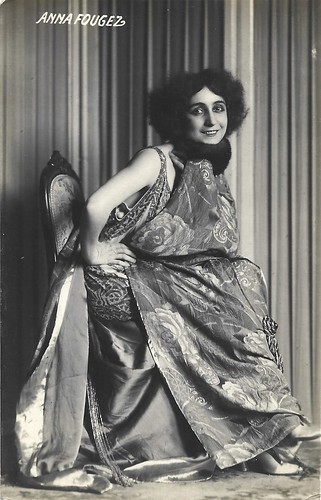
Italian postcard by Ed. Ballerini & Fratini, Firenze.
Anna Fougez (1894-1966) was a vaudeville star who shone on the Italian stage from the First World War to the mid-1920s. She also played in various Italian films.
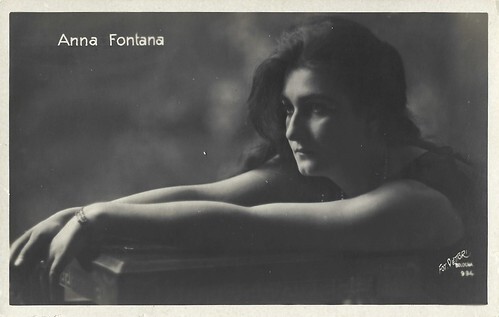
Italian postcard, no. 934. Photo by Vettori, Bologna.
Anna Fontana (1902-1974) was an Italian stage actress of the later 1920s and early 1930s, who also acted in one film, Il richiamo del cuore (1930).
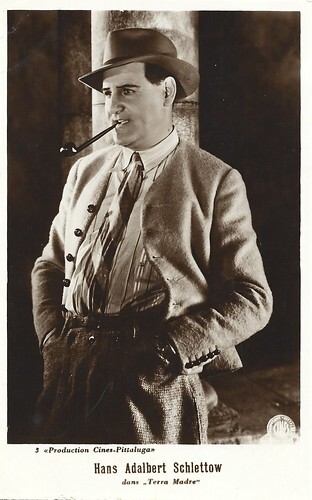
Italian postcard (despite the French text) by Cines-Pittaluga, no. 3. Hans-Adalbert Schlettow in the German language version of Alessandro Blasetti's Terra madre/Mother Earth (1931): the German early sound film Kennst Du das Land (Constantin J. David, 1931), shot simultaneously with the Italian version in Italy.
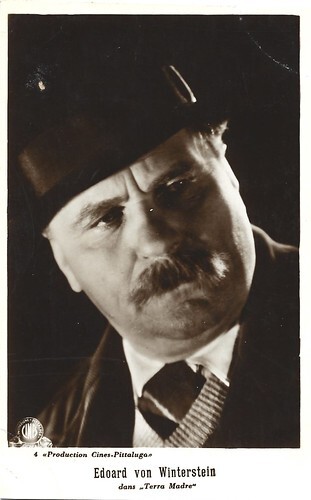
Italian postcard by Cines-Pittaluga, no. 4. Eduard von Winterstein in the German language version of Alessandro Blasetti's Terra madre/Mother Earth (1931): the German early sound film Kennst Du das Land (Constantin J. David, 1931).
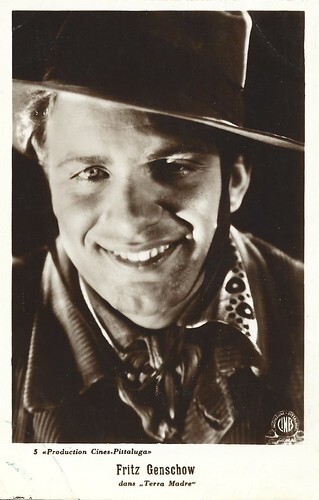
Italian postcard by Cines-Pittaluga, no. 5. Fritz Genschow in the German language version of Alessandro Blasetti's Terra madre/Mother Earth (1931): the German early sound film Kennst Du das Land (Constantin J. David, 1931).

Italian postcard by Ed. Ballerini & Fratini, Firenze (B.F.F.), no. 80. Photo: Fox Film Corp., Roma.
Margaret Livingston (1895–1984) was an American film actress and businesswoman, most notable for her work during the silent film era, especially for Fox Film and Paramount. She remains best known today as "the Woman from the City" in F.W. Murnau's classic Sunrise: A Song of Two Humans (1927).

German postcard by Ross Verlag, no. 593/1, 1919-1924. Photo: Filmzentrale. Siegmund Breitbart in the Austrian film Der Eisenkönig/The Iron King (Max Neufeld, 1923).
Siegmund Breitbart (1893-1925), also known popularly as Zishe or Sische Breitbart (Yiddish: זישע ברייטבאַרט), was a Polish-born circus performer, vaudeville strongman and Jewish folklore hero. He was known as the "Strongest Man in the World" and "Eisenkönig" (The Iron King) during the 1920s.

Italian postcard, no.138. Photo: Films Paramount, Roma. Gloria Swanson in the lost film Madame Sans-Gêne (Léonce Perret, 1925), entirely produced and filmed in France.
Gloria Swanson (1899-1983) was one of the biggest Hollywood stars of the silent era. She transformed from a typical Mack Sennett comedienne into a lively, provocative, even predatory, star in films by Cecil B. De Mille. She received Oscar nominations for Sadie Thompson (1928), The Trespasser (1929) and Sunset Blvd. (1950).

Italian postcard. Photo: First National. Jackie Coogan and Peaches Jackson in Circus Days (Edward F. Cline, 1923).
American actor John Leslie 'Jackie' Coogan (1914-1984) began as a child actor in silent films. He was Charlie Chaplin 's irascible sidekick in The Kid (Charles Chaplin, 1921) and played the title role in Oliver Twist (Frank Lloyd, 1922). Many years later, he became known as Uncle Fester in the TV series The Addams Family (1964-1966). In the interim, he sued his mother and stepfather over his squandered film earnings ($48 million to $65 million adjusted for 2012 dollars) and provoked California to enact the first known legal protection for the earnings of child performers, widely known as 'the Coogan Act'.

Vintage Italian postcard, no. 134. Photo: Films Paramount, Roma. Pola Negri in Forbidden Paradise (Ernst Lubitsch, 1924), launched in Italy as La Czarina.
Polish film actress Pola Negri (1897-1987) achieved notoriety as a femme fatale in German and American silent films between the 1910s and the 1930s.

German postcard by Ross Verlag, no. 4734/2, 1929-1930. Photo: Defina / First National.
American actress Colleen Moore (1899-1988) was a star of the silent screen who appeared in about 100 films beginning in 1917. During the 1920s, she put her stamp on American social history, creating in dozens of films the image of the wide-eyed, insouciant flapper with her bobbed hair and short skirts.

Italian postcard by Fert, card 8 of 12. Diomira Jacobini and Alberto Collo in L'isola della felicità (Luciano Doria, 1921), scripted by Nunzio Malasomma. Caption: The first glance.
Diomira Jacobini (1899-1959) was one of the stars of the Italian silent cinema. She was the younger sister of film diva Maria Jacobini, in whose shadow she always stayed even if she did some fascinating films herself. Diomira appeared in some 55 films in Italy, Germany and Denmark.

Italian postcard by Fert, card 11 of 12. Alberto Collo , Hella Andersen and Alfredo Martinelli in L'isola della felicità (Luciano Doria, 1921), scripted by Nunzio Malasomma. Caption: The happiness of one night.
Alberto Collo (1883-1955) was an Italian film actor of mostly silent cinema. In the 1910s and early 1920s, he acted opposite the female stars of his times. He also performed in war propaganda, historical films and strong men films.

Italian postcard by Ed. Soc. An. Bettini, Roma, no. 171. Photo portrait by Riccardo Bettini, c. 1916.
German actress and dancer Rita Sacchetto (1879-1959) was in the 1910s a star of the Danish Nordisk Film Company.

Italian postcard by Ed. Soc. An. Bettini, Roma, no. 148. Photo portrait by Riccardo Bettini, c. 1916.
Italian conductor and composer Willy Ferrero was born in Portland, Maine, in 1906 and was taken to Italy by his parents at the age of 2. He was a musical prodigy and directed several symphonic pieces at the Trocadero in Paris at the age of 3 years, 8 months. The great composer Massenet was among those who assisted at this concert and moved to the point of shedding tears he kissed the tiny director and exclaimed, “Go, you are born artist. Of you history will certainly speak”. At the age of 4, he led the orchestra in the Folies Bergère in Paris. Two years later, he directed his first symphonic concert in Rome at the Teatro Costanzi.

Italian postcard by Fotocelere, Torino, no. 209.
Hesperia (1885-1959) was one of the greatest divas of the Italian silent screen. She often worked with director Baldassarre Negroni, who later became her husband.

Italian postcard by Fotocelere / SARPAC Bucarest, no. 236.
Mary Corwyn aka Mary Corvin and Maria Corvin (1895-?) was a Polish actress, active in Italian silent film. Born Maria Breninski / Breninki in Warsaw, Poland, she was widowed at a young early age and arrived in Italy on a British ship. She was noted in Neapolitan literary circles. In 1916 she was hired by the Neapolitan film company Polifilms, where she acted in 7 films directed by Giulio Antamoro, and distributed by Lombardo Film. She became the 'first actress' at Polifilm, thanks to her blue eyes and photogenic qualities. In 1918, journalist Edoardo Scarfoglio brought her to writer-producer-actor Lucio d'Ambra, who hired her for his Roman film company Do-Re-Mi. She debuted there in Napoleoncina/L'épopée de Napoléonnette (Lucio D'Ambra, 1918), on a young girl smitten with Napoleon and his modern lookalike Dr. Toccasana.

Italian postcard by Fotocelere, Torino, no. 179.
Italian Yvonne De Fleuriel (1889-1963) was a singer and actress of variety and silent films. She was very popular during the Belle Epoque.

Italian postcard by Ed. Ballerini & Fratini, Firenze.
Anna Fougez (1894-1966) was a vaudeville star who shone on the Italian stage from the First World War to the mid-1920s. She also played in various Italian films.

Italian postcard, no. 934. Photo by Vettori, Bologna.
Anna Fontana (1902-1974) was an Italian stage actress of the later 1920s and early 1930s, who also acted in one film, Il richiamo del cuore (1930).

Italian postcard (despite the French text) by Cines-Pittaluga, no. 3. Hans-Adalbert Schlettow in the German language version of Alessandro Blasetti's Terra madre/Mother Earth (1931): the German early sound film Kennst Du das Land (Constantin J. David, 1931), shot simultaneously with the Italian version in Italy.

Italian postcard by Cines-Pittaluga, no. 4. Eduard von Winterstein in the German language version of Alessandro Blasetti's Terra madre/Mother Earth (1931): the German early sound film Kennst Du das Land (Constantin J. David, 1931).

Italian postcard by Cines-Pittaluga, no. 5. Fritz Genschow in the German language version of Alessandro Blasetti's Terra madre/Mother Earth (1931): the German early sound film Kennst Du das Land (Constantin J. David, 1931).
Published on July 17, 2023 22:00
July 16, 2023
Jane Birkin (1946-2023)
On 16 July 2023, British actress Jane Birkin (1946) was found dead in her Paris home by her personal nurse. In the Swinging Sixties, the shy, awkward-looking Birkin made a huge international splash as one of the nude models in Antonioni's Blow-Up (1966). In France, she became the muse of singer-songwriter Serge Gainsbourg, who wrote several of her albums, plus their explicitly erotic duet 'Je t'aime... moi non plus'. Later she worked with such respected film directors as Jacques Rivette, Agnès Varda, and Jacques Doillon, and won several acting awards. She was 76 years old.

French postcard by V, Paris, no. 95022. Photo: Bernard Leloup / Salut. Promotion card for the Fontana album 'Ex fan des sixties'.

French postcard in the Collection Cinéma Couleur by Editions La Malibran, Paris / Nancy, no. MC 26. Photo: J. Kovalnick. Serge Gainsbourg and Jane Birkin in Cannabis (Pierre Koralnik, 1969).
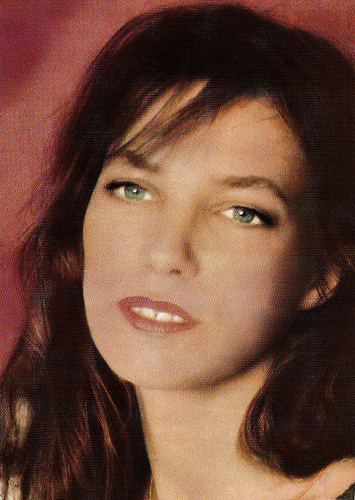
Romanian postcard by Casa Filmului Acin, no. 33102.
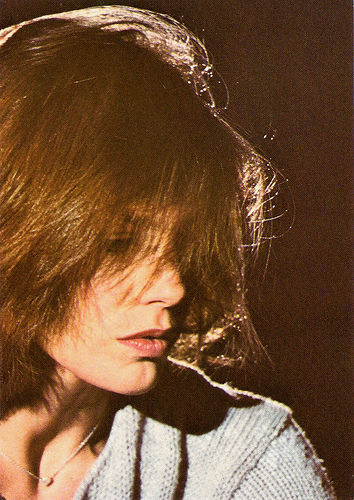
French postcard. Photo: Raymond Bounon / Phonogram. Publicity still for the record 'Baby alone in Babylone' (1983).
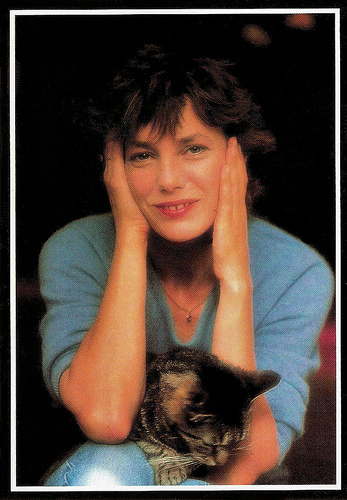
French postcard by Éditions Damilla, Paris, no. 95022. Photo: R. Melloul / SYGMA.
A mythical and passionate Paris love story
Jane Mallory Birkin was born in London in 1946. Her mother, Judy Campbell, was an English stage actress, and her father, David Birkin, was a Royal Navy lieutenant-commander, who had worked on clandestine operations as a navigator with the French Resistance. Her brother is the screenwriter and director Andrew Birkin. She was educated at Upper Chine School, Isle of Wight, and then went to Kensington Academy in London.
At 17, she first went on stage in Graham Greene's 1964 production 'Carving a Statue'. A year later, she was chosen to play in the musical comedy 'Passion Flower Hotel' with music by John Barry, the composer of the James Bond theme. They met and married shortly afterwards. Their daughter Kate Barry, now a photographer, was born in 1967.
Jane emerged in the Swinging London scene of the 1960s. First, she appeared uncredited as a girl on a motorbike in the comedy The Knack …and How to Get It (Richard Lester, 1965) starring Rita Tushingham. Then she attracted attention with a brief scene as a nude, blonde model in Blowup (1966), Michelangelo Antonioni's scandalous masterpiece that received the Palme d'Or award at the Cannes Film Festival.
In 1968, Birkin played a fantasy-like model in the psychedelic picture Wonderwall (Joe Massot, 1968). That same year, she auditioned in France for the lead female role in Slogan (Pierre Grimblat, 1969) with pop star Serge Gainsbourg , who was still grieving after his break up with Brigitte Bardot . Jane barely spoke French, and Gainsbourg gave her a rough time. When she burst into tears, mixing private sadness about John Barry and the film part, he disapproved, but he recognised that she cried well in front of the camera. Jane got the part, and a mythical and passionate Paris love story began.
Birkin performed with Gainsbourg on the film's theme song, 'La chanson de slogan' - the first of many collaborations between the two. They became inseparable and a living legend when they recorded the duet 'Je t'aime... moi non plus' (I love you... me neither), a song Gainsbourg originally had written for Brigitte Bardot . The song's fame is partly a result of its salacious lyrics, sung by Gainsbourg and Birkin to a background of passionate whispering and moaning from Birkin, concluding in her simulated orgasm. Censorship in several countries went wild, the Vatican condemned the immoral nature of the song, and in Great Britain, the BBC refused to play the original and did their own orchestral version. The record benefitted from all the free publicity and rocketed straight to the top of the charts, selling a million copies in a matter of months.
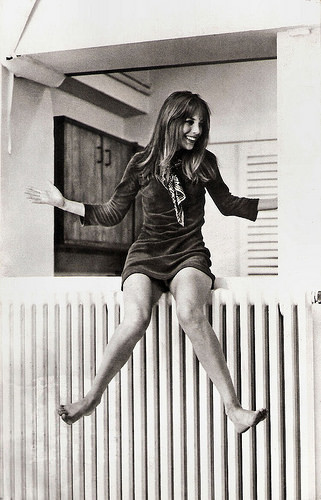
Romanian postcard by Casa Filmului Acin, no. 448. Photo: publicity still for Slogan (Pierre Grimblat, 1969).
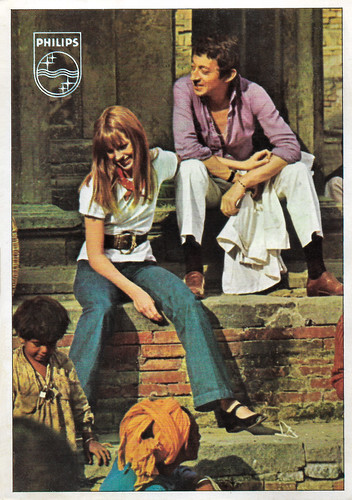
French collectors card in the Hit Collection series by Figurine Panini, no. 66. Photo: Philips. Jane Birkin and Serge Gainsbourg.
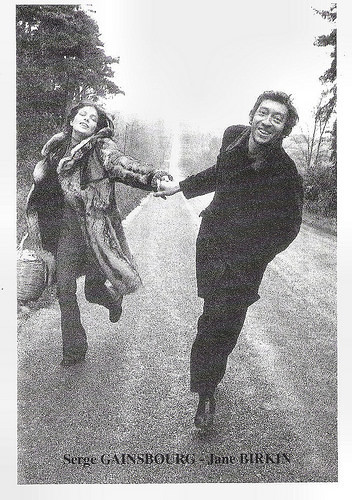
French card. With Serge Gainsbourg .
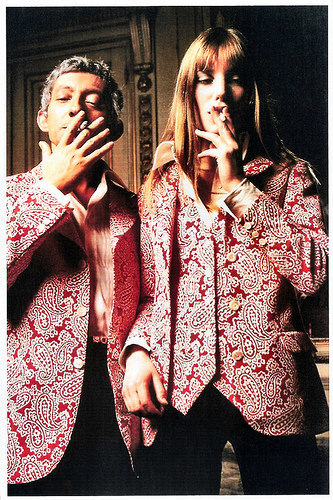
French autograph card. With Serge Gainsbourg .
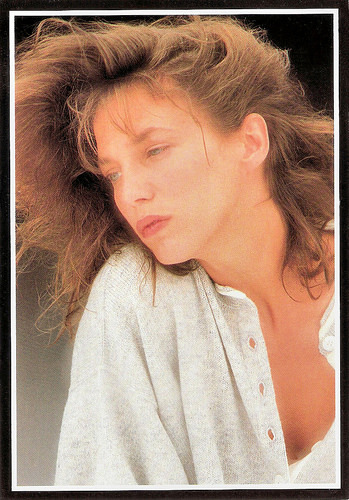
French postcard by Éditions Damilla, Paris, no. 95023. Photo: Dominique Issermann / SYGMA.
Cute but stupid
At the Côte d'Azur, Jane Birkin played in the thriller La Piscine/The Swimming Pool (Jacques Deray, 1969) in which she was seduced by Alain Delon . Then she went with Serge Gainsbourg to Yugoslavia to play in the adventure film Romansa konjokradice/Romance of a horse thief (Abraham Polonsky, 1971) starring Yul Brynner .
In 1971, her daughter, the actress and singer Charlotte Gainsbourg was born. Birkin took a break from acting, but returned as the lover of Brigitte Bardot (in her final film role) in Don Juan ou Si Don Juan était une femme.../Don Juan 73 (Roger Vadim, 1973). Her first solo album, 'Di Doo Dah', was also released in 1973. The title song became another chart hit.
In the cinema, Birkin played 'cute but stupid' roles in such box office hits as La moutarde me monte au nez/Lucky Pierre (Claude Zidi, 1974) and La course à l’échalotte/The Wild Goose Chase (Claude Zidi, 1975), two popular comedies starring Pierre Richard . She proved herself as a film actress in Le Mouton enragé/Love at the Top (Michel Deville, 1974) starring Romy Schneider , and the highly dramatic Sept morts sur ordonnance/Seven Deaths by Prescription (Jacques Rouffio, 1975) opposite Michel Piccoli .
In 1975, she also appeared as an androgynous-looking teenager opposite Joe Dallesandro in Gainsbourg's daring directorial début Je t'aime... moi non plus (Serge Gainsbourg, 1976). The film created a stir for its frank examination of sexual ambiguity and controversial sex scenes. In the following year, she had a cameo as herself in the blockbuster L'Animal/Stuntwoman (Claude Zidi, 1977) starring Jean-Paul Belmondo . In the meantime, her second album 'Lolita go home' (1975) came out, on which she sang Philippe Labro's lyrics set to Gainsbourg's music. Three years later, her 'Ex-fan des sixties' (1978) was released.
Birkin appeared in a series of mainstream films such as the Agatha Christie films Death on the Nile (John Guillermin, 1978) and Evil Under the Sun (Guy Hamilton, 1982), with Peter Ustinov as Belgian detective Hercule Poirot. In the arthouse production Egon Schiele Exzess und Bestrafung/Egon Schiele: Excess and Punishment (Herbert Vesely, 1980), she appeared as the mistress of Austrian artist Egon Schiele, played by Mathieu Carrière .
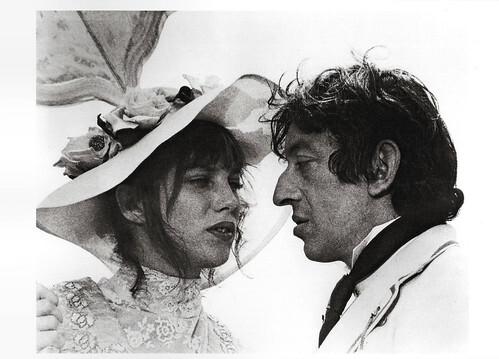
Swiss postcard by News Productions / CVB Publishers / Filmwelt, no. 57283. Photo: Collection Cinémathèque Suisse, Lausanne. Jane Birkin and Serge Gainsbourg in Romance of a Horsethief (Abraham Polonsky, 1972).
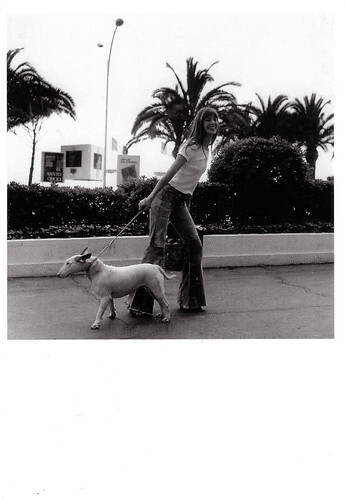
French postcard by Editions Cahiers de cinéma, Paris, 1997. Photo: Traverso. Caption: Jane Birkin, Festival de Cannes 1974.
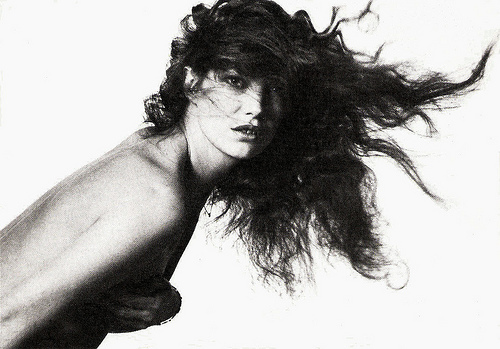
French postcard by Ëditions du Désastre, Boulogne, no. PK 2, 1982. Photo: Peter Knapp, 1980.
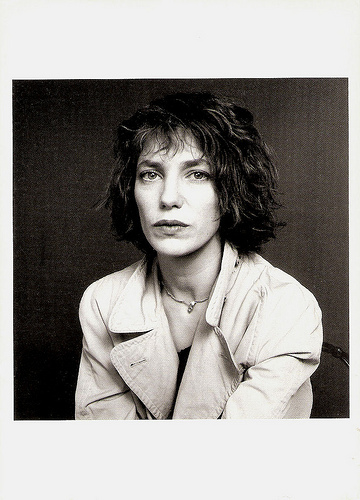
Swiss postcard by Musée de l'Elysée/News Productions, Baulmes, no. 55594. Photo: Laurence Sudre.
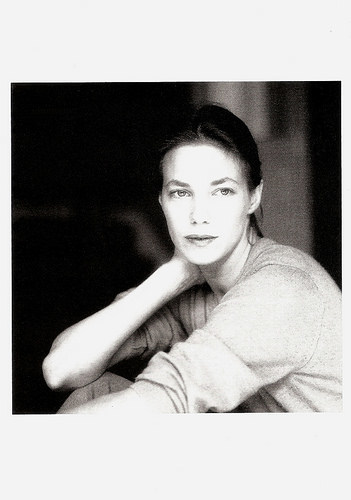
French postcard by Editions Marion-Valentine, Paris, no. N-177. Photo: Dominique Issermann. Caption: Jane Birkin 1981.
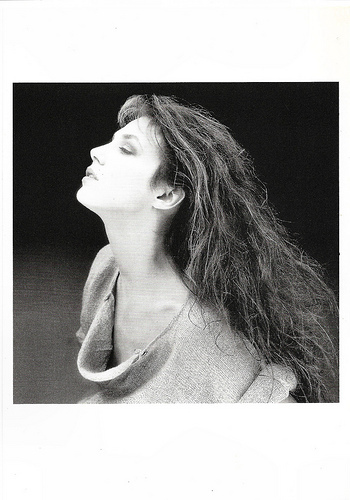
French postcard by Editions Marion-Valentine, Paris, no. N-176. Photo: Dominique Issermann. Caption: Jane Birkin 1983.
The very best of her
Serge Gainsbourg had plunged into several major bouts of alcoholism and depression, resulting in all-night partying and scandals, and in 1980 Jane Birkin left him. The couple remained on good terms though. Birkin starred as Anne in La fille prodigue/The Prodigal Daughter (Jacques Doillon, 1981). Jacques Doillon proved to be her dream of a director, who imposed his own personal style of drama and brought out the very best of her. She went to live with him, and in 1982 she had her third daughter Lou Doillon. She also appeared as Alma opposite Maruschka Detmers in his film La pirate/The Pirate (Jacques Doillon, 1984), for which she was nominated for a César Award. This work led to an invitation from theatre director Patrice Chéreau to star on stage in 'La Fausse suivante' (The False Servant) by Pierre de Marivaux. Gainsbourg, suffering from the separation, wrote 'Baby alone in Babylone' for her. The record won the Charles Cross award and became a gold record.
Jane Birkin began to appear frequently on stage in plays and concerts in France, Japan, the U.K., and then the U.S. In the cinema, she received another César Award nomination for her role in La femme de ma vie/The Woman of My Life (Régis Wargnier, 1986). Film director Jacques Rivette collaborated with her in L'amour par terre/Love on the Ground (Jacques Rivette, 1983) starring Geraldine Chaplin , and La Belle Noiseuse/The Beautiful Troublemaker (Jacques Rivette, 1991) with Michel Piccoli and Emmanuelle Béart . For the latter film, Birkin was nominated for the César for best supporting actress. She created a sensation as the star and screenwriter of director Agnès Varda's Kung Fu Master (1987), in which she played a 40-year-old woman carrying on a torrid affair with a 15-year-old boy, played by Mathieu Demy, Varda's son. The following year, Varda expressed her admiration for Birkin with the feature-length documentary Jane B. par Agnes V (Agnès Varda, 1988).
Birkin’s work in Dust (Marion Hänsel, 1985) with Trevor Howard and Daddy Nostalgie (Bertrand Tavernier, 1990) opposite Dirk Bogarde also earned her the praise and respect of international critics. Additionally, she appeared in Merchant-Ivory's A Soldier's Daughter Never Cries (James Ivory, 1998) and Merci Docteur Rey (Andrew Litvack, 2002) with Dianne Wiest, while the end title song of Le Divorce (James Ivory, 2003) featured her singing 'L'Anamour', composed by Serge Gainsbourg . In 1990 Serge Gainsbourg dedicated a new album to her: 'Amours des feintes'. It was to be his last. He died in 1991. A year later Birkin won the Female Artist of the Year award at the 1992 Victoires de la Musique. In 1993 she separated from Jacques Doillon. In the following years, she devoted herself to her family and to her humanitarian work with Amnesty International on immigrant welfare and AIDS issues. Birkin visited Bosnia, Rwanda, and Palestine, often working with children.
In 2001, she was awarded the OBE in Great Britain. She has also been awarded the French Ordre National du Mérite in 2004. Jane Birkin continues to make films, theatre, and music. She collaborated with such artists as Bryan Ferry, Manu Chao, Françoise Hardy , Rufus Wainwright, and Les Negresses Vertes on albums such as 'Rendez-Vous' (2004) and 'Fictions' (2006). The self-penned 'Enfants d'Hiver' arrived in 2008. In 2006, Birkin played the title role in 'Elektra', directed by Philippe Calvario in France. At the Cannes Film Festival 2007, she presented a film, both as a director and actor: Boxes (2007) with Michel Piccoli , Geraldine Chaplin , and her daughter Lou Doillon.
She also appeared in Si tu meurs, je te tue/If you die, I’ll kill you (Hiner Saleem, 2011) with Jonathan Zaccaï, and La femme et le TGV/The Railroad Lady (2016), a short film directed by Swiss filmmaker Timo von Gunten. The film was nominated for an Academy Award for Best Live-Action Short Film. In a 2017 interview, Birkin stated that La femme et le TGV would be her final acting performance and that she had no plans to return to acting. In March 2017, Jane Birkin released 'Birkin/Gainsbourg: Le Symphonique', a collection of songs Serge Gainsbourg had written for her during and after their relationship, reworked with full orchestral arrangements. In 2021, she suffered a stroke. Her declining health forced her to cancel performances frequently. Birkin was found dead in her Paris home by her personal nurse on 16 July 2023. She was 76 years old. In January 2022, an intimate and touching documentary about her has been released in French cinemas Jane par Charlotte. It was directed by her daughter, Charlotte Gainsbourg .
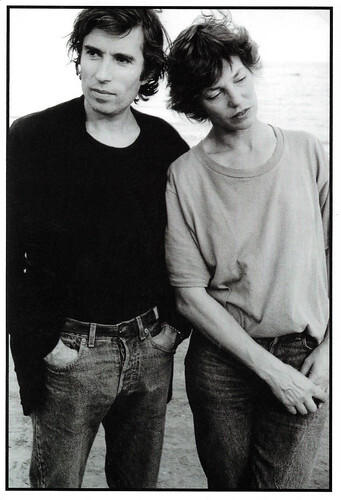
French postcard. Photo: Catherine Faux. Caption: Jane Birkin - Jacques Doillon, Venice 1987.
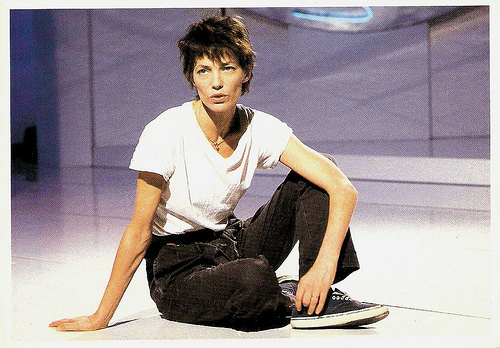
French postcard, no. C 4477.
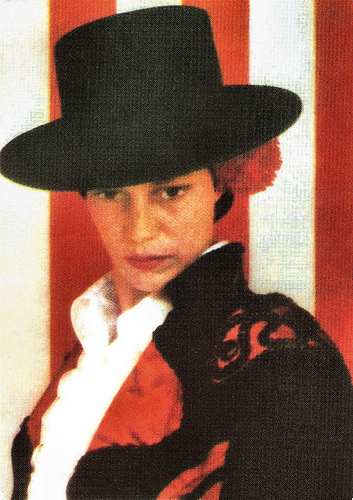
Romanian postcard by Casa Filmului Acin. Photo: publicity still for Jane B. par Agnes V. (Agnes Varda, 1987).
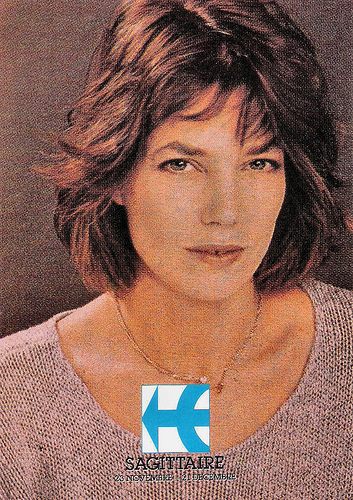
French postcard in the Signes du Zodiaque series by Editions F. Nugeron, no. 13 - Sagittaire (Sagittarius).
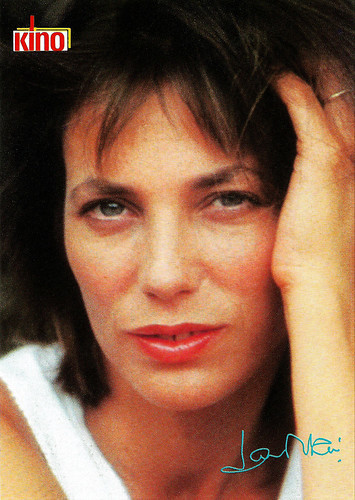
German autograph card by Kino.
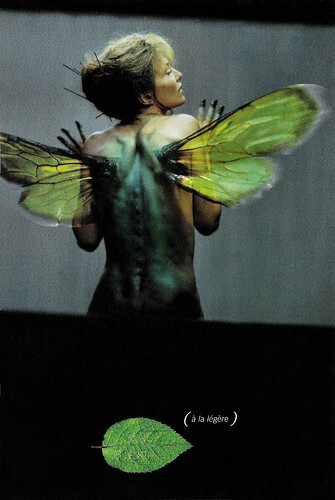
French postcard by Mercury / Polygram. Photo: Laurent Seroussi. Caption: à la légère. The album 'À la Légère' was released in 1998.
Trailer Wonderwall (1968). Source: Screenbound Pictures (YouTube).
Trailer Slogan (1969). Source: 7173Productions (YouTube).
Sources: Hal Erickson (AllMovie), John Bush (AllMusic), RFI Musique (now defunct), Wikipedia, and .

French postcard by V, Paris, no. 95022. Photo: Bernard Leloup / Salut. Promotion card for the Fontana album 'Ex fan des sixties'.

French postcard in the Collection Cinéma Couleur by Editions La Malibran, Paris / Nancy, no. MC 26. Photo: J. Kovalnick. Serge Gainsbourg and Jane Birkin in Cannabis (Pierre Koralnik, 1969).

Romanian postcard by Casa Filmului Acin, no. 33102.

French postcard. Photo: Raymond Bounon / Phonogram. Publicity still for the record 'Baby alone in Babylone' (1983).

French postcard by Éditions Damilla, Paris, no. 95022. Photo: R. Melloul / SYGMA.
A mythical and passionate Paris love story
Jane Mallory Birkin was born in London in 1946. Her mother, Judy Campbell, was an English stage actress, and her father, David Birkin, was a Royal Navy lieutenant-commander, who had worked on clandestine operations as a navigator with the French Resistance. Her brother is the screenwriter and director Andrew Birkin. She was educated at Upper Chine School, Isle of Wight, and then went to Kensington Academy in London.
At 17, she first went on stage in Graham Greene's 1964 production 'Carving a Statue'. A year later, she was chosen to play in the musical comedy 'Passion Flower Hotel' with music by John Barry, the composer of the James Bond theme. They met and married shortly afterwards. Their daughter Kate Barry, now a photographer, was born in 1967.
Jane emerged in the Swinging London scene of the 1960s. First, she appeared uncredited as a girl on a motorbike in the comedy The Knack …and How to Get It (Richard Lester, 1965) starring Rita Tushingham. Then she attracted attention with a brief scene as a nude, blonde model in Blowup (1966), Michelangelo Antonioni's scandalous masterpiece that received the Palme d'Or award at the Cannes Film Festival.
In 1968, Birkin played a fantasy-like model in the psychedelic picture Wonderwall (Joe Massot, 1968). That same year, she auditioned in France for the lead female role in Slogan (Pierre Grimblat, 1969) with pop star Serge Gainsbourg , who was still grieving after his break up with Brigitte Bardot . Jane barely spoke French, and Gainsbourg gave her a rough time. When she burst into tears, mixing private sadness about John Barry and the film part, he disapproved, but he recognised that she cried well in front of the camera. Jane got the part, and a mythical and passionate Paris love story began.
Birkin performed with Gainsbourg on the film's theme song, 'La chanson de slogan' - the first of many collaborations between the two. They became inseparable and a living legend when they recorded the duet 'Je t'aime... moi non plus' (I love you... me neither), a song Gainsbourg originally had written for Brigitte Bardot . The song's fame is partly a result of its salacious lyrics, sung by Gainsbourg and Birkin to a background of passionate whispering and moaning from Birkin, concluding in her simulated orgasm. Censorship in several countries went wild, the Vatican condemned the immoral nature of the song, and in Great Britain, the BBC refused to play the original and did their own orchestral version. The record benefitted from all the free publicity and rocketed straight to the top of the charts, selling a million copies in a matter of months.

Romanian postcard by Casa Filmului Acin, no. 448. Photo: publicity still for Slogan (Pierre Grimblat, 1969).

French collectors card in the Hit Collection series by Figurine Panini, no. 66. Photo: Philips. Jane Birkin and Serge Gainsbourg.

French card. With Serge Gainsbourg .

French autograph card. With Serge Gainsbourg .

French postcard by Éditions Damilla, Paris, no. 95023. Photo: Dominique Issermann / SYGMA.
Cute but stupid
At the Côte d'Azur, Jane Birkin played in the thriller La Piscine/The Swimming Pool (Jacques Deray, 1969) in which she was seduced by Alain Delon . Then she went with Serge Gainsbourg to Yugoslavia to play in the adventure film Romansa konjokradice/Romance of a horse thief (Abraham Polonsky, 1971) starring Yul Brynner .
In 1971, her daughter, the actress and singer Charlotte Gainsbourg was born. Birkin took a break from acting, but returned as the lover of Brigitte Bardot (in her final film role) in Don Juan ou Si Don Juan était une femme.../Don Juan 73 (Roger Vadim, 1973). Her first solo album, 'Di Doo Dah', was also released in 1973. The title song became another chart hit.
In the cinema, Birkin played 'cute but stupid' roles in such box office hits as La moutarde me monte au nez/Lucky Pierre (Claude Zidi, 1974) and La course à l’échalotte/The Wild Goose Chase (Claude Zidi, 1975), two popular comedies starring Pierre Richard . She proved herself as a film actress in Le Mouton enragé/Love at the Top (Michel Deville, 1974) starring Romy Schneider , and the highly dramatic Sept morts sur ordonnance/Seven Deaths by Prescription (Jacques Rouffio, 1975) opposite Michel Piccoli .
In 1975, she also appeared as an androgynous-looking teenager opposite Joe Dallesandro in Gainsbourg's daring directorial début Je t'aime... moi non plus (Serge Gainsbourg, 1976). The film created a stir for its frank examination of sexual ambiguity and controversial sex scenes. In the following year, she had a cameo as herself in the blockbuster L'Animal/Stuntwoman (Claude Zidi, 1977) starring Jean-Paul Belmondo . In the meantime, her second album 'Lolita go home' (1975) came out, on which she sang Philippe Labro's lyrics set to Gainsbourg's music. Three years later, her 'Ex-fan des sixties' (1978) was released.
Birkin appeared in a series of mainstream films such as the Agatha Christie films Death on the Nile (John Guillermin, 1978) and Evil Under the Sun (Guy Hamilton, 1982), with Peter Ustinov as Belgian detective Hercule Poirot. In the arthouse production Egon Schiele Exzess und Bestrafung/Egon Schiele: Excess and Punishment (Herbert Vesely, 1980), she appeared as the mistress of Austrian artist Egon Schiele, played by Mathieu Carrière .

Swiss postcard by News Productions / CVB Publishers / Filmwelt, no. 57283. Photo: Collection Cinémathèque Suisse, Lausanne. Jane Birkin and Serge Gainsbourg in Romance of a Horsethief (Abraham Polonsky, 1972).

French postcard by Editions Cahiers de cinéma, Paris, 1997. Photo: Traverso. Caption: Jane Birkin, Festival de Cannes 1974.

French postcard by Ëditions du Désastre, Boulogne, no. PK 2, 1982. Photo: Peter Knapp, 1980.

Swiss postcard by Musée de l'Elysée/News Productions, Baulmes, no. 55594. Photo: Laurence Sudre.

French postcard by Editions Marion-Valentine, Paris, no. N-177. Photo: Dominique Issermann. Caption: Jane Birkin 1981.

French postcard by Editions Marion-Valentine, Paris, no. N-176. Photo: Dominique Issermann. Caption: Jane Birkin 1983.
The very best of her
Serge Gainsbourg had plunged into several major bouts of alcoholism and depression, resulting in all-night partying and scandals, and in 1980 Jane Birkin left him. The couple remained on good terms though. Birkin starred as Anne in La fille prodigue/The Prodigal Daughter (Jacques Doillon, 1981). Jacques Doillon proved to be her dream of a director, who imposed his own personal style of drama and brought out the very best of her. She went to live with him, and in 1982 she had her third daughter Lou Doillon. She also appeared as Alma opposite Maruschka Detmers in his film La pirate/The Pirate (Jacques Doillon, 1984), for which she was nominated for a César Award. This work led to an invitation from theatre director Patrice Chéreau to star on stage in 'La Fausse suivante' (The False Servant) by Pierre de Marivaux. Gainsbourg, suffering from the separation, wrote 'Baby alone in Babylone' for her. The record won the Charles Cross award and became a gold record.
Jane Birkin began to appear frequently on stage in plays and concerts in France, Japan, the U.K., and then the U.S. In the cinema, she received another César Award nomination for her role in La femme de ma vie/The Woman of My Life (Régis Wargnier, 1986). Film director Jacques Rivette collaborated with her in L'amour par terre/Love on the Ground (Jacques Rivette, 1983) starring Geraldine Chaplin , and La Belle Noiseuse/The Beautiful Troublemaker (Jacques Rivette, 1991) with Michel Piccoli and Emmanuelle Béart . For the latter film, Birkin was nominated for the César for best supporting actress. She created a sensation as the star and screenwriter of director Agnès Varda's Kung Fu Master (1987), in which she played a 40-year-old woman carrying on a torrid affair with a 15-year-old boy, played by Mathieu Demy, Varda's son. The following year, Varda expressed her admiration for Birkin with the feature-length documentary Jane B. par Agnes V (Agnès Varda, 1988).
Birkin’s work in Dust (Marion Hänsel, 1985) with Trevor Howard and Daddy Nostalgie (Bertrand Tavernier, 1990) opposite Dirk Bogarde also earned her the praise and respect of international critics. Additionally, she appeared in Merchant-Ivory's A Soldier's Daughter Never Cries (James Ivory, 1998) and Merci Docteur Rey (Andrew Litvack, 2002) with Dianne Wiest, while the end title song of Le Divorce (James Ivory, 2003) featured her singing 'L'Anamour', composed by Serge Gainsbourg . In 1990 Serge Gainsbourg dedicated a new album to her: 'Amours des feintes'. It was to be his last. He died in 1991. A year later Birkin won the Female Artist of the Year award at the 1992 Victoires de la Musique. In 1993 she separated from Jacques Doillon. In the following years, she devoted herself to her family and to her humanitarian work with Amnesty International on immigrant welfare and AIDS issues. Birkin visited Bosnia, Rwanda, and Palestine, often working with children.
In 2001, she was awarded the OBE in Great Britain. She has also been awarded the French Ordre National du Mérite in 2004. Jane Birkin continues to make films, theatre, and music. She collaborated with such artists as Bryan Ferry, Manu Chao, Françoise Hardy , Rufus Wainwright, and Les Negresses Vertes on albums such as 'Rendez-Vous' (2004) and 'Fictions' (2006). The self-penned 'Enfants d'Hiver' arrived in 2008. In 2006, Birkin played the title role in 'Elektra', directed by Philippe Calvario in France. At the Cannes Film Festival 2007, she presented a film, both as a director and actor: Boxes (2007) with Michel Piccoli , Geraldine Chaplin , and her daughter Lou Doillon.
She also appeared in Si tu meurs, je te tue/If you die, I’ll kill you (Hiner Saleem, 2011) with Jonathan Zaccaï, and La femme et le TGV/The Railroad Lady (2016), a short film directed by Swiss filmmaker Timo von Gunten. The film was nominated for an Academy Award for Best Live-Action Short Film. In a 2017 interview, Birkin stated that La femme et le TGV would be her final acting performance and that she had no plans to return to acting. In March 2017, Jane Birkin released 'Birkin/Gainsbourg: Le Symphonique', a collection of songs Serge Gainsbourg had written for her during and after their relationship, reworked with full orchestral arrangements. In 2021, she suffered a stroke. Her declining health forced her to cancel performances frequently. Birkin was found dead in her Paris home by her personal nurse on 16 July 2023. She was 76 years old. In January 2022, an intimate and touching documentary about her has been released in French cinemas Jane par Charlotte. It was directed by her daughter, Charlotte Gainsbourg .

French postcard. Photo: Catherine Faux. Caption: Jane Birkin - Jacques Doillon, Venice 1987.

French postcard, no. C 4477.

Romanian postcard by Casa Filmului Acin. Photo: publicity still for Jane B. par Agnes V. (Agnes Varda, 1987).

French postcard in the Signes du Zodiaque series by Editions F. Nugeron, no. 13 - Sagittaire (Sagittarius).

German autograph card by Kino.

French postcard by Mercury / Polygram. Photo: Laurent Seroussi. Caption: à la légère. The album 'À la Légère' was released in 1998.
Trailer Wonderwall (1968). Source: Screenbound Pictures (YouTube).
Trailer Slogan (1969). Source: 7173Productions (YouTube).
Sources: Hal Erickson (AllMovie), John Bush (AllMusic), RFI Musique (now defunct), Wikipedia, and .
Published on July 16, 2023 23:00
Rita Gam
Glamorous American film and television actress Rita Gam (1927-2016) made a promising debut in the Film Noir The Thief (1952), but her subsequent Hollywood roles were largely unrewarding. She appeared in European films and won a Silver Bear at the Berlin International Film Festival for the Sartre adaptation No Exit (1962). Gam also worked as a documentary filmmaker.
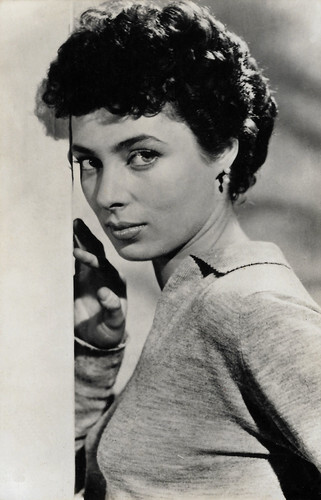
Spanish postcard. Photo: 20th Century Fox. Rita Gam in Night People (Nunnally Johnson, 1954).
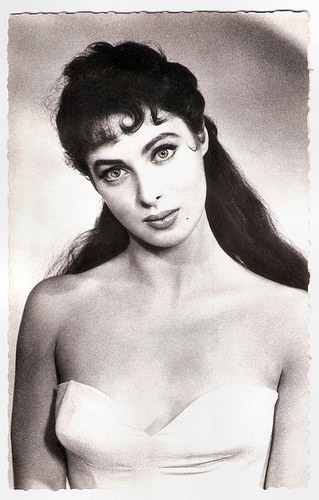
French postcard by Editions du Globe, Paris, no.479. Photo: International Press.
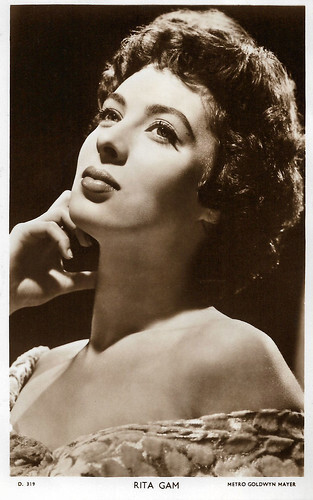
British postcard in the Picturegoer Series, London, no. D. 319. Photo: Metro-Goldwyn-Mayer.
Grace Kelly's bridesmaid
Rita Gam was born Rita Eleanore MacKay in Pittsburgh, Pennsylvania, in 1927. She was the daughter of Belle (Fately), a Romanian Jewish immigrant, and Milton A. MacKay. Her mother remarried in 1932. She took on the surname of her stepfather, Benjamin Gam, a Russian Jewish immigrant. Gam was raised in New York City.
Gam was a founding member of the Actor's Studio. She landed a role on Broadway in 1946 in 'A Flag Is Born', written by Ben Hecht. She also began to work on television, after which she moved on to films.
She first appeared in the Film Noir The Thief (Russell Rouse, 1952), which starred Ray Milland . The film is unusual because the entire story is told without dialogue. Gam was nominated for a Golden Globe as Most Promising Newcomer. Craig Butler at AllMovie : "Rouse brilliantly finds ways of telling the story without sacrificing any tension, suspense, or emotional impact. working with cinematographer Sam Leavitt, whose noir-ish camerawork is nothing short of a marvel, he shapes and tells the story in a compelling and gripping manner."
In October 1952, she signed a long-term MGM contract. She was briefly suspended from working in October 1953 for turning down the feminine lead in the Dean Martin - Jerry Lewis comedy Living It Up (Norman Taurog, 1954). The part went to Janet Leigh. Another interesting Film Noir was Night People (Nunnally Johnson, 1954). The story is set in Berlin during the years following World War II. Gregory Peck plays a counter-intelligence officer of the United States Army. That year she also appeared in Sign of the Pagan (Douglas Sirk, 1954) about Attila the Hun ( Jack Palance ) and his invasion of Rome.
In 1956, she was a bridesmaid at her good friend Grace Kelly 's wedding to Prince Rainier of Monaco. Soon after Gam and Kelly had signed contracts with MGM, they roomed together with another girl in a one-bedroom apartment in Hollywood. They remained close until Kelly's death in 1982. In Italy, she starred opposite Alberto Sordi in the comedy Costa Azzurra/Wild Cats on the Beach (Vittorio Sala, 1959) and she was the leading lady of the Peplum Annibale/Hannibal (Carlo Ludovico Bragaglia, Edgar G. Ulmer, 1959) featuring Victor Mature . Despite being an Italian production the latter was mainly financed by American studio Warner Brothers.
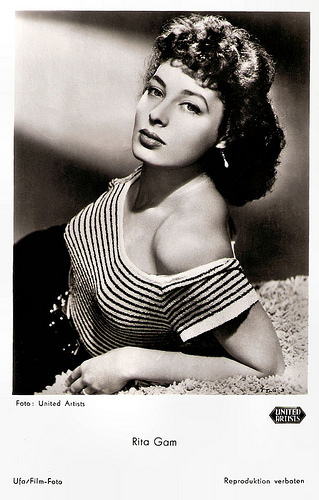
German postcard by Ufa, Berlin-Tempelhof, no. FK 672. Photo: United Artists. Publicity still for The Thief (Russell Rouse, 1952).
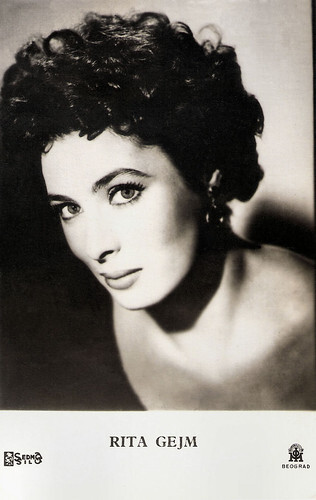
Yugoslavian postcard by Sedma Sila / IOM, Beograd. Sent by mail in 1963.
Trapped like rats in a cage
Rita Gam played Herodias in the biblical epic film King of Kings (Nicholas Ray, 1961) about the life of Christ ( Jeffrey Hunter ), from his birth and ministry to his crucifixion and resurrection.
Gam shared the Silver Bear for Best Actress award with Viveca Lindfors at the 1962 Berlin Film Festival, for their performances in No Exit (Tad Danielewski, Orson Welles (uncredited), 1962), based on the play Huis Clos by Jean-Paul Sartre. The story is about three people locked in a room: a journalist who betrayed members of the resistance movement in World War II (Morgan Sterne), a lesbian who tempted a married woman to leave her husband (Lindfors), and a social climber (Gam) who killed her son and drove her husband to suicide. They quickly discover there is literally no exit in the room: they are trapped like rats in a cage, dead and in hell.
In 1963, Gam became a leading member of The Minnesota Theatre Company in the opening season of The Tyrone Guthrie Theater in Minneapolis, with Zoe Caldwell, Hume Cronyn and Jessica Tandy. Later she appeared in small parts in films like the acclaimed crime thriller Klute (Alan J. Pakula, 1971), before taking up documentary filmmaking. She produced the documentary series World of Film, which examined the film business around the world, and the PBS travel series World of Beauty.
Her final film appearance was in the Canadian-Japanese sports drama Rowing Through (Masato Harada, 1996). In 2003, she was in the rotating cast of the off-Broadway stage reading of 'Wit & Wisdom'. Among her other notable stage productions were 'Hamlet' with Dan Mason and Broadway's 'There’s a Girl in My Soup' with Gig Young.
Rita Gam died of respiratory failure at Cedars-Sinai Medical Center in Los Angeles. She was married from 1949 to 1954 to director Sidney Lumet and from 1956 to 1963 to Thomas Henry Guinzburg, Jr., the first managing editor of The Paris Review and president of Viking Press. Survivors include her daughter, film producer Kate Guinzburg, her son, novelist Michael Guinzburg; and granddaughters Michelle, Olivia and Louisa.
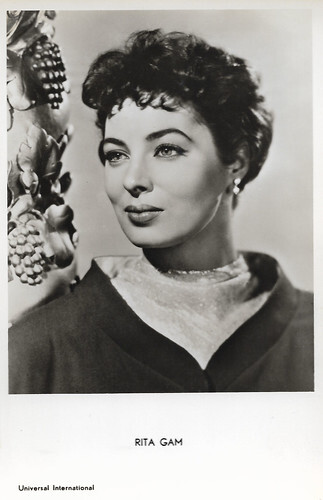
Belgian postcard offered by Korès Carboplane, no. 101. Photo: Universal International.
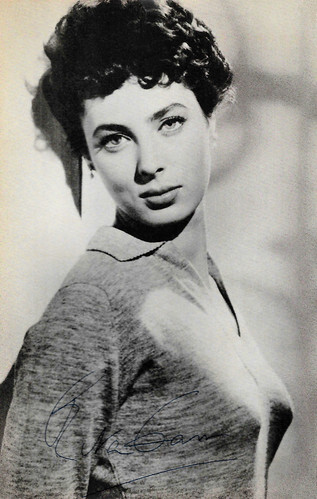
British postcard in the Celebrity Autograph Series, no. 103. Photo: 20th Century Fox. Rita Gam in Night People (Nunnally Johnson, 1954).
Sources: Mike Barnes (The Hollywood Reporter), Hal Erickson (AllMovie), Craig Butler (AllMovie), Wikipedia and .

Spanish postcard. Photo: 20th Century Fox. Rita Gam in Night People (Nunnally Johnson, 1954).

French postcard by Editions du Globe, Paris, no.479. Photo: International Press.

British postcard in the Picturegoer Series, London, no. D. 319. Photo: Metro-Goldwyn-Mayer.
Grace Kelly's bridesmaid
Rita Gam was born Rita Eleanore MacKay in Pittsburgh, Pennsylvania, in 1927. She was the daughter of Belle (Fately), a Romanian Jewish immigrant, and Milton A. MacKay. Her mother remarried in 1932. She took on the surname of her stepfather, Benjamin Gam, a Russian Jewish immigrant. Gam was raised in New York City.
Gam was a founding member of the Actor's Studio. She landed a role on Broadway in 1946 in 'A Flag Is Born', written by Ben Hecht. She also began to work on television, after which she moved on to films.
She first appeared in the Film Noir The Thief (Russell Rouse, 1952), which starred Ray Milland . The film is unusual because the entire story is told without dialogue. Gam was nominated for a Golden Globe as Most Promising Newcomer. Craig Butler at AllMovie : "Rouse brilliantly finds ways of telling the story without sacrificing any tension, suspense, or emotional impact. working with cinematographer Sam Leavitt, whose noir-ish camerawork is nothing short of a marvel, he shapes and tells the story in a compelling and gripping manner."
In October 1952, she signed a long-term MGM contract. She was briefly suspended from working in October 1953 for turning down the feminine lead in the Dean Martin - Jerry Lewis comedy Living It Up (Norman Taurog, 1954). The part went to Janet Leigh. Another interesting Film Noir was Night People (Nunnally Johnson, 1954). The story is set in Berlin during the years following World War II. Gregory Peck plays a counter-intelligence officer of the United States Army. That year she also appeared in Sign of the Pagan (Douglas Sirk, 1954) about Attila the Hun ( Jack Palance ) and his invasion of Rome.
In 1956, she was a bridesmaid at her good friend Grace Kelly 's wedding to Prince Rainier of Monaco. Soon after Gam and Kelly had signed contracts with MGM, they roomed together with another girl in a one-bedroom apartment in Hollywood. They remained close until Kelly's death in 1982. In Italy, she starred opposite Alberto Sordi in the comedy Costa Azzurra/Wild Cats on the Beach (Vittorio Sala, 1959) and she was the leading lady of the Peplum Annibale/Hannibal (Carlo Ludovico Bragaglia, Edgar G. Ulmer, 1959) featuring Victor Mature . Despite being an Italian production the latter was mainly financed by American studio Warner Brothers.

German postcard by Ufa, Berlin-Tempelhof, no. FK 672. Photo: United Artists. Publicity still for The Thief (Russell Rouse, 1952).

Yugoslavian postcard by Sedma Sila / IOM, Beograd. Sent by mail in 1963.
Trapped like rats in a cage
Rita Gam played Herodias in the biblical epic film King of Kings (Nicholas Ray, 1961) about the life of Christ ( Jeffrey Hunter ), from his birth and ministry to his crucifixion and resurrection.
Gam shared the Silver Bear for Best Actress award with Viveca Lindfors at the 1962 Berlin Film Festival, for their performances in No Exit (Tad Danielewski, Orson Welles (uncredited), 1962), based on the play Huis Clos by Jean-Paul Sartre. The story is about three people locked in a room: a journalist who betrayed members of the resistance movement in World War II (Morgan Sterne), a lesbian who tempted a married woman to leave her husband (Lindfors), and a social climber (Gam) who killed her son and drove her husband to suicide. They quickly discover there is literally no exit in the room: they are trapped like rats in a cage, dead and in hell.
In 1963, Gam became a leading member of The Minnesota Theatre Company in the opening season of The Tyrone Guthrie Theater in Minneapolis, with Zoe Caldwell, Hume Cronyn and Jessica Tandy. Later she appeared in small parts in films like the acclaimed crime thriller Klute (Alan J. Pakula, 1971), before taking up documentary filmmaking. She produced the documentary series World of Film, which examined the film business around the world, and the PBS travel series World of Beauty.
Her final film appearance was in the Canadian-Japanese sports drama Rowing Through (Masato Harada, 1996). In 2003, she was in the rotating cast of the off-Broadway stage reading of 'Wit & Wisdom'. Among her other notable stage productions were 'Hamlet' with Dan Mason and Broadway's 'There’s a Girl in My Soup' with Gig Young.
Rita Gam died of respiratory failure at Cedars-Sinai Medical Center in Los Angeles. She was married from 1949 to 1954 to director Sidney Lumet and from 1956 to 1963 to Thomas Henry Guinzburg, Jr., the first managing editor of The Paris Review and president of Viking Press. Survivors include her daughter, film producer Kate Guinzburg, her son, novelist Michael Guinzburg; and granddaughters Michelle, Olivia and Louisa.

Belgian postcard offered by Korès Carboplane, no. 101. Photo: Universal International.

British postcard in the Celebrity Autograph Series, no. 103. Photo: 20th Century Fox. Rita Gam in Night People (Nunnally Johnson, 1954).
Sources: Mike Barnes (The Hollywood Reporter), Hal Erickson (AllMovie), Craig Butler (AllMovie), Wikipedia and .
Published on July 16, 2023 22:00
July 15, 2023
Robert Young
Quiet, soft-spoken American actor Robert Young (1907-1998) had some stage experience with the Pasadena Playhouse before entering films in 1931. He played characters who were charming, good-looking - and bland. He was notable as the spy in Alfred Hitchcock's Secret Agent (1936), but he had his best roles during the 1940s. These included Western Union (1941), Claudia (1943) and Crossfire (1947). In 1949, Robert started the radio show 'Father Knows Best' as an average father in average situations. In 1954, the series went to television. From 1969 to 1976, he starred in the TV series Marcus Welby.

British `Real Photograph postcard, no. 93. Photo: Metro Goldwyn Mayer.
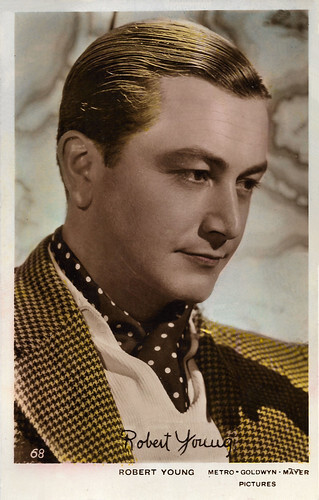
British Real Photograph postcard, no. 68. Photo: Metro-Goldwyn-Mayer.
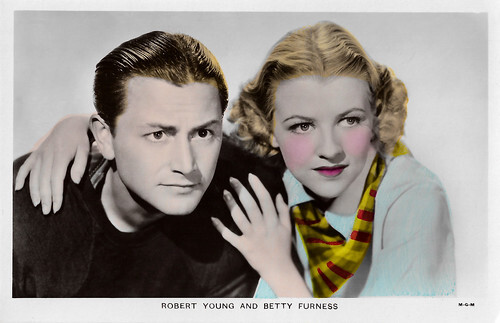
British postcard in the Film Partners Series, London, no. PC 157. Photo: Metro Goldwyn Mayer. Robert Young and Betty Furness in The Band Plays On (Russell Mack, 1934).
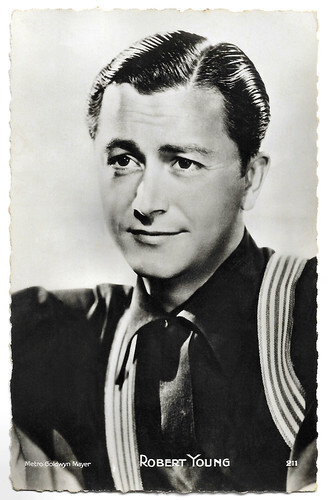
French postcard by Editions P.I., Paris, no. 211. Photo: Metro Goldwyn Mayer.
Friendly, positive and charming characters
Robert Young was born in Chicago in 1907. His older brother Joe Young was later known as actor Roger Moore, a mainstay character actor who appeared in hundreds of uncredited roles in films. Their family relocated to Los Angeles when Robert was seven. He was introduced to acting while attending Lincoln High School.
After graduation, he pursued an acting career and from 1927 to 1931, he studied acting at the Pasadena Playhouse, where he gained his first acting experience. Sharpening his acting abilities while touring with a stock company in their production, 'The Ship', a talent scout saw him, resulting in a screen test.
After a few movie-extra roles, Young had his first credited film role in the Charlie Chan Mystery The Black Camel (Hamilton MacFadden, 1931). He was signed by MGM to play a bit part as Helen Hayes' son in Sin of Madelon Claudet (Edgar Selwyn, 1931). At the request of MGM head Irving Thalberg, Young's role was expanded during shooting, thus the young actor was launched on the road to stardom.
In the 1930s, he was able to establish himself in significant roles. He usually played friendly, positive and charming characters who sometimes seemed a bit boring though, which is why Young didn't always get the leading lady at the end of the film. However, he did get Constance Cummings in the comedy mystery Remember Last Night? (James Whale, 1935). He got the chance for a slightly different type of role when he was lent to England by MGM and played a likeable American who turns out to be a cold-blooded spy in the thriller Secret Agent (1936) directed by Alfred Hitchcock .
He then starred in another elaborate British production, It's Love Again (Victor Saville, 1936) with Jessie Matthews . In 1940, he had great success alongside James Stewart in The Mortal Storm (Frank Borzage, 1940) and alongside Spencer Tracy in Northwest Passage (King Vidor, Jack Conway, W.S. Van Dyke, 1940). A year later he had arguably one of his best film roles in the title role of King Vidor's drama H.M. Pulham, Esq. (King Vidor, 1941) in which he played a stiff middle-aged businessman who sums up wasted life opportunities.
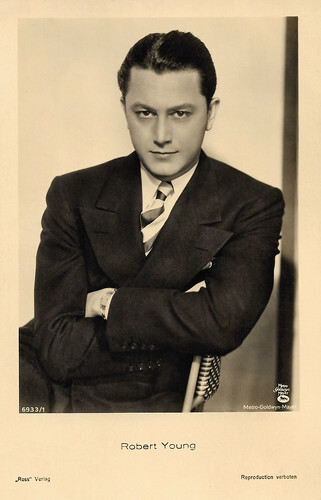
German postcard by Ross Verlag, no. 6933/1, 1931-1932. Photo: Metro Goldwyn Mayer.
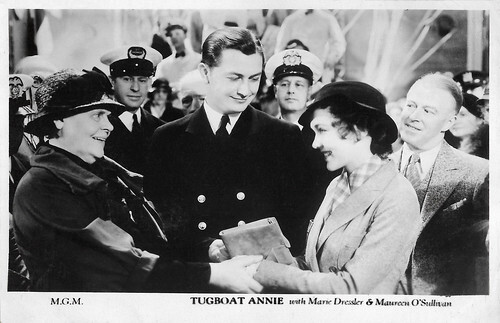
British postcard in the Filmshots series by Film Weekly. Photo: M.G.M. Marie Dressler , Robert Young and Maureen O'Sullivan in Tugboat Annie (Mervyn LeRoy, 1933).
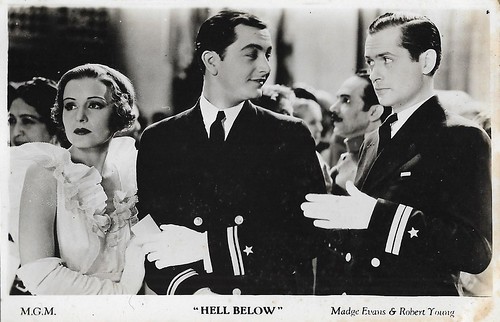
British postcard in the Filmshots series by Film Weekly. Photo: M.G.M. Madge Evans , Robert Young and Robert Montgomery in Hell Below (Jack Conway, 1933).
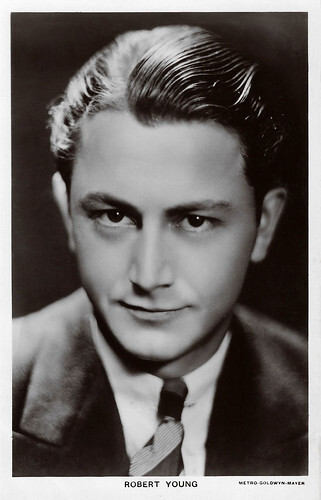
British postcard in the Picturegoer Series, London, no. 679a. Photo: Metro Goldwyn Mayer.
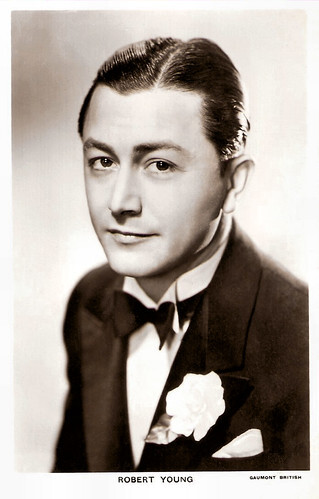
British postcard in the Picturegoer Series, London, no. 679c. Photo: Gaumont British.
The wise and kind American family man
Although Robert Young never ranked among the superstars of classic Hollywood cinema, his film partners included famous colleagues such as Katharine Hepburn , Margaret Sullavan , Norma Shearer , Joan Crawford , Helen Hayes, Luise Rainer and Hedy Lamarr . After his contract with Metro-Goldwyn-Mayer ended, he worked as a freelance actor for various studios such as 20th Century Fox, United Artists and RKO Radio Pictures. This also allowed him to get away from his middle-class screen image a bit and play characters with darker sides.
His best-known films of the 1940s include the Oscar Wilde-based ghost comedy The Canterville Ghost (Jules Dassin, Norman Z. McLeod, 1944) with Charles Laughton , the Film Noir Crossfire (Edward Dmytryk, 1947) and the star-studded literary adaptation That Forsyte Woman (Compton Bennett, 1949), for which he briefly returned to MGM. Other interesting roles were the facially disfigured war veteran in The Enchanted Cottage (John Cromwell, 1945) and the no-good philanderer in They Won't Believe Me (Irving Pichel, 1947) with Susan Hayward .
In the 1950s, the cinema offers dwindled noticeably, but Young was to have a second career on television that surpassed his cinema successes. From 1954 to 1960, he achieved great popularity as insurance salesman and family father Jim Anderson in the family series Father Knows Best (1954-1963), which became one of the most successful US series of the 1950s. Young had already been voicing this character since 1949 in a radio series also titled 'Father Knows Best'. With his portrayal of Jim Anderson, Young shaped the ideal image of the wise and kind American family man. Young became a millionaire thanks to his part-ownership of Father Knows Best, which, despite a shaky beginning, ran successfully until 1960 Young ended the series at the height of its popularity, partly because he was increasingly bored with the role.
In 1961 and 1962 he played the lead role in the short-lived sitcom Window on Main Street. Young disappeared from Hollywood during most of the 1960s, reappearing in 1969 in the pilot film Marcus Welby, M.D. It became a hit television series for the next seven years, presenting him with his third Emmy for his portrayal of the doctor. Young's later TV work included one-shot revivals of Father Knows Best and Marcus Welby, and the well-received TV movie Mercy or Murder? (Steve Gethers, 1987), in which Young essayed the role of a real-life pensioner who killed his wife rather than allow her to endure a painful, lingering illness. Young won three Emmy Awards, twice for his role in Father Knows Best and once for Marcus Welby, MD. He also received a Golden Globe Award for Marcus Welby. Three stars have been dedicated to him on the Hollywood Walk of Fame since 1960 in the categories of film, television and radio.
Robert Young was married to Elizabeth 'Betty' Louise Henderson from 1933 until her death in 1994. They had met while they were both students at Lincoln High. He was the father of four daughters and grandfather of six grandchildren. Although he portrayed well-developed social characters on the silver screen, Young himself suffered from depression and alcoholism. He also suffered from a chemical imbalance that led to a suicide attempt in 1991. In 1998, he passed away from respiratory failure at his Westlake Village, CA, home at the age of 91. He was interred at Forest Lawn Memorial Park in Glendale beside his wife Betty.
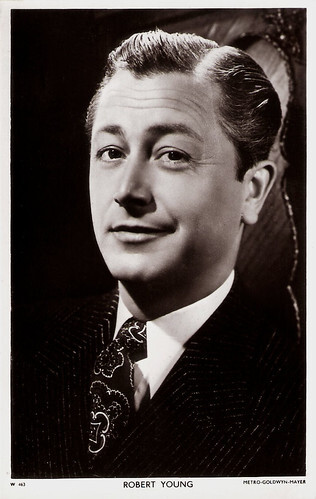
British postcard in the Picturegoer Series, London, no. W 463. Photo: Metro-Goldwyn-Mayer.
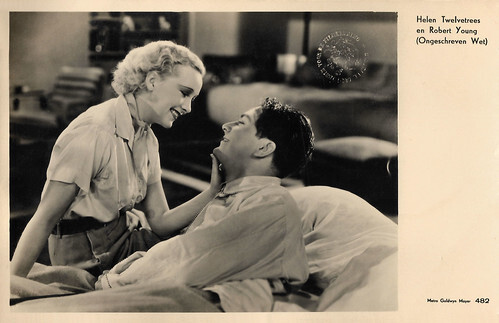
Dutch postcard, no. 462. Photo: Metro Goldwyn Mayer (MGM). Helen Twelvetrees and Robert Young in Unashamed (Harry Beaumont, 1932).
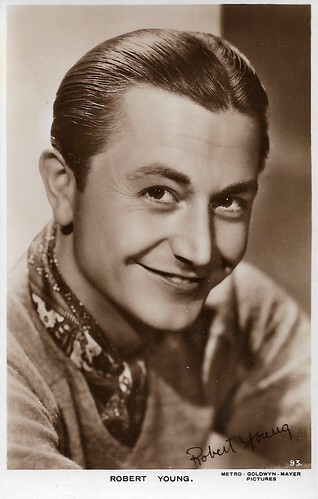
British postcard by Milton Postcard, no. 93. Photo: Metro-Goldwyn-Mayer.
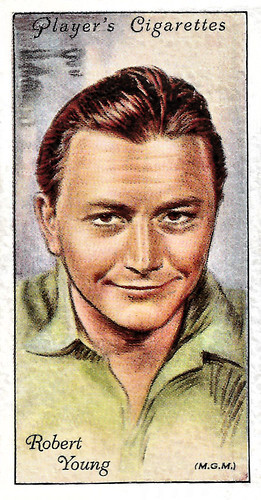
British collectors card in the Film Stars series by Player's Cigarettes (John Player & Sons, a branch of the Imperial Tobacco Co., Second Series, no. 50. Image: Metro-Goldwyn-Mayer (MGM).
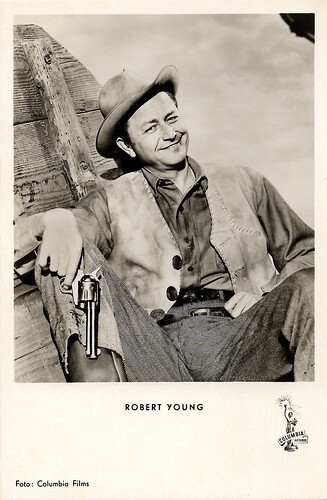
West German postcard by Kunst und Bild, Berlin, no. A 611. Photo: Columbia. Robert Young in Relentless (George Sherman, 1948).
Sources: Donald Greyfield (Find A Grave), AllMovie, Wikipedia (German and Dutch) and .

British `Real Photograph postcard, no. 93. Photo: Metro Goldwyn Mayer.

British Real Photograph postcard, no. 68. Photo: Metro-Goldwyn-Mayer.

British postcard in the Film Partners Series, London, no. PC 157. Photo: Metro Goldwyn Mayer. Robert Young and Betty Furness in The Band Plays On (Russell Mack, 1934).

French postcard by Editions P.I., Paris, no. 211. Photo: Metro Goldwyn Mayer.
Friendly, positive and charming characters
Robert Young was born in Chicago in 1907. His older brother Joe Young was later known as actor Roger Moore, a mainstay character actor who appeared in hundreds of uncredited roles in films. Their family relocated to Los Angeles when Robert was seven. He was introduced to acting while attending Lincoln High School.
After graduation, he pursued an acting career and from 1927 to 1931, he studied acting at the Pasadena Playhouse, where he gained his first acting experience. Sharpening his acting abilities while touring with a stock company in their production, 'The Ship', a talent scout saw him, resulting in a screen test.
After a few movie-extra roles, Young had his first credited film role in the Charlie Chan Mystery The Black Camel (Hamilton MacFadden, 1931). He was signed by MGM to play a bit part as Helen Hayes' son in Sin of Madelon Claudet (Edgar Selwyn, 1931). At the request of MGM head Irving Thalberg, Young's role was expanded during shooting, thus the young actor was launched on the road to stardom.
In the 1930s, he was able to establish himself in significant roles. He usually played friendly, positive and charming characters who sometimes seemed a bit boring though, which is why Young didn't always get the leading lady at the end of the film. However, he did get Constance Cummings in the comedy mystery Remember Last Night? (James Whale, 1935). He got the chance for a slightly different type of role when he was lent to England by MGM and played a likeable American who turns out to be a cold-blooded spy in the thriller Secret Agent (1936) directed by Alfred Hitchcock .
He then starred in another elaborate British production, It's Love Again (Victor Saville, 1936) with Jessie Matthews . In 1940, he had great success alongside James Stewart in The Mortal Storm (Frank Borzage, 1940) and alongside Spencer Tracy in Northwest Passage (King Vidor, Jack Conway, W.S. Van Dyke, 1940). A year later he had arguably one of his best film roles in the title role of King Vidor's drama H.M. Pulham, Esq. (King Vidor, 1941) in which he played a stiff middle-aged businessman who sums up wasted life opportunities.

German postcard by Ross Verlag, no. 6933/1, 1931-1932. Photo: Metro Goldwyn Mayer.

British postcard in the Filmshots series by Film Weekly. Photo: M.G.M. Marie Dressler , Robert Young and Maureen O'Sullivan in Tugboat Annie (Mervyn LeRoy, 1933).

British postcard in the Filmshots series by Film Weekly. Photo: M.G.M. Madge Evans , Robert Young and Robert Montgomery in Hell Below (Jack Conway, 1933).

British postcard in the Picturegoer Series, London, no. 679a. Photo: Metro Goldwyn Mayer.

British postcard in the Picturegoer Series, London, no. 679c. Photo: Gaumont British.
The wise and kind American family man
Although Robert Young never ranked among the superstars of classic Hollywood cinema, his film partners included famous colleagues such as Katharine Hepburn , Margaret Sullavan , Norma Shearer , Joan Crawford , Helen Hayes, Luise Rainer and Hedy Lamarr . After his contract with Metro-Goldwyn-Mayer ended, he worked as a freelance actor for various studios such as 20th Century Fox, United Artists and RKO Radio Pictures. This also allowed him to get away from his middle-class screen image a bit and play characters with darker sides.
His best-known films of the 1940s include the Oscar Wilde-based ghost comedy The Canterville Ghost (Jules Dassin, Norman Z. McLeod, 1944) with Charles Laughton , the Film Noir Crossfire (Edward Dmytryk, 1947) and the star-studded literary adaptation That Forsyte Woman (Compton Bennett, 1949), for which he briefly returned to MGM. Other interesting roles were the facially disfigured war veteran in The Enchanted Cottage (John Cromwell, 1945) and the no-good philanderer in They Won't Believe Me (Irving Pichel, 1947) with Susan Hayward .
In the 1950s, the cinema offers dwindled noticeably, but Young was to have a second career on television that surpassed his cinema successes. From 1954 to 1960, he achieved great popularity as insurance salesman and family father Jim Anderson in the family series Father Knows Best (1954-1963), which became one of the most successful US series of the 1950s. Young had already been voicing this character since 1949 in a radio series also titled 'Father Knows Best'. With his portrayal of Jim Anderson, Young shaped the ideal image of the wise and kind American family man. Young became a millionaire thanks to his part-ownership of Father Knows Best, which, despite a shaky beginning, ran successfully until 1960 Young ended the series at the height of its popularity, partly because he was increasingly bored with the role.
In 1961 and 1962 he played the lead role in the short-lived sitcom Window on Main Street. Young disappeared from Hollywood during most of the 1960s, reappearing in 1969 in the pilot film Marcus Welby, M.D. It became a hit television series for the next seven years, presenting him with his third Emmy for his portrayal of the doctor. Young's later TV work included one-shot revivals of Father Knows Best and Marcus Welby, and the well-received TV movie Mercy or Murder? (Steve Gethers, 1987), in which Young essayed the role of a real-life pensioner who killed his wife rather than allow her to endure a painful, lingering illness. Young won three Emmy Awards, twice for his role in Father Knows Best and once for Marcus Welby, MD. He also received a Golden Globe Award for Marcus Welby. Three stars have been dedicated to him on the Hollywood Walk of Fame since 1960 in the categories of film, television and radio.
Robert Young was married to Elizabeth 'Betty' Louise Henderson from 1933 until her death in 1994. They had met while they were both students at Lincoln High. He was the father of four daughters and grandfather of six grandchildren. Although he portrayed well-developed social characters on the silver screen, Young himself suffered from depression and alcoholism. He also suffered from a chemical imbalance that led to a suicide attempt in 1991. In 1998, he passed away from respiratory failure at his Westlake Village, CA, home at the age of 91. He was interred at Forest Lawn Memorial Park in Glendale beside his wife Betty.

British postcard in the Picturegoer Series, London, no. W 463. Photo: Metro-Goldwyn-Mayer.

Dutch postcard, no. 462. Photo: Metro Goldwyn Mayer (MGM). Helen Twelvetrees and Robert Young in Unashamed (Harry Beaumont, 1932).

British postcard by Milton Postcard, no. 93. Photo: Metro-Goldwyn-Mayer.

British collectors card in the Film Stars series by Player's Cigarettes (John Player & Sons, a branch of the Imperial Tobacco Co., Second Series, no. 50. Image: Metro-Goldwyn-Mayer (MGM).

West German postcard by Kunst und Bild, Berlin, no. A 611. Photo: Columbia. Robert Young in Relentless (George Sherman, 1948).
Sources: Donald Greyfield (Find A Grave), AllMovie, Wikipedia (German and Dutch) and .
Published on July 15, 2023 22:00
July 14, 2023
Phoebus-Film
Phoebus-Film or Phoebus Film was a German film production and distribution company based in Berlin and active during the silent era. It was one of the medium-sized firms established during the early boom years of the Weimar Republic. It had a distribution agreement with the American studio MGM.
In 1927 the studio became involved in major controversy during the Lohmann Affair when it emerged that the company had secretly been granted a large sum from the German Navy Department geared toward military propaganda and support of rearmament at a time when this was forbidden by the Treaty of Versailles. The ensuing scandal led to a political crisis in the Weimar Republic and the resignation of Otto Gessler as Defence Minister.
The company went bankrupt in the wake of the scandal. In 1928 the Munich-based Bavaria Film bought up the remaining assets of the company. Its former production chief Ernst Hugo Correll was appointed as the new head of Germany's largest company UFA.
Six films
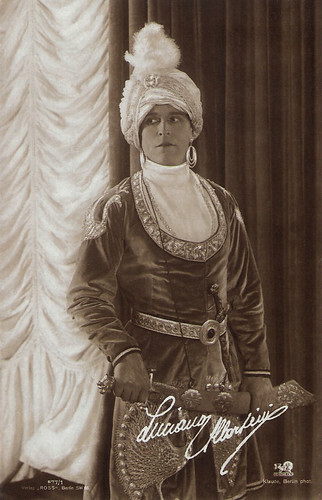
German postcard by Ross Verlag, no. 577/1. Photo: Leo Klaude, Berlin / Phoebus-Film. Luciano Albertini in Der Sieg des Maharadscha/The victory of the Maharajah (Joseph Delmont, 1923).
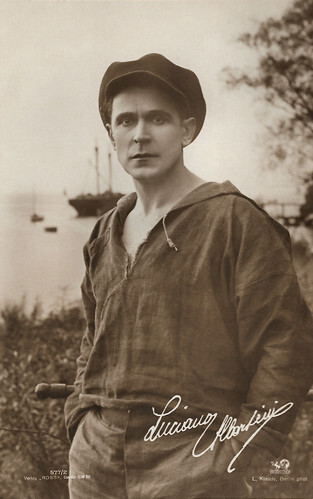
German postcard by Ross Verlag, no. 577/2. Photo: Leo Klaude, Berlin / Phoebus Film. Luciano Albertini in Die Schlucht des Todes/The Ravine of Death (Luciano Albertini, Francis A. Bertoni, 1923).
Luciano Albertini (1882-1945) was a beloved strongman of the Italian and German silent cinema. From his arrival in Germany in 1921 until 1924, all of Albertini's films were distributed by Phoebus and produced by his own Albertini-Film. In Die Schlucht des Todes (Luciano Albertini, Francis Bertoni, 1923), Albertini plays an Argentine farmer whose reckless deeds at the Devil's Canyon convince an Italian circus director to engage him and his wife ( Lya De Putti ). The wife becomes enamoured with a womanising count and elopes with him.
Years after, Luciano has become a dockworker in Naples and saves a child, unknowing it is the child of Lya and the count. The count is fed up with Lya. She runs into Luciano and begs him to go back with her to Argentine. Back there he finds out she has a child and recognises it as the girl he once saved. Galloping towards the Devil's Canyon, his horse is cleverer than he and holds back. Lya gallops behind him but she falls down a cliff, so Luciano rescues her and they reunite.
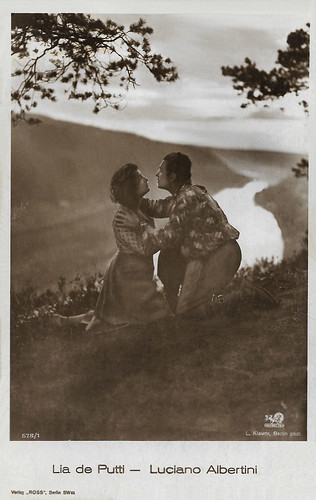
German postcard by Ross Verlag, Berlin, no. 578/1, 1919-1924. Photo: Leo Klaude, Berlin / Phoebus Film. Lya de Putti and Luciano Albertini in Die Schlucht des Todes/The Ravine of Death (Luciano Albertini, Albert-Francis Bertoni, Max Obal, 1923). The final scene: Luciano has just saved Lya from falling down the Devil's Canyon and reconciles with her after his refusal to acknowledge her illegal child and his failed suicide attempt.
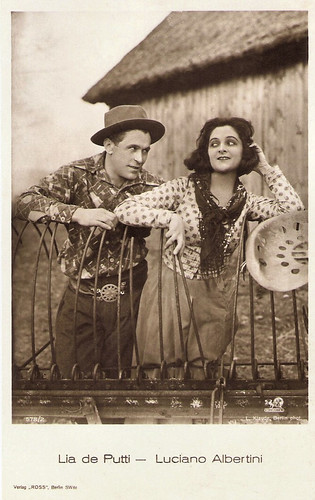
German postcard by Ross Verlag, Berlin, no. 578/2, 1919-1924. Photo: Leo Klaude, Berlin / Phoebus Film. Luciano Albertini and Lya de Putti in Die Schlucht des Todes/The Ravine of Death (Luciano Albertini, Albert-Francis Bertoni, Max Obal, 1923).
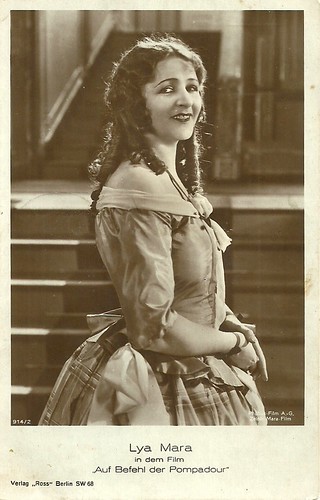
German postcard by Ross Verlag, no. 914/2, 1925-1926. Photo: Phoebus Film / Zelnik-Mara Film. Lya Mara in Auf Befehl der Pompadour/By Order of Pompadour (Friedrich Zelnik, 1924).
Lya Mara was the star and her partner Friedrich a.k.a. Frederic Zelnik the director of Auf Befehl der Pompadour/By Order of Pompadour (1924), situated in the France of the present time and then at the time of Louis XV, in the 18th century. The film was produced by their own company, Zelnik-Mara Film and distributed by Phoebus-Film. Ross Verlag published a wonderful series of postcards for the film, focusing on Mara as Madame de Pompadour.
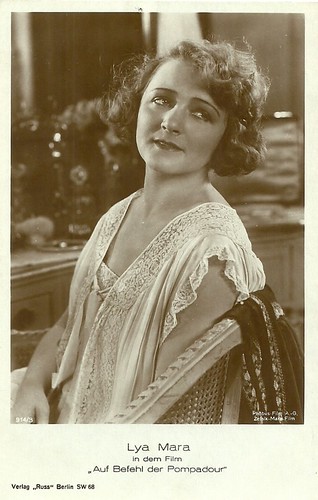
German postcard by Ross Verlag, no. 914/3, 1925-1926. Photo: Phoebus Film / Zelnik-Mara Film. Lya Mara in Auf Befehl der Pompadour/By Order of Pompadour (Friedrich Zelnik, 1924).
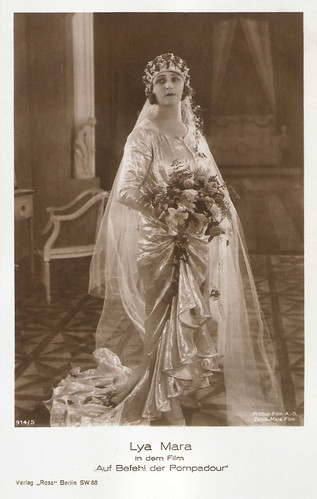
German postcard by Ross Verlag, no. 914/5, 1925-1926. Photo: Phoebus Film / Zelnik-Mara Film. Lya Mara in Auf Befehl der Pompadour/By Order of Pompadour (Friedrich Zelnik, 1924).
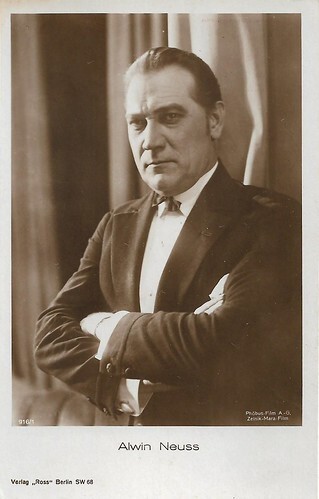
German postcard by Ross Verlag, no. 916/4, 1925-1926. Photo: Phoebus-Film AG / Zelnik-Mara Film. Alwin Neuss .
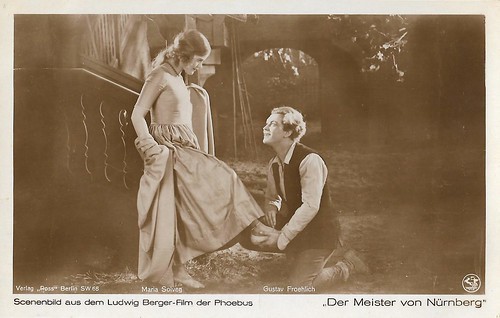
German postcard by Ross Verlag. Photo: Phoebus Film. Maria Solveg and Gustav Fröhlich in Der Meister von Nürnberg (Ludwig Berger, 1927).
The historical comedy Der Meister von Nürnberg/The Master of Nuremberg (Ludwig Berger, 1927) was based on Richard Wagner's opera 'Die Meistersinger von Nürnberg'. Rudolf Rittner played the title figure and Maria Solveg and Gustav Fröhlich starred as the young lovers. Phoebus-Film was both producer and distributor of the film. Ross Verlag made a beautiful series of sepia postcards.
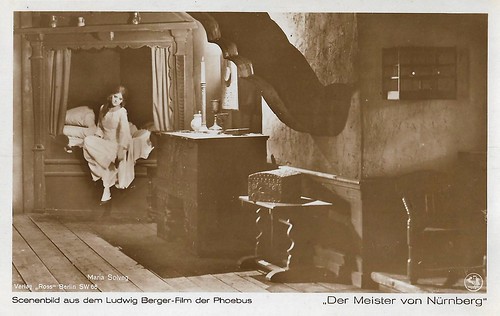
German postcard by Ross Verlag. Photo: Phoebus Film. Maria Solveg in Der Meister von Nürnberg (Ludwig Berger, 1927).
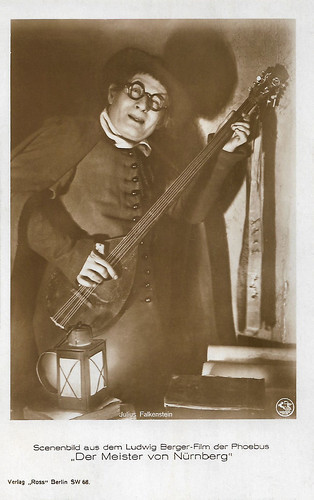
German postcard by Ross Verlag. Photo: Phoebus Film. Julius Falkenstein in Der Meister von Nürnberg (Ludwig Berger, 1927).
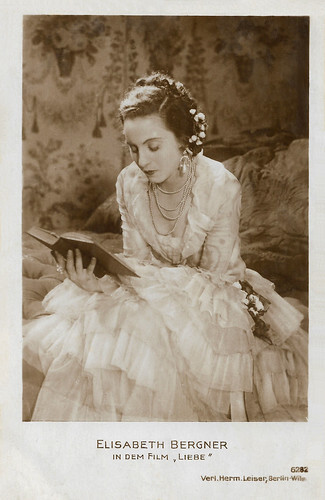
German postcard by Verlag Hermann Leiser, Berlin, no. 6282. Photo: Phoebus-Film. Elisabeth Bergner in Liebe/ Love (Paul Czinner, 1926).
The historical drama Liebe/Love (Paul Czinner, 1927) is based on the novel 'La Duchesse de Langeais' (1834) by Honoré de Balzac. While the novel was published in 1834, Bergner's costume and hairdo rather remind us of the 1860s.
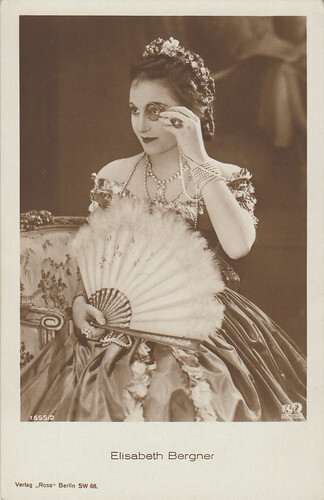
German postcard by Ross Verlag, no. 1655/2, 1927-1928. Photo: Phoebus-Film. Elisabeth Bergner in Liebe/Love (Paul Czinner, 1927). Collection: Marlene Pilaete.
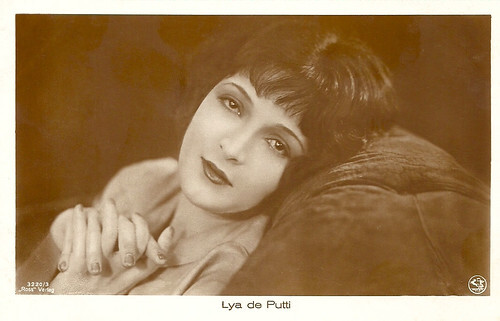
German postcard by Ross Verlag, Berlin, no. 3220/3, 1928-1929. Photo: Phoebus-Film. Lya de Putti in Charlott ertwas verrückt/Charlott a little crazy (Adolf E. Licho, 1929). Collection: Didier Hanson.
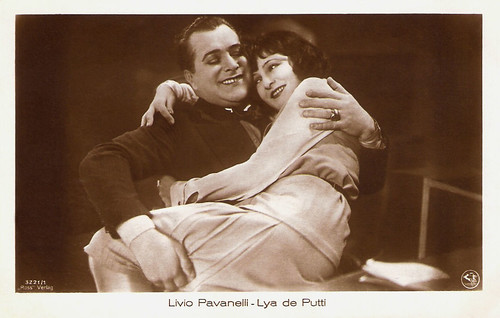
German postcard by Ross Verlag, no. 3221/1, 1928-1929. Photo: Phoebus-Film. Livio Pavanelli and Lya de Putti in Charlott etwas verrückt/Charlott a little crazy (Adolf E. Licho, 1929).
MGM Stars
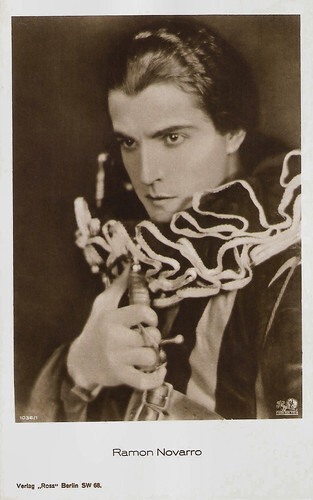
German postcard by Ross Verlag, Berlin, no. 1036/1, 1927-1928. Photo: Phoebus Film. Ramon Novarro in Scaramouche (Rex Ingram, 1923).
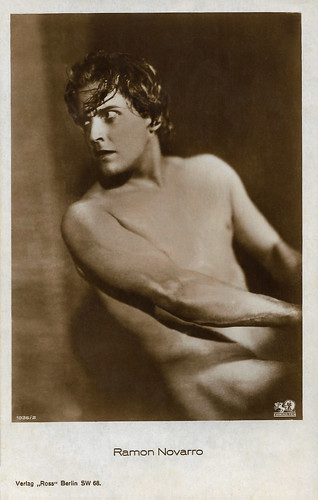
German postcard by Ross Verlag, Berlin, no. 1036/2, 1927-1928. Photo: Bragaglia / Phoebus Film. Ramon Novarro in Ben-Hur: A Tale of the Christ (Fred Niblo, 1925).
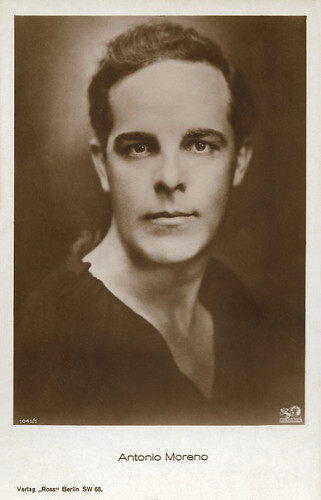
German postcard by Ross Verlag, Berlin, no. 1041/1, 1927-1928. Photo: Phoebus Film. Antonio Moreno .
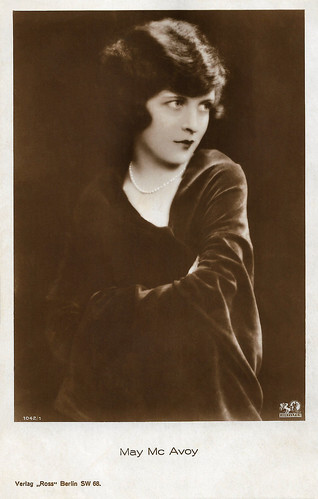
German postcard by Ross Verlag, Berlin, no. 1042/1, 1927-1928. Photo: Phoebus Film. May McAvoy .
Vom Werden Deutscher Filmkunst - Der Stumme Film
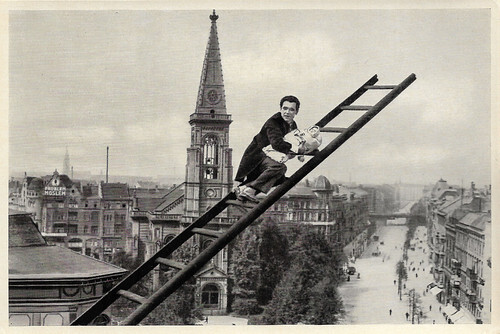
German collectors card by Ross Verlag in the series Vom Werden Deutscher Filmkunst - Der Stumme Film, no. 129. Photo: Phoebus-Film. Publicity still with Luciano Albertini in Der Mann auf dem Kometen/The Man on the Comet (Alfred Halm, 1925).
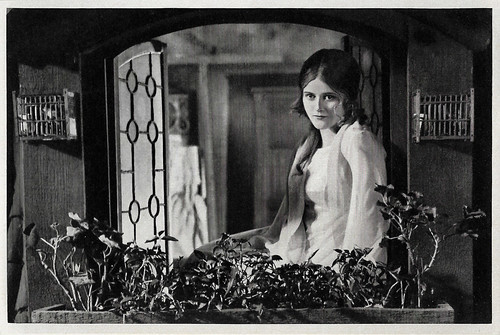
German collectors card by Ross Verlag in the series Vom Werden deutscher Filmkunst - Der Stumme Film, picture no. 114, group 39. Photo: Ufa. Maria Solveg in Der Meister von Nürnberg/The Master of Nuremberg (Ludwig Berger, 1927).
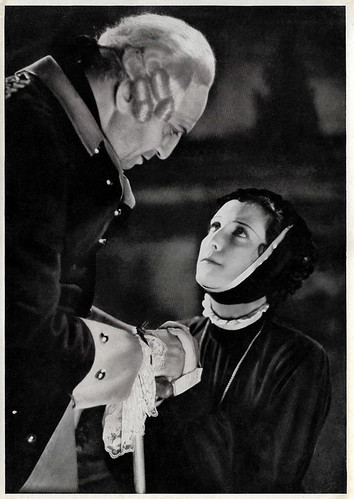
German collectors card in the series 'Vom Werden deutscher Filmkunst - Der Tonfilm', album no. 11, picture no. 112. Photo: Phoebus-Film / Ross Verlag. Theodor Loos and Dorothea Wieck in Trenck - Der Roman einer großen Liebe/Trenck (Ernst Neubach, Heinz Paul, 1932).
Sources: Wikipedia and IMDb.
In 1927 the studio became involved in major controversy during the Lohmann Affair when it emerged that the company had secretly been granted a large sum from the German Navy Department geared toward military propaganda and support of rearmament at a time when this was forbidden by the Treaty of Versailles. The ensuing scandal led to a political crisis in the Weimar Republic and the resignation of Otto Gessler as Defence Minister.
The company went bankrupt in the wake of the scandal. In 1928 the Munich-based Bavaria Film bought up the remaining assets of the company. Its former production chief Ernst Hugo Correll was appointed as the new head of Germany's largest company UFA.
Six films

German postcard by Ross Verlag, no. 577/1. Photo: Leo Klaude, Berlin / Phoebus-Film. Luciano Albertini in Der Sieg des Maharadscha/The victory of the Maharajah (Joseph Delmont, 1923).

German postcard by Ross Verlag, no. 577/2. Photo: Leo Klaude, Berlin / Phoebus Film. Luciano Albertini in Die Schlucht des Todes/The Ravine of Death (Luciano Albertini, Francis A. Bertoni, 1923).
Luciano Albertini (1882-1945) was a beloved strongman of the Italian and German silent cinema. From his arrival in Germany in 1921 until 1924, all of Albertini's films were distributed by Phoebus and produced by his own Albertini-Film. In Die Schlucht des Todes (Luciano Albertini, Francis Bertoni, 1923), Albertini plays an Argentine farmer whose reckless deeds at the Devil's Canyon convince an Italian circus director to engage him and his wife ( Lya De Putti ). The wife becomes enamoured with a womanising count and elopes with him.
Years after, Luciano has become a dockworker in Naples and saves a child, unknowing it is the child of Lya and the count. The count is fed up with Lya. She runs into Luciano and begs him to go back with her to Argentine. Back there he finds out she has a child and recognises it as the girl he once saved. Galloping towards the Devil's Canyon, his horse is cleverer than he and holds back. Lya gallops behind him but she falls down a cliff, so Luciano rescues her and they reunite.

German postcard by Ross Verlag, Berlin, no. 578/1, 1919-1924. Photo: Leo Klaude, Berlin / Phoebus Film. Lya de Putti and Luciano Albertini in Die Schlucht des Todes/The Ravine of Death (Luciano Albertini, Albert-Francis Bertoni, Max Obal, 1923). The final scene: Luciano has just saved Lya from falling down the Devil's Canyon and reconciles with her after his refusal to acknowledge her illegal child and his failed suicide attempt.

German postcard by Ross Verlag, Berlin, no. 578/2, 1919-1924. Photo: Leo Klaude, Berlin / Phoebus Film. Luciano Albertini and Lya de Putti in Die Schlucht des Todes/The Ravine of Death (Luciano Albertini, Albert-Francis Bertoni, Max Obal, 1923).

German postcard by Ross Verlag, no. 914/2, 1925-1926. Photo: Phoebus Film / Zelnik-Mara Film. Lya Mara in Auf Befehl der Pompadour/By Order of Pompadour (Friedrich Zelnik, 1924).
Lya Mara was the star and her partner Friedrich a.k.a. Frederic Zelnik the director of Auf Befehl der Pompadour/By Order of Pompadour (1924), situated in the France of the present time and then at the time of Louis XV, in the 18th century. The film was produced by their own company, Zelnik-Mara Film and distributed by Phoebus-Film. Ross Verlag published a wonderful series of postcards for the film, focusing on Mara as Madame de Pompadour.

German postcard by Ross Verlag, no. 914/3, 1925-1926. Photo: Phoebus Film / Zelnik-Mara Film. Lya Mara in Auf Befehl der Pompadour/By Order of Pompadour (Friedrich Zelnik, 1924).

German postcard by Ross Verlag, no. 914/5, 1925-1926. Photo: Phoebus Film / Zelnik-Mara Film. Lya Mara in Auf Befehl der Pompadour/By Order of Pompadour (Friedrich Zelnik, 1924).

German postcard by Ross Verlag, no. 916/4, 1925-1926. Photo: Phoebus-Film AG / Zelnik-Mara Film. Alwin Neuss .

German postcard by Ross Verlag. Photo: Phoebus Film. Maria Solveg and Gustav Fröhlich in Der Meister von Nürnberg (Ludwig Berger, 1927).
The historical comedy Der Meister von Nürnberg/The Master of Nuremberg (Ludwig Berger, 1927) was based on Richard Wagner's opera 'Die Meistersinger von Nürnberg'. Rudolf Rittner played the title figure and Maria Solveg and Gustav Fröhlich starred as the young lovers. Phoebus-Film was both producer and distributor of the film. Ross Verlag made a beautiful series of sepia postcards.

German postcard by Ross Verlag. Photo: Phoebus Film. Maria Solveg in Der Meister von Nürnberg (Ludwig Berger, 1927).

German postcard by Ross Verlag. Photo: Phoebus Film. Julius Falkenstein in Der Meister von Nürnberg (Ludwig Berger, 1927).

German postcard by Verlag Hermann Leiser, Berlin, no. 6282. Photo: Phoebus-Film. Elisabeth Bergner in Liebe/ Love (Paul Czinner, 1926).
The historical drama Liebe/Love (Paul Czinner, 1927) is based on the novel 'La Duchesse de Langeais' (1834) by Honoré de Balzac. While the novel was published in 1834, Bergner's costume and hairdo rather remind us of the 1860s.

German postcard by Ross Verlag, no. 1655/2, 1927-1928. Photo: Phoebus-Film. Elisabeth Bergner in Liebe/Love (Paul Czinner, 1927). Collection: Marlene Pilaete.

German postcard by Ross Verlag, Berlin, no. 3220/3, 1928-1929. Photo: Phoebus-Film. Lya de Putti in Charlott ertwas verrückt/Charlott a little crazy (Adolf E. Licho, 1929). Collection: Didier Hanson.

German postcard by Ross Verlag, no. 3221/1, 1928-1929. Photo: Phoebus-Film. Livio Pavanelli and Lya de Putti in Charlott etwas verrückt/Charlott a little crazy (Adolf E. Licho, 1929).
MGM Stars

German postcard by Ross Verlag, Berlin, no. 1036/1, 1927-1928. Photo: Phoebus Film. Ramon Novarro in Scaramouche (Rex Ingram, 1923).

German postcard by Ross Verlag, Berlin, no. 1036/2, 1927-1928. Photo: Bragaglia / Phoebus Film. Ramon Novarro in Ben-Hur: A Tale of the Christ (Fred Niblo, 1925).

German postcard by Ross Verlag, Berlin, no. 1041/1, 1927-1928. Photo: Phoebus Film. Antonio Moreno .

German postcard by Ross Verlag, Berlin, no. 1042/1, 1927-1928. Photo: Phoebus Film. May McAvoy .
Vom Werden Deutscher Filmkunst - Der Stumme Film

German collectors card by Ross Verlag in the series Vom Werden Deutscher Filmkunst - Der Stumme Film, no. 129. Photo: Phoebus-Film. Publicity still with Luciano Albertini in Der Mann auf dem Kometen/The Man on the Comet (Alfred Halm, 1925).

German collectors card by Ross Verlag in the series Vom Werden deutscher Filmkunst - Der Stumme Film, picture no. 114, group 39. Photo: Ufa. Maria Solveg in Der Meister von Nürnberg/The Master of Nuremberg (Ludwig Berger, 1927).

German collectors card in the series 'Vom Werden deutscher Filmkunst - Der Tonfilm', album no. 11, picture no. 112. Photo: Phoebus-Film / Ross Verlag. Theodor Loos and Dorothea Wieck in Trenck - Der Roman einer großen Liebe/Trenck (Ernst Neubach, Heinz Paul, 1932).
Sources: Wikipedia and IMDb.
Published on July 14, 2023 22:00
July 13, 2023
Lizabeth Scott
American film star Lizabeth Scott (1922-2015) starred as the bad girl - or the good girl gone bad - in hard-boiled Film Noirs like The Strange Love of Martha Ivers (1946) with Barbara Stanwyck, Dead Reckoning (1947) with Humphrey Bogart, and I Walk Alone (1948) opposite Burt Lancaster. With her blonde hair, smouldering eyes and her deep smoky voice, she was a sultry femme fatale in a world of crime, tough talk and dark secrets. Of her 22 feature films, she was the leading lady in all but one. In addition to stage and radio, she appeared on television from the late 1940s to the early 1970s.
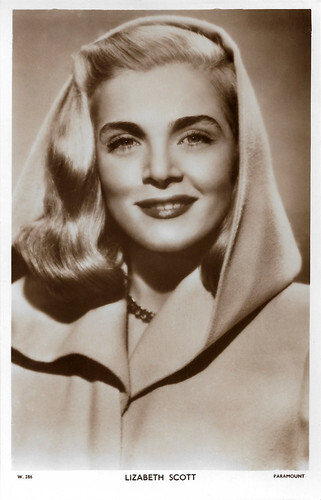
British postcard in the Picturegoer Series, London, no. W. 286. Photo: Paramount.
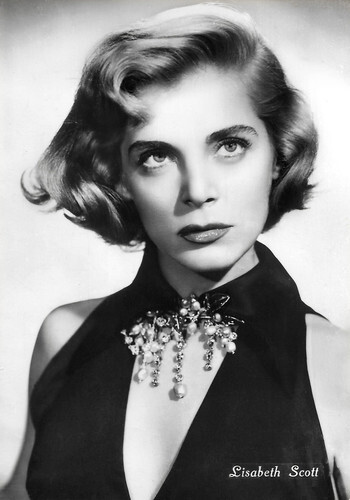
Italian postcard in the Divi del Cinema Series by Vetta Traldi, Milano, no. 12. Sent by mail in 1955.
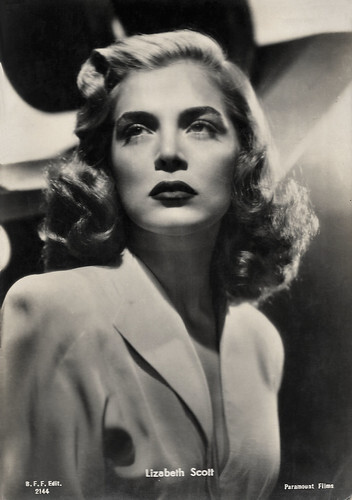
Italian postcard by B.F.F. Edit. (Casa Edits. Ballerini & Fratini, Firenze), no. 2144. Photo: Paramount Films.
Beautiful, blonde, aloof and alluring
Lizabeth Scott was born Emma Matzo in 1922, in Scranton, Pennsylvania, where her parents, John Matzo and Mary (nee Pennock), had a grocery store. Despite her parents’ opposition to an acting career, she went to the Alviene Master School of the Theatre and Academy of Cultural Arts in New York in her late teens. Here she adopted the stage name of Elizabeth Scott.
She landed a small role in a touring company of the hit stage comedy 'Hellzapoppin'. Back in New York, unable to get an acting job, she landed work as a fashion model with Harper’s Bazaar at $25 an hour. In 1942, she got a small part in the original Broadway production of Thornton Wilder's 'The Skin of Our Teeth'. Scott also understudied Tallulah Bankhead , who played the lead role. The tempestuous Bankhead, who did not get along with Scott, stubbornly never missed a performance. In Boston, Scott finally got to play the lead role, taking over from Miriam Hopkins .
She decided to remove the 'E' from Elizabeth Scott to be more distinctive. It would be either this performance or a four-picture spread in an issue of Harper’s Bazaar (the sources differ about this) that led to a long-term Hollywood contract with Hal Wallis, who had his own producing organisation through Paramount Studios. Scott": It was off-season on Broadway and since I wasn’t able to find a job there, I thought it might be a good experience to come to Hollywood and find out what it was all about.”
Wallis introduced his 22-year-old discovery as “beautiful, blonde, aloof and alluring”. Scott's film debut was the comedy-drama You Came Along (John Farrow, 1945) opposite Robert Cummings. In her second film, The Strange Love of Martha Ivers (Lewis Milestone, 1946), she played a young woman wrongly jailed, opposite Barbara Stanwyck , Kirk Douglas and Van Heflin . She made more of an impression in Dead Reckoning (John Cromwell, 1947) as a gangster’s wife, almost luring Humphrey Bogart into her corruptive trap. Her mysterious character was shot in oblique angles and low-key lighting. Stylishly dressed by Edith Head, she played the good girl gone bad becoming good again in the melodrama Desert Fury (Lewis Allen, 1947).
Billed as “the blonde with the brown voice”, Scott played a nightclub singer in I Walk Alone (Byron Haskin, 1948), also starring Kirk Douglas and Burt Lancaster . She was more decadent than ever in Too Late for Tears (Byron Haskin, 1949), having killed two husbands because she wanted “to move out of the ranks of the middle-class poor”. Scott was her own woman in the world of hard-boiled film crime. Ronald Bergan at The Observer : "Scott was strong and sultry, her heavy dark eyebrows contrasting with her blonde hair. Like [Lauren] Bacall , she had a low and husky voice, but she was far harder; in fact, she was able to suggest hidden depths of depravity – the ideal femme fatale of the 1940s."
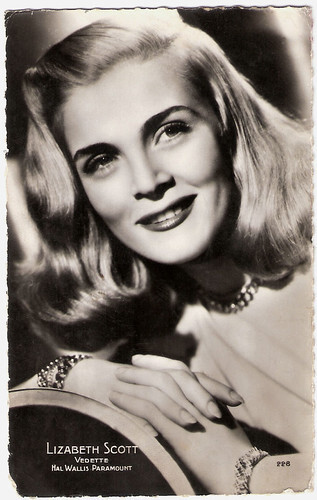
French postcard by Editions P.I., Paris, no. 228, offered by NV Victoria, Brussels, no. 639. Photo: Hal Wallis / Paramount, 1950.
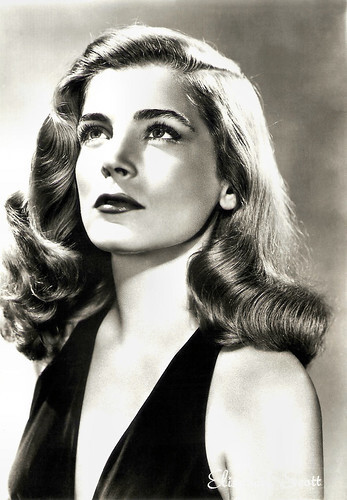
Italian postcard by Rotalfoto, Milano, no. 64. Photo: Columbia CEIAD.
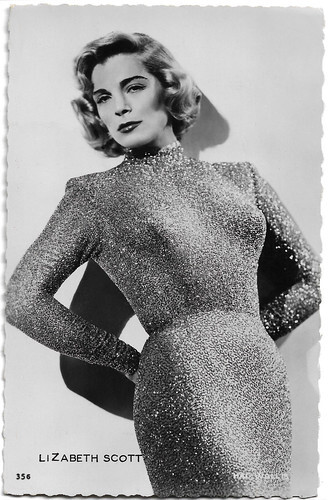
French postcard by Editions P.I., Paris, offered by Les Carbones Korès, no. 356. Photo: Hal Wallis / Paramount Pictures, 1950.
Confidential
In her films, Lizabeth Scott made some memorable quotes. In Pitfall (André De Toth, 1948), she described herself to Dick Powell as "a girl whose first engagement ring was bought by a man stupid enough to embezzle and stupid enough to get caught." In The Racket (John Cromwell, 1951), she asked Robert Mitchum : "Who said I was an honest citizen, and where would it get me if I was?"
In another Film Noir, Dark City (William Dieterle, 1950), she is a nightclub singer again who drifts on the edges of a shadowy criminal world, though her love for a gambler ( Charlton Heston in his Hollywood debut) is uplifting. Heston and Scott were reunited for Bad for Each Other (Irving Rapper, 1953). She played several similar roles of a woman willing to change her louche ways but doomed to find a worthwhile man to love her only when she had already passed the point of redemption.
After several years of making one Film Noir after another — sometimes at a pace of two or three in a year — Scott was ready for a change. She got it in the comedy Scared Stiff (George Marshall, 1953), starring Dean Martin and Jerry Lewis . In September 1954, a front-page story in the magazine Confidential claimed that Scott was a lesbian and was linked to “the little black books kept by Hollywood prostitutes”. It was also said that on a trip to Paris, she had taken up with Frédérique 'Frédé' Baulé, manager of Carroll's, an upper-class, cabaret-type nightclub in Paris. One of the owners was Marlene Dietrich .
Two months before the issue's printed publication, her lawyer had instituted a $2.5m suit against Confidential, accusing the magazine of “holding the plaintiff up to contempt and ridicule and implying in the eyes of every reader indecent, unnatural and illegal conduct in her private and public life”. Scott lost her suit on a technicality, however, and, given the witch-hunting atmosphere of the times, the case certainly harmed her. Compounding her plight was her rebellious nature, having never paid conventional homage to the film establishment and to gossip columnists Louella Parsons and Hedda Hopper.
In 1955, Scott went to Great Britain to film The Weapon (Val Guest, 1957). As with other European films of the 1950s- 1970s period aimed at a US audience, Scott starred with another American actor, Steve Cochran , who played US Army CID officer Mark Andrews. Scott also played a publicity woman in the Elvis Presley vehicle Loving You (Hal Kanter, 1957). In 1957, she also released an album of torch songs and romantic ballads titled 'Lizabeth'. She had a few TV roles in the 1960s. Her last credited movie appearance was as a man-eating cougar in Pulp (Mike Hodges, 1972), a sendup of the Film Noir starring Michael Caine . One of her ex-husbands in the film is played by Mickey Rooney .
Scott lived quietly in Hollywood, sometimes accepting invitations to attend film festivals and other events. In a 1996 interview with documentary filmmaker Carole Langer, Scott said she had liked the grittiness of Film Noir and didn't lament the fact that she wasn't cast in studio blockbusters: "The films that I had seen growing up were always, boy meets girl, the boy ends up marrying girl, they go off into the sunset," Scott said. After the war, films got more in touch with "the psychological, emotional things that people feel and people do. It was a new realm, and it was very exciting because suddenly you were coming closer and closer to reality." Lizabeth Scott died in 2015 at Cedars-Sinai Medical Center in Los Angeles. She was 92. The cause was congestive heart failure, said her long-time friend Mary Goodstein. Scott's survivors include her brother Gus Matzo and sister Justine Birdsall.
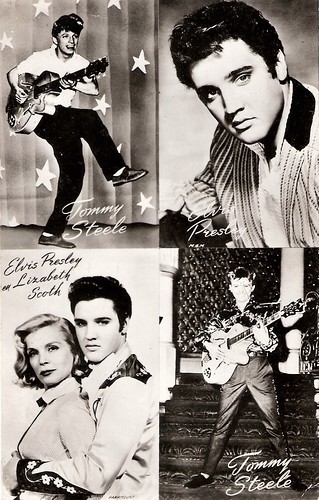
Dutch postcard by Uitgeverij Takken, Utrecht, no. 3823, 1958. The photo of Elvis Presley and Lizabeth Scott was a publicity still for Loving You (Hal Kanter, 1957).
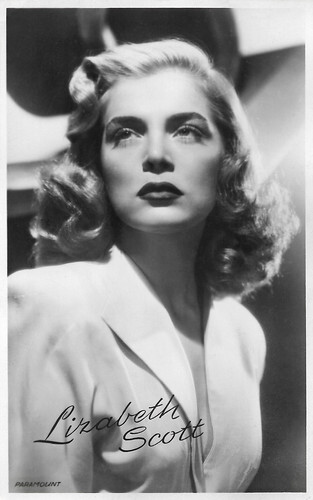
Vintage postcard, no. 3396. Photo: Paramount.
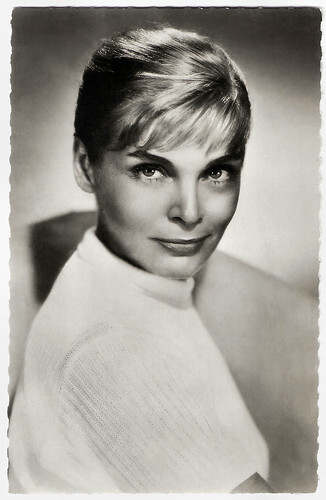
French postcard by Editions P.I., Paris, no. 876, offered by Les Carbones Korès 'Carboplane'. Photo: Paramount Pictures.
Sources David Colker (Los Angeles Times), Ronald Bergan (The Observer), Mike Barnes (Hollywood Reporter), Variety, Wikipedia and .

British postcard in the Picturegoer Series, London, no. W. 286. Photo: Paramount.

Italian postcard in the Divi del Cinema Series by Vetta Traldi, Milano, no. 12. Sent by mail in 1955.

Italian postcard by B.F.F. Edit. (Casa Edits. Ballerini & Fratini, Firenze), no. 2144. Photo: Paramount Films.
Beautiful, blonde, aloof and alluring
Lizabeth Scott was born Emma Matzo in 1922, in Scranton, Pennsylvania, where her parents, John Matzo and Mary (nee Pennock), had a grocery store. Despite her parents’ opposition to an acting career, she went to the Alviene Master School of the Theatre and Academy of Cultural Arts in New York in her late teens. Here she adopted the stage name of Elizabeth Scott.
She landed a small role in a touring company of the hit stage comedy 'Hellzapoppin'. Back in New York, unable to get an acting job, she landed work as a fashion model with Harper’s Bazaar at $25 an hour. In 1942, she got a small part in the original Broadway production of Thornton Wilder's 'The Skin of Our Teeth'. Scott also understudied Tallulah Bankhead , who played the lead role. The tempestuous Bankhead, who did not get along with Scott, stubbornly never missed a performance. In Boston, Scott finally got to play the lead role, taking over from Miriam Hopkins .
She decided to remove the 'E' from Elizabeth Scott to be more distinctive. It would be either this performance or a four-picture spread in an issue of Harper’s Bazaar (the sources differ about this) that led to a long-term Hollywood contract with Hal Wallis, who had his own producing organisation through Paramount Studios. Scott": It was off-season on Broadway and since I wasn’t able to find a job there, I thought it might be a good experience to come to Hollywood and find out what it was all about.”
Wallis introduced his 22-year-old discovery as “beautiful, blonde, aloof and alluring”. Scott's film debut was the comedy-drama You Came Along (John Farrow, 1945) opposite Robert Cummings. In her second film, The Strange Love of Martha Ivers (Lewis Milestone, 1946), she played a young woman wrongly jailed, opposite Barbara Stanwyck , Kirk Douglas and Van Heflin . She made more of an impression in Dead Reckoning (John Cromwell, 1947) as a gangster’s wife, almost luring Humphrey Bogart into her corruptive trap. Her mysterious character was shot in oblique angles and low-key lighting. Stylishly dressed by Edith Head, she played the good girl gone bad becoming good again in the melodrama Desert Fury (Lewis Allen, 1947).
Billed as “the blonde with the brown voice”, Scott played a nightclub singer in I Walk Alone (Byron Haskin, 1948), also starring Kirk Douglas and Burt Lancaster . She was more decadent than ever in Too Late for Tears (Byron Haskin, 1949), having killed two husbands because she wanted “to move out of the ranks of the middle-class poor”. Scott was her own woman in the world of hard-boiled film crime. Ronald Bergan at The Observer : "Scott was strong and sultry, her heavy dark eyebrows contrasting with her blonde hair. Like [Lauren] Bacall , she had a low and husky voice, but she was far harder; in fact, she was able to suggest hidden depths of depravity – the ideal femme fatale of the 1940s."

French postcard by Editions P.I., Paris, no. 228, offered by NV Victoria, Brussels, no. 639. Photo: Hal Wallis / Paramount, 1950.

Italian postcard by Rotalfoto, Milano, no. 64. Photo: Columbia CEIAD.

French postcard by Editions P.I., Paris, offered by Les Carbones Korès, no. 356. Photo: Hal Wallis / Paramount Pictures, 1950.
Confidential
In her films, Lizabeth Scott made some memorable quotes. In Pitfall (André De Toth, 1948), she described herself to Dick Powell as "a girl whose first engagement ring was bought by a man stupid enough to embezzle and stupid enough to get caught." In The Racket (John Cromwell, 1951), she asked Robert Mitchum : "Who said I was an honest citizen, and where would it get me if I was?"
In another Film Noir, Dark City (William Dieterle, 1950), she is a nightclub singer again who drifts on the edges of a shadowy criminal world, though her love for a gambler ( Charlton Heston in his Hollywood debut) is uplifting. Heston and Scott were reunited for Bad for Each Other (Irving Rapper, 1953). She played several similar roles of a woman willing to change her louche ways but doomed to find a worthwhile man to love her only when she had already passed the point of redemption.
After several years of making one Film Noir after another — sometimes at a pace of two or three in a year — Scott was ready for a change. She got it in the comedy Scared Stiff (George Marshall, 1953), starring Dean Martin and Jerry Lewis . In September 1954, a front-page story in the magazine Confidential claimed that Scott was a lesbian and was linked to “the little black books kept by Hollywood prostitutes”. It was also said that on a trip to Paris, she had taken up with Frédérique 'Frédé' Baulé, manager of Carroll's, an upper-class, cabaret-type nightclub in Paris. One of the owners was Marlene Dietrich .
Two months before the issue's printed publication, her lawyer had instituted a $2.5m suit against Confidential, accusing the magazine of “holding the plaintiff up to contempt and ridicule and implying in the eyes of every reader indecent, unnatural and illegal conduct in her private and public life”. Scott lost her suit on a technicality, however, and, given the witch-hunting atmosphere of the times, the case certainly harmed her. Compounding her plight was her rebellious nature, having never paid conventional homage to the film establishment and to gossip columnists Louella Parsons and Hedda Hopper.
In 1955, Scott went to Great Britain to film The Weapon (Val Guest, 1957). As with other European films of the 1950s- 1970s period aimed at a US audience, Scott starred with another American actor, Steve Cochran , who played US Army CID officer Mark Andrews. Scott also played a publicity woman in the Elvis Presley vehicle Loving You (Hal Kanter, 1957). In 1957, she also released an album of torch songs and romantic ballads titled 'Lizabeth'. She had a few TV roles in the 1960s. Her last credited movie appearance was as a man-eating cougar in Pulp (Mike Hodges, 1972), a sendup of the Film Noir starring Michael Caine . One of her ex-husbands in the film is played by Mickey Rooney .
Scott lived quietly in Hollywood, sometimes accepting invitations to attend film festivals and other events. In a 1996 interview with documentary filmmaker Carole Langer, Scott said she had liked the grittiness of Film Noir and didn't lament the fact that she wasn't cast in studio blockbusters: "The films that I had seen growing up were always, boy meets girl, the boy ends up marrying girl, they go off into the sunset," Scott said. After the war, films got more in touch with "the psychological, emotional things that people feel and people do. It was a new realm, and it was very exciting because suddenly you were coming closer and closer to reality." Lizabeth Scott died in 2015 at Cedars-Sinai Medical Center in Los Angeles. She was 92. The cause was congestive heart failure, said her long-time friend Mary Goodstein. Scott's survivors include her brother Gus Matzo and sister Justine Birdsall.

Dutch postcard by Uitgeverij Takken, Utrecht, no. 3823, 1958. The photo of Elvis Presley and Lizabeth Scott was a publicity still for Loving You (Hal Kanter, 1957).

Vintage postcard, no. 3396. Photo: Paramount.

French postcard by Editions P.I., Paris, no. 876, offered by Les Carbones Korès 'Carboplane'. Photo: Paramount Pictures.
Sources David Colker (Los Angeles Times), Ronald Bergan (The Observer), Mike Barnes (Hollywood Reporter), Variety, Wikipedia and .
Published on July 13, 2023 22:00
Paul van Yperen's Blog
- Paul van Yperen's profile
- 13 followers
Paul van Yperen isn't a Goodreads Author
(yet),
but they
do have a blog,
so here are some recent posts imported from
their feed.



